 Saturday, July 15, 2017. A Second Dinner Unearths Steaks and More Crab & Corn Soup at Due North.
A typical Saturday, with a radio show from noon until three p.m. At its end, I attempt to mow the Cool Water Ranch's three acres. I get the tractor started easily enough, it's not long before I run the tractor into a cypress knee. Those things are so solidly in the earth that this one stopped the tractor and its engine cold. Trying to fix it, I find that the shield around the cutting blades has been bend, and the blades are hitting it. The only good news about this is that I have had it happen twice in the past, and I know exactly what to do. But I wasn't going to do it this day, what with rain coming.
After my afternoon crean-up rituals, I address the matter of dinner with Mary Ann, subject to the usual differences in appetites. I thought I could move the process along by suggesting that we revisit the Legacy Kitchen. Mary Ann is already on record as liking the place, and it's almost brand-new. She can also satisfy her preference for outdoor dining here. It's a little warm, but tolerable. And we needed a place where Mary Leigh's dog Bauer can be tied up next to our table. The unusual-looking pooch (hard to explain; I'll run a photo of him someday) likes to cross the lake to go swimming in the lake.
This Legacy Kitchen is nicknamed Due North. It's also familiar to a lot of Northshorinians: until a few weeks ago, it was the former N'Tini's. Of course, it's too soon to review Due North. I'm sure things will change over the months. On the other hand, we're going for Menu One for tomes when I'm dining with the Marys.
First, cheese fries to go with an unusual, fruity martini that even the Marys like. I am geting it to memorialize the many classic martinis I had at N'Tini's, back in the days when I was still drinking those.
Next, it's tortilla chips with blue cheese. Now corn and crab soup. I had forgotten that this was the soup of the day when we were here a few days ago. Then a big, green salad of the kind ML loves.
We have two standard entrees on the menu. One of them is roasted chicken with a sauce that looks Mexican but isn't. I couldn't figure what it was supposed to be. I do know that it was not supposed to be served at cool room temperature.
Mary Ann had the most impressive dish of the evening. Legacy Kitchen has adoped steaks as a specialty, and here was filet of substantial size, tender enough for even my teeth, and bathed in enough sauce to keep it from bring just a steak.
It was a pleasant evening despite the few defects. And, again I tell you, the place just opened.
Legacy Kitchen (Due North). Mandeville: 2981 US 190. 985-626-5566.
[divider type=""]
Saturday, July 15, 2017. A Second Dinner Unearths Steaks and More Crab & Corn Soup at Due North.
A typical Saturday, with a radio show from noon until three p.m. At its end, I attempt to mow the Cool Water Ranch's three acres. I get the tractor started easily enough, it's not long before I run the tractor into a cypress knee. Those things are so solidly in the earth that this one stopped the tractor and its engine cold. Trying to fix it, I find that the shield around the cutting blades has been bend, and the blades are hitting it. The only good news about this is that I have had it happen twice in the past, and I know exactly what to do. But I wasn't going to do it this day, what with rain coming.
After my afternoon crean-up rituals, I address the matter of dinner with Mary Ann, subject to the usual differences in appetites. I thought I could move the process along by suggesting that we revisit the Legacy Kitchen. Mary Ann is already on record as liking the place, and it's almost brand-new. She can also satisfy her preference for outdoor dining here. It's a little warm, but tolerable. And we needed a place where Mary Leigh's dog Bauer can be tied up next to our table. The unusual-looking pooch (hard to explain; I'll run a photo of him someday) likes to cross the lake to go swimming in the lake.
This Legacy Kitchen is nicknamed Due North. It's also familiar to a lot of Northshorinians: until a few weeks ago, it was the former N'Tini's. Of course, it's too soon to review Due North. I'm sure things will change over the months. On the other hand, we're going for Menu One for tomes when I'm dining with the Marys.
First, cheese fries to go with an unusual, fruity martini that even the Marys like. I am geting it to memorialize the many classic martinis I had at N'Tini's, back in the days when I was still drinking those.
Next, it's tortilla chips with blue cheese. Now corn and crab soup. I had forgotten that this was the soup of the day when we were here a few days ago. Then a big, green salad of the kind ML loves.
We have two standard entrees on the menu. One of them is roasted chicken with a sauce that looks Mexican but isn't. I couldn't figure what it was supposed to be. I do know that it was not supposed to be served at cool room temperature.
Mary Ann had the most impressive dish of the evening. Legacy Kitchen has adoped steaks as a specialty, and here was filet of substantial size, tender enough for even my teeth, and bathed in enough sauce to keep it from bring just a steak.
It was a pleasant evening despite the few defects. And, again I tell you, the place just opened.
Legacy Kitchen (Due North). Mandeville: 2981 US 190. 985-626-5566.
[divider type=""]

Creole Tartar Sauce
There's no reason why tartar sauce should come from a jar. Whenever we make anything that a tartar sauce will complement, I make a small batch that will be used soon. I never do it the same way twice, but this should give you an idea about the possibilities. This one gets an added zip from cayenne, sweetness from tomatoes, and the unique exotic flavor of capers.
- 1 cup mayonnaise
- 2 Tbs. tomatoes, skin, seeds, and pulp removed, chopped
- 1/2 Tbs. very small capers
- 1 tsp. sweet relish, drained
- 1 tsp. dill relish, drained
- 1/2 tsp. horseradish
- 1 tsp. lemon juice, strained
- Cayenne pepper to taste
Blend all ingredients an hour or two before serving to allow flavors to combine.
Makes about a cup.
[divider type=""]
 Bennachin (Jambalaya) @ Bennachin
Bennachin (Jambalaya) @ Bennachin
For over twenty-five years, the restaurant Bennachin has served the food of central Africa--one of the major ancient homelands of Creole cooking. The restaurant is named for its signature dish--a rice-based plateful that passes for jambalaya. In fact, bennachin is the forerunner of jambalaya. It's different from any other version you've had--but then, isn't that the story of all jambalayas? They'll make it with almost anything you ask to have included, and you can specify the heat level. Tomatoes, onions, and peppers come standard.
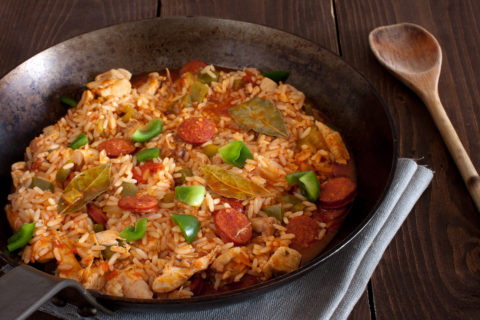
Bennachin. French Quarter: 1212 Royal. 504-522-1230.
This is among the 500 best dishes in New Orleans area restaurants. Click here for a list of the other 499. [divider type=""] July 21, 2017
July 21, 2017
Days Until. . .
Satchmo Summer Fest 15
Today's Flavor
 Today is allegedly National Junk Food Day, but does that really make it stand out from all the other days on the calendar? We all get hooked by some kind of junk food at some time in our lives. The makers of the stuff know exactly what flavors, colors, and textures address subconscious desires. We're hard-wired to like sweet food, for example. And high-fat foods. It doesn't care what kind of sweet or fat it is. So we get trans-fat emulsified with high-fructose corn syrup. Pure garbage.
Today is allegedly National Junk Food Day, but does that really make it stand out from all the other days on the calendar? We all get hooked by some kind of junk food at some time in our lives. The makers of the stuff know exactly what flavors, colors, and textures address subconscious desires. We're hard-wired to like sweet food, for example. And high-fat foods. It doesn't care what kind of sweet or fat it is. So we get trans-fat emulsified with high-fructose corn syrup. Pure garbage.
 And we don't just like it. We develop attachments to certain junk foods, and feel we must be loyal to them. Some people will get mad when I say that this applies to doughnuts. Sno-balls. Candy bars. Fried pies (i.e., Hubig's). Most hamburgers and most fries. Rationally, we shouldn't eat any of that stuff. It's not good for you. Nor does it even taste good--not as good as food made with good ingredients in careful ways. A little bit of good eats gives a lot more satisfaction than a lot of junk.
And we don't just like it. We develop attachments to certain junk foods, and feel we must be loyal to them. Some people will get mad when I say that this applies to doughnuts. Sno-balls. Candy bars. Fried pies (i.e., Hubig's). Most hamburgers and most fries. Rationally, we shouldn't eat any of that stuff. It's not good for you. Nor does it even taste good--not as good as food made with good ingredients in careful ways. A little bit of good eats gives a lot more satisfaction than a lot of junk.
Gourmet Gazetteer
Winesap is a farming country crossroads in hilly central Kentucky. It's eighty-four miles south of Louisville. The place is certainly named for the apples that grow in that part of the country. It's not far away from the Green River--a major tributary of the Ohio--and Mammoth Cave National Park. Beautiful countryside around there. The nearest restaurant to Winesap is Cub Run Cave, five miles west.
Ruined Picnics Through History
On this date in 1861, the first major battle of the Civil War was fought at Manassas Junction. It's also known as the Battle of Bull Run Creek. So certain were the Unionists that the U.S. Army would rout the Confederates that people actually dressed up and went to the battle site with picnic lunches to watch it. In fact, it was a decisive victory for the South, and gave General Thomas "Stonewall" Jackson his nickname.
Edible Dictionary
entomatada, [en-TOE-mah-TAH-dah], Spanish, n.--A soft tortilla, usually made of corn masa meal, rolled up around a filling of cheeses, chicken, shredded or dry beef or pork. The meats are combined with a light sauces of tomatoes, hence the name. It's the same idea as an enchilada, but with tomatoes instead of chili. As with enchiladas, usually two or three make up a plate.
Food In Literature
Francis Parkinson Keyes (pronounced "kize") was born today in 1885. She wrote, among many other things, Dinner At Antoine's. As a result of that book's popularity, New York food writer Lucius Beebe suggested to the Brennans that they create Breakfast at Brennan's, which they did. Back to Keyes: the house at the corner of Chartres and Ursulines is named for her. Ernest Hemingway, whose books always include lots of eating and drinking (because he enjoyed both himself), was born today in 1899. Indeed, in a recent re-reading of A Farewell To Arms, I was struck by the sheer quantity of booze the characters ingested. I couldn't have kept up with them.
Music To Eat At Little Tables By
One of my favorite girl singers, Kay Starr, was born today in 1922. She was a stunning woman with a powerful voice--a real belter with a jazzy, original style and a great vibrato. She had a bunch of big hits in the late 1940s and early 1950s, but didn't cross over into the rock era. She's still singing, I think. . . ¶ I wonder if she's ever confused with Kenneth Starr, who wasted a lot of time and money going after Bill Clinton in the 1990s. It's also his birthday today, in 1946. He doesn't sing nearly as well.
Food Around The World
This is the national holiday of Belgium, commemorating the 1831 crowning of that country's first king, Leopold of Saxe-Coburg. Throughout history, Belgians have joked with a sigh of resignation about their having been conquered and run over by just about every neighboring country, both before and after their independence. In 1831, they rose up against their Dutch rulers, and for a change most of its other neighbors--notably France--were on its side.
 From a culinary perspective, Belgium is the most underrated country in Europe. It's restaurants are mostly French in style, although the Flemish (Dutch) influence makes it distinctive. Not only is Brussels full of great eateries, but other towns--including the smallest ones--show off marvelous dining possibilities.
From a culinary perspective, Belgium is the most underrated country in Europe. It's restaurants are mostly French in style, although the Flemish (Dutch) influence makes it distinctive. Not only is Brussels full of great eateries, but other towns--including the smallest ones--show off marvelous dining possibilities.
The Saints
This is the feast day of St. Victor of Marseilles. He is one of the patron saints of flour millers. He's also the patron of cabinetmakers, and where would our kitchens be without them?
Food Namesakes
Barry "The Bean" Whitwam, one of the original members of Herman's Hermits, was born today in 1946. I think he's still in the band (which is still performing). . . Sam Bass, a train robber in the 1870s, was born today in 1851. . . Taco Ockerse, a Dutch singer and stage actor, was born in Indonesia today in 1955. He usually goes by just his first name.
Words To Eat By
The key dietary messages are stunningly simple: Eat less, move more, eat more fruits and vegetables, and don't eat too much junk food. It's no more complicated than that."--Marion Nestle, author of the book What To Eat.
Words To Drink By
"Always do sober what you said you'd do drunk. That will teach you to keep your mouth shut."--Ernest Hemingway, born today in 1899.[divider type=""]

Do Nice Restaurants Finish Last?
Have you ever noticed how many of the hottest restaurants seem to expect you to follow their rules? Why are the places who are nicest to their customers often regarded as unhip?Click here for the cartoon.
[divider type=""] #### Friday, July 14, 2017. Daniel Bonnot Visits For the First Time in Years. Dinner at Brigtsen's.
The contenders for the title of Best Native French Chef, With Accent And All, New Orleans Limited, are as follows:
Daniel Bonnot
Gerard Crozier
Roland Huet
Rene Bajeux
Claude Aubert
Of these, only two are still alive, and only one is still cooking. Daniel Bonnot is the one not in a restaurant, and he says that he does not plan to return to that real work ever again. Since he landed in New Orleans in 1970 to build out the first menu of Louis XVI, he has cheffed his own places three times: Chez Daniel (on Metairie Road), 701 (where Herbsaint is now) and Tour Eiffel (across from the Pontchartrain. After those acts ended, he had a wonderful gig in France, where for years he gave cooking and immersion programs in a chateau for a number of years.
In other words, it has been a nice life for Daniel, as even he admits. But that still doesn't mean that he's any more eager to get back to work.
He shared all these outlooks and then some during a visit on the radio show today. Daniel is a bon vivant as much as he is anything else. Suffice it to say that we could have talked for hours. Daniel is one of the few people who has been omnipresent throughout my career as a food writer, and the subject of many thousands of my words. If I ever start on a memoir, he'd be near the front of it.
Daniel went off to some event or other. My dining plans fell through when the radio show ended. After taking a nap in my chair (and explaining to colleague at the radio station how I do that) I headed up Magazine Street, knowing full well that nothing will inspire me. When I reached the Riverbend area, I mentally took inventory of the nearby restaurants. We are getting into the slow season for eateries, I mused. I wondered what my luck would be like in a long shot.
[caption id="attachment_55349" align="alignleft" width="133"]
Friday, July 14, 2017. Daniel Bonnot Visits For the First Time in Years. Dinner at Brigtsen's.
The contenders for the title of Best Native French Chef, With Accent And All, New Orleans Limited, are as follows:
Daniel Bonnot
Gerard Crozier
Roland Huet
Rene Bajeux
Claude Aubert
Of these, only two are still alive, and only one is still cooking. Daniel Bonnot is the one not in a restaurant, and he says that he does not plan to return to that real work ever again. Since he landed in New Orleans in 1970 to build out the first menu of Louis XVI, he has cheffed his own places three times: Chez Daniel (on Metairie Road), 701 (where Herbsaint is now) and Tour Eiffel (across from the Pontchartrain. After those acts ended, he had a wonderful gig in France, where for years he gave cooking and immersion programs in a chateau for a number of years.
In other words, it has been a nice life for Daniel, as even he admits. But that still doesn't mean that he's any more eager to get back to work.
He shared all these outlooks and then some during a visit on the radio show today. Daniel is a bon vivant as much as he is anything else. Suffice it to say that we could have talked for hours. Daniel is one of the few people who has been omnipresent throughout my career as a food writer, and the subject of many thousands of my words. If I ever start on a memoir, he'd be near the front of it.
Daniel went off to some event or other. My dining plans fell through when the radio show ended. After taking a nap in my chair (and explaining to colleague at the radio station how I do that) I headed up Magazine Street, knowing full well that nothing will inspire me. When I reached the Riverbend area, I mentally took inventory of the nearby restaurants. We are getting into the slow season for eateries, I mused. I wondered what my luck would be like in a long shot.
[caption id="attachment_55349" align="alignleft" width="133"] The best table at Brigtsen's, some say.[/caption]
Brigtsen's is so well known--not merely to locals, but to visitors to our city from all over the country--that it's not a place I'd ordinarily attempt without a reservation. But tonight there was magic. A table was emptying as I arrived, and the next occupants were late. Marna Brigtsen--who manages the dining room as if it were in her own home and you were a lifetime friend--had the perfect table for me, in the corner of the front room. "Best table in the house!" Marna said.
Also advantageous at this table were three others whose occupants wanted to talk with me about the usual thing. In an unanimous vote these neighbors and I agreed that if eating delicious food is the goal, this is the arena to play in.
The server gave me the rundown of today's offerings. A bisque made with chanterelle mushrooms kicked it off. What a wonderful delicacy that is--but no surprise from Frank, who has a thing for bisques and turns them out brilliantly.
[caption id="attachment_55347" align="alignnone" width="480"]
The best table at Brigtsen's, some say.[/caption]
Brigtsen's is so well known--not merely to locals, but to visitors to our city from all over the country--that it's not a place I'd ordinarily attempt without a reservation. But tonight there was magic. A table was emptying as I arrived, and the next occupants were late. Marna Brigtsen--who manages the dining room as if it were in her own home and you were a lifetime friend--had the perfect table for me, in the corner of the front room. "Best table in the house!" Marna said.
Also advantageous at this table were three others whose occupants wanted to talk with me about the usual thing. In an unanimous vote these neighbors and I agreed that if eating delicious food is the goal, this is the arena to play in.
The server gave me the rundown of today's offerings. A bisque made with chanterelle mushrooms kicked it off. What a wonderful delicacy that is--but no surprise from Frank, who has a thing for bisques and turns them out brilliantly.
[caption id="attachment_55347" align="alignnone" width="480"]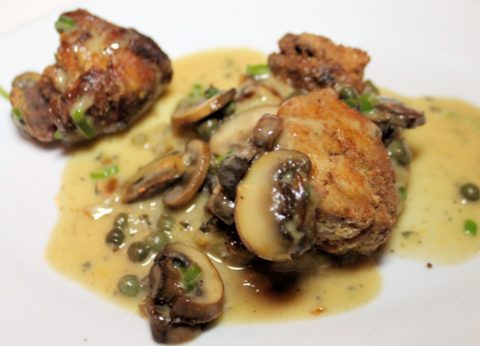 Veal sweetbreads @ Brigtsen's. [/caption]
I followed that with a rustic scattering of seared veal sweetbreads. That was the peak of the evening, prepared without sauce (maybe there was a glaze) and sliced just the right size for the rich morsels. I can't recall whether I've had that variety meat at Brigtsen's before, but at this moment I can't think of a better serving.
Nor could I recall having had a steak at Brigtsen's in a long time. (That one was blackened prime ribs, decades ago.) The sauce was composed of demi-glace in a marchand de vin sauce with a scattering of tasso. Everything about this plate stood up.
[caption id="attachment_55348" align="alignnone" width="480"]
Veal sweetbreads @ Brigtsen's. [/caption]
I followed that with a rustic scattering of seared veal sweetbreads. That was the peak of the evening, prepared without sauce (maybe there was a glaze) and sliced just the right size for the rich morsels. I can't recall whether I've had that variety meat at Brigtsen's before, but at this moment I can't think of a better serving.
Nor could I recall having had a steak at Brigtsen's in a long time. (That one was blackened prime ribs, decades ago.) The sauce was composed of demi-glace in a marchand de vin sauce with a scattering of tasso. Everything about this plate stood up.
[caption id="attachment_55348" align="alignnone" width="480"]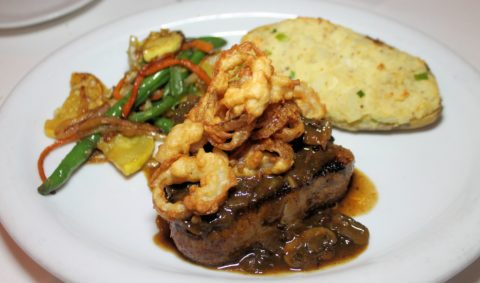 Filet mignon with marchand de vin sauce and the tiniest onion rings in town. [/caption]
The dessert was distinctive. It looked like a standard creme brulee, but it had two differences: 1) The custard was very light, almost flowing; and b) There was no bruleed sugar across the top. Maybe it sank to the bottom, which it could have. Whatever else could be said, it was lovely.
I think I'll make a list of restaurants that are so good that it's a shame I don't patronize them often. The reason in this case (and others) is that Brigtsen's is so consistent and excellent that I don't have to check it often. I could have written everything I just wrote five years ago, without changes beyond a few details. I think I'll stop in more often before the summer is out.
Riverbend: 723 Dante. 504-861-7610.
[divider type=""]
Filet mignon with marchand de vin sauce and the tiniest onion rings in town. [/caption]
The dessert was distinctive. It looked like a standard creme brulee, but it had two differences: 1) The custard was very light, almost flowing; and b) There was no bruleed sugar across the top. Maybe it sank to the bottom, which it could have. Whatever else could be said, it was lovely.
I think I'll make a list of restaurants that are so good that it's a shame I don't patronize them often. The reason in this case (and others) is that Brigtsen's is so consistent and excellent that I don't have to check it often. I could have written everything I just wrote five years ago, without changes beyond a few details. I think I'll stop in more often before the summer is out.
Riverbend: 723 Dante. 504-861-7610.
[divider type=""]

Chef Goffredo's Crabmeat Ravioli
La Riviera was among the best Italian restaurants ever to open in New Orleans. Chef Goffredo Fraccaro created it in 1972 after a few years cheffing a too-grand, unsuccessful Italian restaurant in the French Quarter. His new place was much more ambitious than most local Italian places, and once people got used to the idea of eating an Italian dinner that might not include red sauce and anise-flavored sausage, it became a long-running favorite. It lasted until Hurricane Katrina, after which Goffredo--then in his eighties--retired. This dish was his most famous, and triggered imitators all over town. It won the 1980 International Crabmeat Olympics in San Francisco. For most of Goffredo's customers, a dinner at La Riviera wouldn't have been complete without a starter of this fantastic dish. It's best made with homemade pasta dough, which requires a pasta machine. The Atlas machine is the best--an inexpensive, manual gizmo that rolls out pasta to the ideal thinness. You could do it with a roller by hand, but not as well as the machine does. The pasta dough recipe here doesn't use eggs--Goffredo never did for this, saying the lack of eggs made the pasta lighter. You could buy fresh pasta sheets at the supermarket if you're not inclined to make your own. One thing you will need is a ravioli form. It's inexpensive, from a restaurant supply or cookware stores. It makes the assembly much easier and keeps the ravioli size uniform, which makes the final boiling more exact. [caption id="attachment_48332" align="alignnone" width="200"]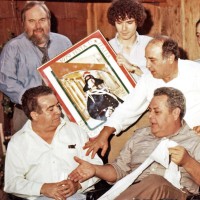 Lunch with three of New Orleans's best chefs in 1970s.Clockwise from bottom left: Goffredo Fraccaro, Phil Johnson, Frank Levy, Warren Leruth, Chris Kerageorgiou.[/caption]
Lunch with three of New Orleans's best chefs in 1970s.Clockwise from bottom left: Goffredo Fraccaro, Phil Johnson, Frank Levy, Warren Leruth, Chris Kerageorgiou.[/caption]
- Pasta dough:
- 1 cup semolina flour
- 1 cup all-purpose flour
- 1 tsp. extra-virgin olive oil
- 1 tsp. clarified butter
- Crabmeat stuffing:
- 1/2 cup whipping cream
- 6 Tbs. softened butter
- 1/2 tsp. salt
- 1/4 tsp. white pepper
- 1 lb. lump or white crabmeat
- 1/4 cup very thinly snipped green onion, tender green parts only
- 1/2 cup cracker crumbs (from unsalted crackers, ground fine in a food processor)
- 1/4 cup finely (and freshly) grated parmesan cheese
- Sauce:
- 1 cup whipping cream
- 1/4 cup butter
- 1/4 tsp. salt
- Pinch of cayenne
- 1/8 tsp. white pepper
- 1/2 cup grated parmesan cheese
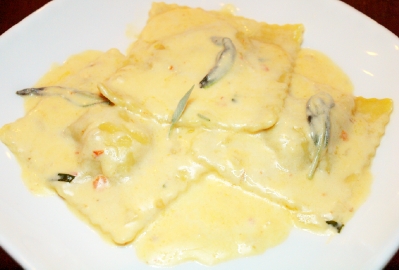 1. The easiest way to make the pasta dough is to use a big mixer with a dough hook, but it can also be made by hand. Combine all the pasta ingredients in a bowl and stir to blend. Add 1/2 cup of water and stir until all the flour is wet. If necessary, add no more than one Tbs. more water.
2. If using a mixer, mix the dough using the dough hook until it's uniformly smooth and damp. It should not be even a little sticky. If making the dough by hand, knead the dough on a clean countertop until smooth. Let the dough rest for about an hour.
3. Pull off a piece of dough about the size of a tennis ball. Run it through the pasta machine a couple of times at about the #6 thickness. Then go down to #3 for a couple of passes, and finally down to #2 once followed by one pass at #1--the thinnest. Dust the rolled pasta sheets with all-purpose flour and set aside, covered with a clean, damp cloth. Repeat until all the pasta is rolled. Extra pasta can be separated with plastic wrap, packed in a food storage bag, and either refrigerated or frozen.
4. To make the sauce, bring the whipping cream to a simmer in a small saucepan. Reduce it by about a third. Keep an eye on that pan! Cream can foam up like crazy!
5. Reserve a tablespoon of the butter, and whisk the rest into the reduced cream. Remove the pan from the heat and add the crabmeat. Stir very gently to mix the crabmeat with the cream sauce.
6. Heat the reserved tablespoon of butter in a medium skillet over medium-low heat until the butter bubbles. Add the green onions and cook until limp. Remove from the heat.
7. Add the crabmeat mixture, the cracker crumbs, and parmesan cheese to the skillet, and stir lightly with a spoon until all the ingredients are evenly distributed.
8. Move the crabmeat mixture into a bowl and refrigerate until distinctly cool.
9. To make the ravioli, place the bottom (metal) part of the ravioli form over a sheet of pasta, and with a knife cut all the way around. Make twelve sheets this way.
10. Turn over the bottom ravioli form, and fit a sheet of pasta into it. Use the top (plastic) part to push the pasta sheet down to form pockets. Put about a tablespoon of the crabmeat mixture into each pocket. Brush the exposed pasta lightly with water.
11. Place another sheet of pasta over the first one. Turn the plastic part of the form over (depressions pointing down), and use it to press the top pasta sheet onto the bottom. Push down hard.
12. With a knife, slice the individual ravioli apart. Cover with a clean damp cloth while finishing the rest of the ravioli.
13. To make the sauce, bring the whipping cream to a simmer in a saucepan and reduce by half. Make sure it doesn't foam over. When reduced, add the butter, salt, cayenne, and white pepper. Whisk to combine and remove from heat, but keep warm.
14. Bring a large pot of salted water to a rolling boil. Drop in the ravioli and cook for five minutes. Drain, then toss with the cream sauce. Serve with grated parmesan cheese.
Serves 12 appetizers or six entrees.
[divider type=""]
1. The easiest way to make the pasta dough is to use a big mixer with a dough hook, but it can also be made by hand. Combine all the pasta ingredients in a bowl and stir to blend. Add 1/2 cup of water and stir until all the flour is wet. If necessary, add no more than one Tbs. more water.
2. If using a mixer, mix the dough using the dough hook until it's uniformly smooth and damp. It should not be even a little sticky. If making the dough by hand, knead the dough on a clean countertop until smooth. Let the dough rest for about an hour.
3. Pull off a piece of dough about the size of a tennis ball. Run it through the pasta machine a couple of times at about the #6 thickness. Then go down to #3 for a couple of passes, and finally down to #2 once followed by one pass at #1--the thinnest. Dust the rolled pasta sheets with all-purpose flour and set aside, covered with a clean, damp cloth. Repeat until all the pasta is rolled. Extra pasta can be separated with plastic wrap, packed in a food storage bag, and either refrigerated or frozen.
4. To make the sauce, bring the whipping cream to a simmer in a small saucepan. Reduce it by about a third. Keep an eye on that pan! Cream can foam up like crazy!
5. Reserve a tablespoon of the butter, and whisk the rest into the reduced cream. Remove the pan from the heat and add the crabmeat. Stir very gently to mix the crabmeat with the cream sauce.
6. Heat the reserved tablespoon of butter in a medium skillet over medium-low heat until the butter bubbles. Add the green onions and cook until limp. Remove from the heat.
7. Add the crabmeat mixture, the cracker crumbs, and parmesan cheese to the skillet, and stir lightly with a spoon until all the ingredients are evenly distributed.
8. Move the crabmeat mixture into a bowl and refrigerate until distinctly cool.
9. To make the ravioli, place the bottom (metal) part of the ravioli form over a sheet of pasta, and with a knife cut all the way around. Make twelve sheets this way.
10. Turn over the bottom ravioli form, and fit a sheet of pasta into it. Use the top (plastic) part to push the pasta sheet down to form pockets. Put about a tablespoon of the crabmeat mixture into each pocket. Brush the exposed pasta lightly with water.
11. Place another sheet of pasta over the first one. Turn the plastic part of the form over (depressions pointing down), and use it to press the top pasta sheet onto the bottom. Push down hard.
12. With a knife, slice the individual ravioli apart. Cover with a clean damp cloth while finishing the rest of the ravioli.
13. To make the sauce, bring the whipping cream to a simmer in a saucepan and reduce by half. Make sure it doesn't foam over. When reduced, add the butter, salt, cayenne, and white pepper. Whisk to combine and remove from heat, but keep warm.
14. Bring a large pot of salted water to a rolling boil. Drop in the ravioli and cook for five minutes. Drain, then toss with the cream sauce. Serve with grated parmesan cheese.
Serves 12 appetizers or six entrees.
[divider type=""]
 Lemon Ice Box Pie @ Clancy's
Lemon Ice Box Pie @ Clancy's
All of Clancy's desserts are understated and simple. No flaming, no spun sugar, hardly even any layers. This nice little tart is the restaurant's most talked-about ending course. Simple, but perfect: a lovely little pie with a rich custard and the ideal lemon component to balance off the sugar. Very good with a glass of Sauternes or Auslese.
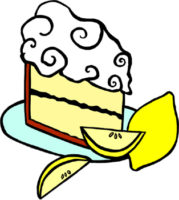
Clancy's. Uptown: 6100 Annunciation. 504-895-1111.
This is among the 500 best dishes in New Orleans area restaurants. Click here for a list of the other 499. [divider type=""] July 20, 2017
July 20, 2017
Days Until. . .
Satchmo Summer Fest 15
Food Calendar
 Today is National Creme Brulee Day. Creme brulee is an enriched version of caramel custard, with the caramel transferred from the bottom of the baking dish to the top, in the form of a crust of lightly browned sugar. That's the brulee part; the word means "burned." Sometimes it is. The texture of the crust varies greatly. Some makers have a granular topping; in other places, the sugar melts and then re-solidified with a glassy quality. If you encounter one of those, be careful. A shard of this crust cut the inside of my mouth badly once.
The creme brulee concept goes back to at least the 1600s in France. Originally, a white-hot poker pulled from the fire was used to brulee the top. The custard is made with cream instead of the milk used for caramel custard. That keeps it from setting completely. A well-made creme brulee will flow, if very thickly and slowly. The first New Orleans restaurant to serve creme brulee in modern times was Arnaud's. Now creme brulee has supplanted caramel custard in most of its former range.
Today is National Creme Brulee Day. Creme brulee is an enriched version of caramel custard, with the caramel transferred from the bottom of the baking dish to the top, in the form of a crust of lightly browned sugar. That's the brulee part; the word means "burned." Sometimes it is. The texture of the crust varies greatly. Some makers have a granular topping; in other places, the sugar melts and then re-solidified with a glassy quality. If you encounter one of those, be careful. A shard of this crust cut the inside of my mouth badly once.
The creme brulee concept goes back to at least the 1600s in France. Originally, a white-hot poker pulled from the fire was used to brulee the top. The custard is made with cream instead of the milk used for caramel custard. That keeps it from setting completely. A well-made creme brulee will flow, if very thickly and slowly. The first New Orleans restaurant to serve creme brulee in modern times was Arnaud's. Now creme brulee has supplanted caramel custard in most of its former range.
Looking Up
This is Moon Day, the day Neil Armstrong stepped onto the moon in 1969. A historic event of great importance but few repercussions. What do we do, foodwise? Eat a Moon Pie? The old Charlie's Delicatessen used to make a muffuletta-like sandwich called "The Moon," but Charlie's did not cross over the fold in our history made by Katrina.
Annals Of Oenophilia
Max Zander was born today in 1920. He was the longtime head of Heritage House, New Orleans' biggest wine wholesaler. Decades before fine wine made its way onto the tables of the mainstream local populace, Max was hosting wine classes, wine dinners and tastings, inspiring people to enhance their lives with good wine. He was accessible and likable, never displaying a hint of the snobbery that scares so many people away from wine. He was as quick to recommend affordable wines as the world's best. He knew about it all, and shared his knowledge, sophistication, love of life, and friendship with anyone who wanted it. He passed away in 2009, leaving behind a legacy of wine appreciation matched by nobody else in our city.
Annals Of Cheese
 On this date in 1801, a thankful Elisha Brown Jr., a farmer, made a ball of cheese weighing nearly a ton. He delivered it to Thomas Jefferson. The president found it overripe. . . More important to us today is what Jesse Williams did at his farm in Rome, New York on this date in 1851. He created the first American cheese factory. Its cheese was uniform in texture, color, and flavor, very much unlike Elisha Brown's cheeseball, which was made (as most large cheeses were) by pressing many small cheeses together.
On this date in 1801, a thankful Elisha Brown Jr., a farmer, made a ball of cheese weighing nearly a ton. He delivered it to Thomas Jefferson. The president found it overripe. . . More important to us today is what Jesse Williams did at his farm in Rome, New York on this date in 1851. He created the first American cheese factory. Its cheese was uniform in texture, color, and flavor, very much unlike Elisha Brown's cheeseball, which was made (as most large cheeses were) by pressing many small cheeses together.
Roots Of Our Cuisine
Yugoslavia was born today in 1917. The Pact of Corfu among the Slovenes, Croatians, and Serbs united their countries into one. It didn't work in the long term, and now each of those groups has its own country again. During much of the history of Drago's restaurant, it claimed to serve Yugoslavian food. Now it doesn't, but it does claim Croatian roots.
Edible Dictionary
speckled trout, n.--The common name used along the Gulf coast for what the fish experts call "spotted seatrout." It's not a member of the trout family (true trout are freshwater fish in the salmon family), but are related to drumfish. (They actually do make a drumming sound when they're spawning.) Most specimens are between one and three pounds, although they can grow larger. Its flesh is just off white and very flaky. It is considered a prize catch for eating by fishermen. For over a century it was the favorite fish in New Orleans white-tablecloth restaurants. Overfishing and the resulting over-zealous laws restricted the commercial catch so much that speckled trout has become a rarity in New Orleans. The greatest availability on menus is in late fall into early spring.
Gourmet Gazetteer
Soup Creek runs into a reservoir in one of the uppermost stretches of the Missouri River nineteen miles northeast of Helena, Montana. It rises on the south slope of Hogback Mountain at 7000 feet. Then its water travels twenty miles, dropping 3500 feet, before entering the Missouri to begin its long journey to New Orleans. It's a seven-mile hike from the end of Soup Creek to a place that can serve a bowl of soup: the Red Fix Inn, in the suburbs of Helena.
Food Namesakes
Paul Cook, the drummer of the Sex Pistols, was born today in 1956. . . .The Champagne Lady, Jo Ann Campbell, who appeared on most of Lawrence Welk's TV shows, was born today in 1938. . . American novelist Thomas Berger opened his first page today in 1924. . . .German actor Kurt Raab sprouted today in 1941. (Raab is another name for the vegetable broccoli di rape.)
Words To Eat By
"Banish the onion from the kitchen and the pleasure flies with it. Its presence lends color and enchantment to the most modest dish; its absence reduces the rarest delicacy to hopeless insipidity, and dinner to despair."--Elizabeth Robbins Pennell, American writer, 1855-1936.
"The relationship between a Russian and a bottle of vodka is almost mystical."--Richard Owen, British zoologist, born today in 1804.
[divider type=""]
Click here for the cartoon.Words To Drink By

Adjusting To The Taste Of The Chef.
His language may not mean the same thing to you as it does to him.
 Thursday, July 13, 2017. Public Service, Three Days Old. Mary Ann and I were to have dinner tonight, with my choice of venues. But as the radio show went off, she called back to rescind that offer, because she and Mary Leigh were already seated in the bar of a three-day-old restaurant.
Thursday, July 13, 2017. Public Service, Three Days Old. Mary Ann and I were to have dinner tonight, with my choice of venues. But as the radio show went off, she called back to rescind that offer, because she and Mary Leigh were already seated in the bar of a three-day-old restaurant.
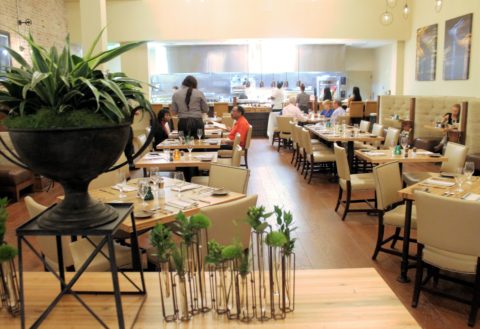 It's called Public Service. Clever name, that--taken from the common moniker of New Orleans Public Service Inc., the company that owned the electric, gas, and transit services in New Orleans for a century.
NOPSI was its nickname. Its headquarters were a big building on Baronne Street where everyone who lived in New Orleans proper would turn up sooner or later. You would pay your electricity and gas bills there, usually after a long wait in line. You'd buy bus tokens. And you'd find a rack of pamphlets on every imaginable subject having to do with home life in New Orleans. Among these pamphlets were hundreds of recipes that were held in such high esteem that Energy--which took over NOPSI some decades ago--compiled a few hundred of the recipes into a book compiled and sold by the United Way as a fund raiser.
The old Baronne Street building followed the trend of recent years in which former office buildings in the CBD have become hotels, condominiums, and apartments. The old NOPSI building is now the NOPSI Hotel. A former manhole cover in front of the entrance shows the old NOPSI logo. And the restaurant is called Public Service.
[caption id="attachment_55334" align="alignnone" width="480"]
It's called Public Service. Clever name, that--taken from the common moniker of New Orleans Public Service Inc., the company that owned the electric, gas, and transit services in New Orleans for a century.
NOPSI was its nickname. Its headquarters were a big building on Baronne Street where everyone who lived in New Orleans proper would turn up sooner or later. You would pay your electricity and gas bills there, usually after a long wait in line. You'd buy bus tokens. And you'd find a rack of pamphlets on every imaginable subject having to do with home life in New Orleans. Among these pamphlets were hundreds of recipes that were held in such high esteem that Energy--which took over NOPSI some decades ago--compiled a few hundred of the recipes into a book compiled and sold by the United Way as a fund raiser.
The old Baronne Street building followed the trend of recent years in which former office buildings in the CBD have become hotels, condominiums, and apartments. The old NOPSI building is now the NOPSI Hotel. A former manhole cover in front of the entrance shows the old NOPSI logo. And the restaurant is called Public Service.
[caption id="attachment_55334" align="alignnone" width="480"]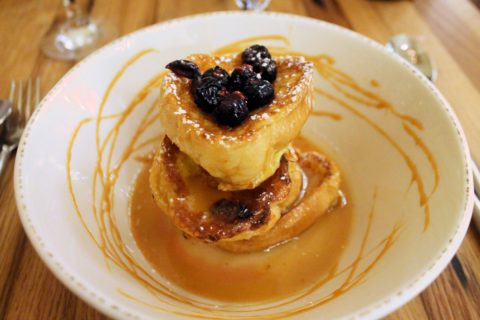 The bread pudding is good, but could pass as lost bread.[/caption]
When I arrived, the Marys were digging into an appetizer of black bean hummus. It was well disguised on the plate as a sort of plate coating, not the customary pile. Then came fried, cheese-sprinkled potatoes cut too big to fry properly. A souffle cup of seafood gumbo was disliked by everyone at the table. A filet mignon was reasonably good, but it was sprinkled with a seasoning so loaded with salt that I had to stop after only a bite. I had the vegetarian dish--pasta, mushrooms, a buttery sauce. I got it mainly because its name was Jaxson Tagliatelle--nearly that of my grandson Jackson. I thought this was the best dish of the night. The Marys gave that award to a chocolate pots de creme, one of their favorite things.
The bar was busy when we arrived. I had an Old Fashioned, which was well made but ungenerous, compared with the cocktails of a dozen other places in the neighborhood. If they want to get the local crowd, they need to top those glasses off.
The bread pudding is good, but could pass as lost bread.[/caption]
When I arrived, the Marys were digging into an appetizer of black bean hummus. It was well disguised on the plate as a sort of plate coating, not the customary pile. Then came fried, cheese-sprinkled potatoes cut too big to fry properly. A souffle cup of seafood gumbo was disliked by everyone at the table. A filet mignon was reasonably good, but it was sprinkled with a seasoning so loaded with salt that I had to stop after only a bite. I had the vegetarian dish--pasta, mushrooms, a buttery sauce. I got it mainly because its name was Jaxson Tagliatelle--nearly that of my grandson Jackson. I thought this was the best dish of the night. The Marys gave that award to a chocolate pots de creme, one of their favorite things.
The bar was busy when we arrived. I had an Old Fashioned, which was well made but ungenerous, compared with the cocktails of a dozen other places in the neighborhood. If they want to get the local crowd, they need to top those glasses off.
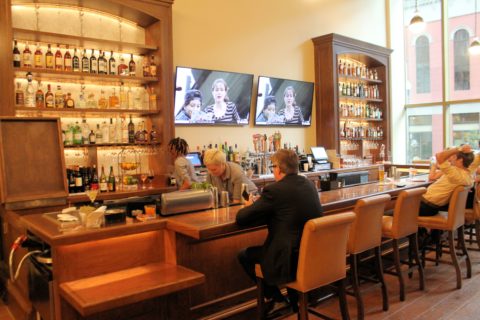 The general manager of the hotel visited our table, and offered to give us a tour of the hotel. MA was interested in this because the hotel met most of her standards for hotel excellence. She may have made a plan for the place before we even began the tour.
[caption id="attachment_55332" align="alignnone" width="480"]
The general manager of the hotel visited our table, and offered to give us a tour of the hotel. MA was interested in this because the hotel met most of her standards for hotel excellence. She may have made a plan for the place before we even began the tour.
[caption id="attachment_55332" align="alignnone" width="480"]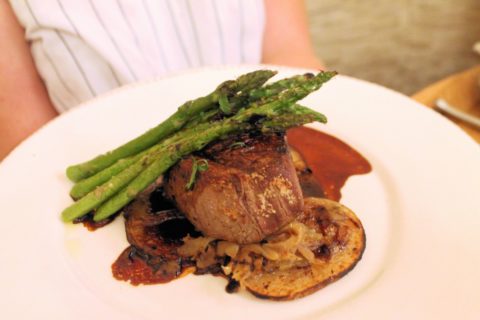 Filet @ Public Service.[/caption]
As part of our tour, we were brought down to the basement of the old building. There was a lot of new and old operational gere, of which was the most interesting was a series of thick-walled, tall safes. During most of its history, NOPSI's customers paid with cash. The cashiers carried a lot of currency, and had to be bled now and then--into the big vaults. Interesting.
At the end of the tours, the Marys were in agreement with my preference for waiting a few months before dining seriously in a restaurant. Public Service has much reworking in its food service ahead. But the Marys love the place.
Public Service. CBD: 311 Baronne St. 504-962-6527.
[divider type=""]
Filet @ Public Service.[/caption]
As part of our tour, we were brought down to the basement of the old building. There was a lot of new and old operational gere, of which was the most interesting was a series of thick-walled, tall safes. During most of its history, NOPSI's customers paid with cash. The cashiers carried a lot of currency, and had to be bled now and then--into the big vaults. Interesting.
At the end of the tours, the Marys were in agreement with my preference for waiting a few months before dining seriously in a restaurant. Public Service has much reworking in its food service ahead. But the Marys love the place.
Public Service. CBD: 311 Baronne St. 504-962-6527.
[divider type=""]

Pasta with White Beans and Bacon
In Italy, white beans are widely eaten in all sorts of ways, usually in the company of herbs, sometimes with meats on the fatty side. This is in the latter category, with a taste that's very similar to those of dishes in Northern Italy. But if you were to replace the pasta with rice, you'd have a classic neighborhood-cafe Creole lunch special.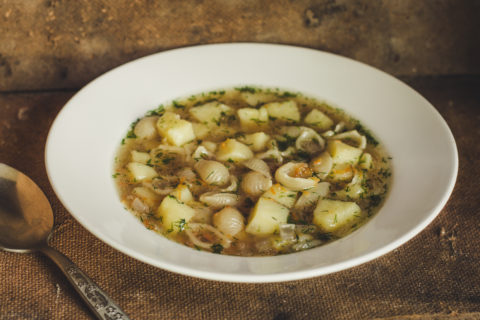
- 2 Tbs. bacon fat
- 1 Tbs. olive oil
- 1 Tbs. chopped garlic
- 1/2 cup sliced mushrooms
- 1/4 cup sliced green onions
- 1 roasted bell pepper, chopped
- 8 slices bacon, fried medium crisp, crumbled
- 1/4 cup chopped fresh basil
- 1/4 tsp. crushed red pepper
- 2 cups cooked white beans (leftovers are best)
- 2 cups chicken broth
- 8 oz. (precooked weight) cooked broad pasta, shells, or tubes
1. Heat the bacon fat and the olive oil together in a large skillet. In it saute the garlic, mushrooms, green onions, and roasted peppers until limp.
2. Stir in the bacon, basil, crushed red pepper, white beans and chicken broth and bring to a boil. Add the pasta and heat through. Taste and add salt and pepper as needed.
3. Serve in a soup bowl with a generous sprinkling of grated parmesan cheese and chopped parsley.
Serves four.
[divider type=""]
 Carnitas @ El Mesquite Mexican Grill
Carnitas @ El Mesquite Mexican Grill
Carnitas is roast pork cooked slowly until it's so dense that it's almost hard. In the process, the fat and cartilage in the meat brings the flavor of the lean (and it's all lean when it arrives) to a high pitch. It's identified more with Cuban cooking than Mexican, but that doesn't stop El Mesquite--the best of the West Bank's many Hispanic restaurants--from turning out a great version. On a related note, El Mesquite also serves mole poblano, the best Mexican dish of them all. [caption id="attachment_34649" align="alignnone" width="399"]
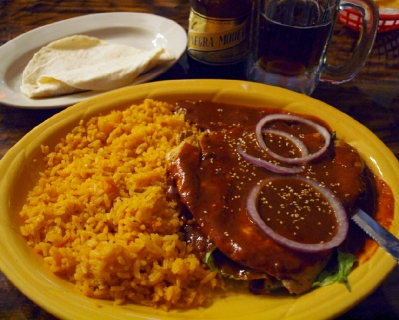 Chicken with mole and rice at El Mesquite Grill.[/caption]
Chicken with mole and rice at El Mesquite Grill.[/caption]
El Mesquite Mexican Grill. Gretna: 516 Gretna Blvd. 504-367-1022.
This is among the 500 best dishes in New Orleans area restaurants. Click here for a list of the other 499. [divider type=""] July 19, 2017
July 19, 2017
Days Until. . .
Satchmo Summer Fest 16
Restaurant Namesakes
 Today is the birthday, in 1834, of French Impressionist painter Edgar Degas. He lived for a few years on Esplanade Avenue here in New Orleans, in a house that's now used for catering special events. The excellent French bistro Cafe Degas--a few blocks toward City Park from his former home--is named for him. Eat there today in his honor.
Today is the birthday, in 1834, of French Impressionist painter Edgar Degas. He lived for a few years on Esplanade Avenue here in New Orleans, in a house that's now used for catering special events. The excellent French bistro Cafe Degas--a few blocks toward City Park from his former home--is named for him. Eat there today in his honor.
Edible Dictionary
pawpaw, n.--A fleshy, moderately sweet fruit that grows on small trees in the eastern half of the United States. It's about eight inches long and three inches wide. It's a member of a large family of tropical fruits, and probably gets its name because of confusion with the papaya. Its flavor is reminiscent of that of a banana, and because of that and its shape it has a lot of nicknames along the lines of "prairie banana." It's a berry, though, and juicier than a banana. You will probably never see it in a sort, because as soon as it's picked it starts not only to ripen but to ferment. They grow here and there around New Orleans but are not common.
Gourmet Gazetteer
Fudges Creek is both a town and a stream that runs through it in central West Virginia. The town is forty miles west of the state capital, Charleston. It's in hilly country with a good deal of coal mining. Some of the earliest oil wells were in the vicinity. (I hope neither of those gave the creek its name.) Until the real estate bust, many rural weekend homes were being built around there. Fudges Creek's water runs into Mud River en route to the Ohio and the Mississippi, which puts some of that fudge right here in New Orleans. The nearest restaurant to Fudges Creek is Sassy's, three miles away in Barboursville.
Food Holidays
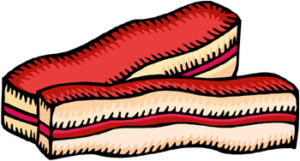 Today in the town of Dunmow, Essex, England, it's Flitch Day. Any married couple that can prove to the satisfaction of a mock jury that they have never wished that they were not married get a "flitch" of bacon--half a pork belly. The tradition dates back to 1104, and it still goes on every four years. Big event there.
Today in the town of Dunmow, Essex, England, it's Flitch Day. Any married couple that can prove to the satisfaction of a mock jury that they have never wished that they were not married get a "flitch" of bacon--half a pork belly. The tradition dates back to 1104, and it still goes on every four years. Big event there.
Deft Dining Rules #287 and #288
No amount of bacon is enough for your appetite.
Only an amount of bacon too small to satisfy your appetite constitutes healthy eating.
Food Calendar
It is National Daiquiri Day. The daiquiri has evolved from a good, slightly sour drink (rum and lime juice, shaken with ice and something sweet) to a frozen slush for adults, flavored with almost anything you can think of. Drive-through daiquiri stands have become a commonplace, against all conceivable logic. The answer to the question, "Where's the best daiquiri in town?" is "False." The daiquiri is named for a spot on the southern coast of Cuba, near Santiago. The drink is said to have been concocted there around 1905, after the American invasion of the island.
The Old Kitchen Sage Sez
I heard a joke about daiquiris from a dishwasher about thirty years ago. Seems that an otolaryngologist stopped in a certain bar near his clinic on the way home every afternoon, and was in the habit of ordering a daiquiri with some crushed pecans on top. One day the bartender ran out of pecans. Not wanting to disappoint the doctor, he went out to buy more, but saw that a hickory tree just outside had some ripe nuts. He picked them, toasted them, and grated them. When the physician took a sip at the drink the bartender made with those nuts, a big smile spread across his face. "This is the most delicious daiquiri I've ever had," he said. "What did you do differently?" The bartender smiled back and said, "Well, that's a hickory daiquiri, doc!"
Food Trademarks
Breyer's Ice Cream became a registered trademark today in 1921. Ah. . . a good excuse to eat a bowl of the stuff.
Food In Music
In 1963 on this date, the Essex had the Number One pop hit with Easier Said Than Done. I couldn't make out the lyrics when I first heard it. It sounded to me that they were singing, "It's easier. . . to eat your candied yak." I still think of eating candied yak every time I hear the song, even though I know better.
Worst Flavor Of The Day
Today in 2002, nineteen millions pounds of beef suspected of being contaminated with e. coli was recalled by ConAgra. And that's not candied yak.
Food Namesakes
Dr. Charles Mayo was born today in 1865. He and his brothers founded the Mayo Clinic. . . Lizzie Borden, who was accused by acquitted of applying forty whacks with an axe to her parents, was born today in 1860. . . French artist Polydore Roux began his life's canvas today in 1792. . . Former major-league pitcher Jimmy Gobble was born today in 1981.
Words To Eat By
"The difference between a rather average cook and a chef is that the chef is never really satisfied with what he is serving. He is constantly trying to achieve the high expectation he has set for himself. He is seeking to develop his palate and to enhance the skills of his palate through cooking, travel, and just being open."--Bradley Ogden, San Francisco restaurateur.
Words To Drink By
"An alcoholic is someone you don't like who drinks as much as you do."--Dylan Thomas.
[divider type=""]

House Rules Can Make A Good Restaurant annoying.
And every place has its peculiar ideas that customers are somehow supposed to know.Click here for the cartoon.
[divider type=""] #### Saturday, July 8, 2017. Impastato Cellars With Our Neighbor. A lady who raises horses and chickens near the Cool Water Ranch has become a closer friend in recent years by way of feeding our two dogs and three cats while we are out of town. We watch her menagerie when she's gone, so that should work out--but we're gone a lot more than she is. We have offered her cash, but she won't take it. She prefers being taken out to dinner at the likes of Keith Young's Steak House, Gallagher's Grill, and other first-class North Shore restaurants. That is better for us, too, giving us an excuse to eat in some of our favorite places.
It's time for one of those balancing acts tonight, as we make up for the two and a half weeks we were on the West Coast recently. The restaurant choice is is Impastato Cellars, the spinoff of Impastato's in Metairie, operated by Joe Impastato's wife and their daughter (who are both named Mica). Our neighbor liked the place a few months ago, when she was especially pleased by the barbecue shrimp and pasta at the Cellars.
[caption id="attachment_49097" align="alignleft" width="480"]
Saturday, July 8, 2017. Impastato Cellars With Our Neighbor. A lady who raises horses and chickens near the Cool Water Ranch has become a closer friend in recent years by way of feeding our two dogs and three cats while we are out of town. We watch her menagerie when she's gone, so that should work out--but we're gone a lot more than she is. We have offered her cash, but she won't take it. She prefers being taken out to dinner at the likes of Keith Young's Steak House, Gallagher's Grill, and other first-class North Shore restaurants. That is better for us, too, giving us an excuse to eat in some of our favorite places.
It's time for one of those balancing acts tonight, as we make up for the two and a half weeks we were on the West Coast recently. The restaurant choice is is Impastato Cellars, the spinoff of Impastato's in Metairie, operated by Joe Impastato's wife and their daughter (who are both named Mica). Our neighbor liked the place a few months ago, when she was especially pleased by the barbecue shrimp and pasta at the Cellars.
[caption id="attachment_49097" align="alignleft" width="480"]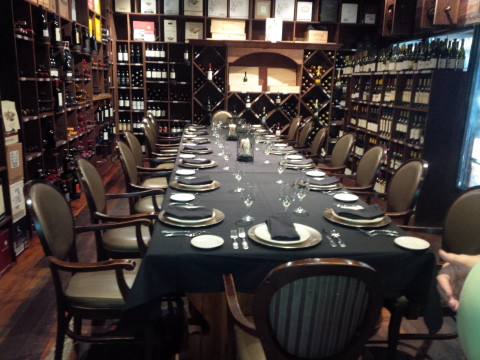 Cellar with table, Impastato Cellars.[/caption]
The menu is pretty much identical to that of the Metairie restaurant, including the $35 five-course dinner of hand every night. The only big change at the Cellars lately is that it's now open for Sunday brunch. But that's another story.
I hardly have to relate my menu, but I will. First course is the fettuccine and angel hair asciutta served together. Then artichoke soup, followed by the house salad. The entree is redfish Marianna, the namesake of Joe's mother. (And Mary Ann, for that matter). This is my favorite dish after the fettuccine at any Impastato's restaurant, but they made it different from the normal tonight. Instead of the butter-lemon-sherry sauce, it's a cream sauce. Not terrible by a long shot, but not what I had in mind. (See the book, "Expectations That Ruin Great Cooking," written but never quite finished.)
It's a fine dinner, and our neighbor says we can bring her to Impastato Cellars any time we want.
Impastato Cellars. Madisonville: 240 Highway 22 E. 985-845-4445.
Sunday, July 9, 2017. Mattina Bella Solo. Zea, Tomato Bisque, And Crab Cakes. The weather is cool, dry in the morning, and breezy. I undertake my scheme for pulling the lawn tractor out of the muddy hole where it's been for a week. To my astonishment, the whole scheme works perfectly. I jacked the tractor up about eighteen inches. I place wide, thick boards at right angles on top of the hole but under the wheel. I continue to enjoy the idea that I have built a three-foot-long bridge.
I lower the jack and remove it. The wheel sits right on the bridge, hardly sagging at all. I start the engine which, to my amazement, fires up right away. I put my foot on the gas gingerly. The tractor rolls forward. I take a small turn to the right. It rolls along the ground just as I'd hoped. The bridge stood up strong. I will never again worry about getting stuck in the mud, which has happened a total of about eight times over the twenty-five years we've lived here.
The eating scheme for the day has to work around my bridge project, singing at Mass, a two-hour radio show starting at one p.m., and the desk-work backlog. I wind up going to two of the standbys: late breakfast, solo, at Mattina Bella. Dinner with MA at Zea. Tomato-basil soup, a trio of crab cakes, and no dessert.
Monday, July 10, 2017. A New Legacy Kitchen, Due North. The local chain behind the New Orleans Hamburger and Seafood Company opened a new concept two or three years ago called Legacy Kitchen. The group has expanded to include four more manifestations of the idea. It's an oddity as chains go: every location has a secondary concept that alters the menu while at the same time hangs onto the signature dishes. All of these are more American than Creole, although that might escape one's notice. All the restaurants have fried chicken and waffles, for example. But even that is subject to change: all the Legacy Kitchens have a very good, very Cajun-Creole turtle soup, an oddity in such a place. The latest addition to the organization has the descriptive subtitle "Due North." The waitress told me that this is because its location is on the same parallel as the Legacy Kitchen in Metairie, so to get from one to the other in a balloon you wouldn't have to make any turns.
Clever idea, even if is a coincidence. Of more importance is that the Due North location has taken over the restaurant that has been N'Tini's for about the last ten years. N'Tini's owner Mark Benfatti is a silent partner with the Legacy guys, but he takes no hand in the menu. The restaurant also has undergone a modest renovation to make it more like the Legacy Kitchen.
Mary Ann and I tried to sample Due North a few days ago, when the Fourth of July closed a lot of restaurants for a few days. Today we followed through. A reminder of N'Tini's showed itself right away: the restaurant was freezing inside. But the servers were very quick to remedy that and any other gripe we might have had.
It was a light supper for both of us, with sandwiches as entrees. We began with char-broiled oysters. (What restaurant doesn't have that these days?) I have a crab and corn bisque as the second starter, followed by a fried oyster BLT that fell apart as I ate it, but it was easily enough eating. MA's bread enclosed barbecue brisket with a side of black beans. My dessert was a single scoop of ice cream, big enough for at least three people. I think they had scoped me out by then.
This new Legacy is within striking distance from the Cool Water Ranch. And MA likes both the food and the look of the place. (Lots of uncoated columns and concrete floors.) So we will probably come here more often than normal. We had tired of N'Tini's, which had been slipping for some time.
Legacy Kitchen "Due North." Mandeville: 2981 US 190. 985-626-5566.
Tuesday, July 11, 2017. Three Siblings. The thought of my middle sister's birthday yesterday had me on the phone inviting the other two to dinner tonight. Inconveniently, the birthday girl is celebrating something else in Seattle, where some other family lives. Tonight is the first time in awhile that I invited my big sister Judy to dinner. I am remiss in my absence, particularly since her her husband passed away last year. More often I dine with my baby sister Lynn, who is here tonight.
We are all at Impastato's. Mr. Joe was absent. I think he's in Sicily, his homeland. Billym the dining room boss, says it hasn't been very busy, but I know a lot of restaurants who would love to have the roomful of people at Impastato's tonight.
We eat and talk about the usual things. Fettuccine Alfredo and angel hair pasta with the house's spicy red sauce. Two soft-shell crabs are eaten, one of them by me. More creamy pasta follows. We update family news, of which there is not much. If this had been a few days later, I would have learned about a great aunt who died and requested that she be cremated with no ceremony. She said she wasn't a believer anymore. She was ninety-two, which sounds as if somebody with influence had liked her well enough.
Wednesday, July 12, 2017. Red's Chinese. A Second Look At Cavan. A few years ago, a Chinese restaurant with no sign except for a blank red square in front opened in the Bywater. It was the hit of the new restaurant season, and became difficult to penetrate. Today, owner Amy Mosberger came over with her bartender to the radio station to talk. We didn't unearth any facts other than what hipsters already know.
[caption id="attachment_51894" align="alignleft" width="480"]
Cellar with table, Impastato Cellars.[/caption]
The menu is pretty much identical to that of the Metairie restaurant, including the $35 five-course dinner of hand every night. The only big change at the Cellars lately is that it's now open for Sunday brunch. But that's another story.
I hardly have to relate my menu, but I will. First course is the fettuccine and angel hair asciutta served together. Then artichoke soup, followed by the house salad. The entree is redfish Marianna, the namesake of Joe's mother. (And Mary Ann, for that matter). This is my favorite dish after the fettuccine at any Impastato's restaurant, but they made it different from the normal tonight. Instead of the butter-lemon-sherry sauce, it's a cream sauce. Not terrible by a long shot, but not what I had in mind. (See the book, "Expectations That Ruin Great Cooking," written but never quite finished.)
It's a fine dinner, and our neighbor says we can bring her to Impastato Cellars any time we want.
Impastato Cellars. Madisonville: 240 Highway 22 E. 985-845-4445.
Sunday, July 9, 2017. Mattina Bella Solo. Zea, Tomato Bisque, And Crab Cakes. The weather is cool, dry in the morning, and breezy. I undertake my scheme for pulling the lawn tractor out of the muddy hole where it's been for a week. To my astonishment, the whole scheme works perfectly. I jacked the tractor up about eighteen inches. I place wide, thick boards at right angles on top of the hole but under the wheel. I continue to enjoy the idea that I have built a three-foot-long bridge.
I lower the jack and remove it. The wheel sits right on the bridge, hardly sagging at all. I start the engine which, to my amazement, fires up right away. I put my foot on the gas gingerly. The tractor rolls forward. I take a small turn to the right. It rolls along the ground just as I'd hoped. The bridge stood up strong. I will never again worry about getting stuck in the mud, which has happened a total of about eight times over the twenty-five years we've lived here.
The eating scheme for the day has to work around my bridge project, singing at Mass, a two-hour radio show starting at one p.m., and the desk-work backlog. I wind up going to two of the standbys: late breakfast, solo, at Mattina Bella. Dinner with MA at Zea. Tomato-basil soup, a trio of crab cakes, and no dessert.
Monday, July 10, 2017. A New Legacy Kitchen, Due North. The local chain behind the New Orleans Hamburger and Seafood Company opened a new concept two or three years ago called Legacy Kitchen. The group has expanded to include four more manifestations of the idea. It's an oddity as chains go: every location has a secondary concept that alters the menu while at the same time hangs onto the signature dishes. All of these are more American than Creole, although that might escape one's notice. All the restaurants have fried chicken and waffles, for example. But even that is subject to change: all the Legacy Kitchens have a very good, very Cajun-Creole turtle soup, an oddity in such a place. The latest addition to the organization has the descriptive subtitle "Due North." The waitress told me that this is because its location is on the same parallel as the Legacy Kitchen in Metairie, so to get from one to the other in a balloon you wouldn't have to make any turns.
Clever idea, even if is a coincidence. Of more importance is that the Due North location has taken over the restaurant that has been N'Tini's for about the last ten years. N'Tini's owner Mark Benfatti is a silent partner with the Legacy guys, but he takes no hand in the menu. The restaurant also has undergone a modest renovation to make it more like the Legacy Kitchen.
Mary Ann and I tried to sample Due North a few days ago, when the Fourth of July closed a lot of restaurants for a few days. Today we followed through. A reminder of N'Tini's showed itself right away: the restaurant was freezing inside. But the servers were very quick to remedy that and any other gripe we might have had.
It was a light supper for both of us, with sandwiches as entrees. We began with char-broiled oysters. (What restaurant doesn't have that these days?) I have a crab and corn bisque as the second starter, followed by a fried oyster BLT that fell apart as I ate it, but it was easily enough eating. MA's bread enclosed barbecue brisket with a side of black beans. My dessert was a single scoop of ice cream, big enough for at least three people. I think they had scoped me out by then.
This new Legacy is within striking distance from the Cool Water Ranch. And MA likes both the food and the look of the place. (Lots of uncoated columns and concrete floors.) So we will probably come here more often than normal. We had tired of N'Tini's, which had been slipping for some time.
Legacy Kitchen "Due North." Mandeville: 2981 US 190. 985-626-5566.
Tuesday, July 11, 2017. Three Siblings. The thought of my middle sister's birthday yesterday had me on the phone inviting the other two to dinner tonight. Inconveniently, the birthday girl is celebrating something else in Seattle, where some other family lives. Tonight is the first time in awhile that I invited my big sister Judy to dinner. I am remiss in my absence, particularly since her her husband passed away last year. More often I dine with my baby sister Lynn, who is here tonight.
We are all at Impastato's. Mr. Joe was absent. I think he's in Sicily, his homeland. Billym the dining room boss, says it hasn't been very busy, but I know a lot of restaurants who would love to have the roomful of people at Impastato's tonight.
We eat and talk about the usual things. Fettuccine Alfredo and angel hair pasta with the house's spicy red sauce. Two soft-shell crabs are eaten, one of them by me. More creamy pasta follows. We update family news, of which there is not much. If this had been a few days later, I would have learned about a great aunt who died and requested that she be cremated with no ceremony. She said she wasn't a believer anymore. She was ninety-two, which sounds as if somebody with influence had liked her well enough.
Wednesday, July 12, 2017. Red's Chinese. A Second Look At Cavan. A few years ago, a Chinese restaurant with no sign except for a blank red square in front opened in the Bywater. It was the hit of the new restaurant season, and became difficult to penetrate. Today, owner Amy Mosberger came over with her bartender to the radio station to talk. We didn't unearth any facts other than what hipsters already know.
[caption id="attachment_51894" align="alignleft" width="480"]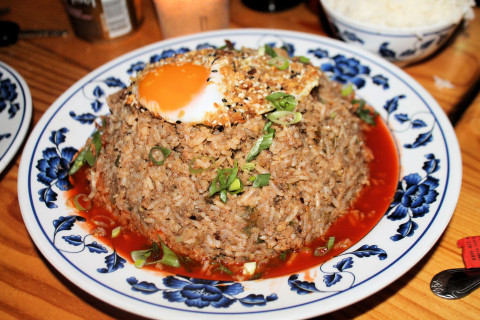 Dirty fried rice. Very peppery.[/caption]
The menu is short and an unpredictable mix of standard Chinese dishes with concoctions we've never heard of before. Pastrami from the wok? Now that's different. Open kitchen attracts a lot of comers, even though it's pretty hot in there. They tell me that some renovations around the back will allow some club-like activities. Karaoke, for example, late nights several nights a week. I might want to pop in. I already sang "Once In Love With Amy" to Amy Mosberger, and she didn't tell me that a 1940s-era crooner would not fit in so hip a place.
Red's Chinese. Bywater: 3048 St. Claude Ave. 504-304-6030.
Dirty fried rice. Very peppery.[/caption]
The menu is short and an unpredictable mix of standard Chinese dishes with concoctions we've never heard of before. Pastrami from the wok? Now that's different. Open kitchen attracts a lot of comers, even though it's pretty hot in there. They tell me that some renovations around the back will allow some club-like activities. Karaoke, for example, late nights several nights a week. I might want to pop in. I already sang "Once In Love With Amy" to Amy Mosberger, and she didn't tell me that a 1940s-era crooner would not fit in so hip a place.
Red's Chinese. Bywater: 3048 St. Claude Ave. 504-304-6030.

Chicken Newsham
You have to exercise more care than usual while making these, but it's worth it. The flavor is more satisfying than what you usually get from precious little appetizers made in layers. The hardest part is cutting and getting the first one out of the pan. This both looks and tastes Greek (the tzatziki sauce completes the effect). I named it for my late friend John "Chauncey" Newsham, who with his beautiful Greek wife and singer Julia Pappas operated the best Greek restaurant in New Orleans history--the Royal Oak Restaurant and Pub in Gretna. [caption id="attachment_55315" align="alignnone" width="480"]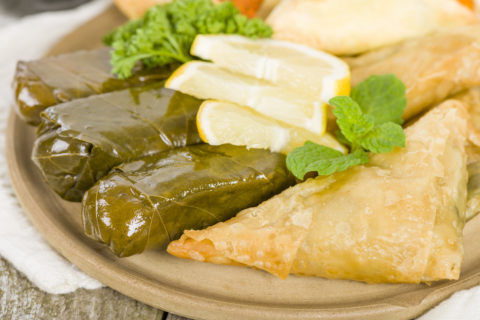 Chicken wrapped in phyllo, with stuffed grape leaves on the side. [/caption]
Chicken wrapped in phyllo, with stuffed grape leaves on the side. [/caption]
- 4 boneless, skinless chicken breasts
- 1 Tbs. olive oil
- 2 Tbs. flour
- 1 tsp. salt
- 1/2 tsp. pepper
- 1/2 tsp. dill
- 1 10-oz. bag fresh spinach
- 1 1/2 tsp. fresh chopped garlic
- 1 Tbs. lemon juice, strained
- 6 oz. kasseri cheese, thinly sliced
- Phyllo pastry leaves
- 1 1/2 cups tzatziki sauce (see recipe)
Preheat the oven to 350 degrees.
1. Rinse chicken and pat dry. With a meat mallet or the side of a heavy cleaver, pound chicken to the thickness of two stacked nickels.
2. Combine the flour, salt, pepper, and dill. Sprinkle (do not dredge) the chicken with the mixture.
3. Heat the olive oil until it shimmers in a skillet over medium-high heat. Sear the chicken until it lightly browns on both sides. Remove and keep warm.
4. Add 1/4 cup of water to the pan and bring to a boil. Whisk the bottom of the pan to dissolve the olive oil and little bits of browned chicken that may have stuck. Lower the heat to medium-low. Add the spinach, still dripping its wash water, and the garlic. Cook until the spinach softens, stirring carefully (avoid breaking the leaves). After cooking, drain the spinach well.
5. Coat the inside of a glass baking dish or casserole (about 9 x 5 x 2 inches) with olive oil. Place the thinnest chicken slices on the bottom. Top with slices of the cheese, then the spinach. Sprinkle a little of the lemon juice over this, then create another layer in the same way. Top that with the remaining lemon juice, and then with the phyllo pastry.
6. Put the baking dish into the 350-degree oven for 25 minutes, or until a knife poked into the center shows that the inside is hot. The pastry should also be browned by this time.
7. Allow to cool for five minutes. With a sharp knife, cut into squares or rectangles. The best utensil for extracting the first cube is a cake-frosting knife. Serve with two tablespoons of tzatziki sauce.
Serves twelve appetizers.
[divider type=""]
 Duck Tchoupitoulas @ Tommy's
Duck Tchoupitoulas @ Tommy's
In an era when most duck dishes consist of either the grilled breast or the confit of leg, the duck at Tommy's is unusual in being a half duck, still in one piece. It's roasted to a crisp skin and a tender interior and fills a plate grandly. Also on there is a slightly sweet, slightly peppery sauce sharpened with vinegar and raspberries. The whole thing is underlined with fresh spinach, and there's wild rice on the side. In other words, it's the kind of duck dish that was almost universal twenty years ago. It's great to know a few places that still roast duck that way. Tommy Andrade's excellent Creole and Italian restaurant is the best restaurant for this that I know. [caption id="attachment_26425" align="alignleft" width="500"]
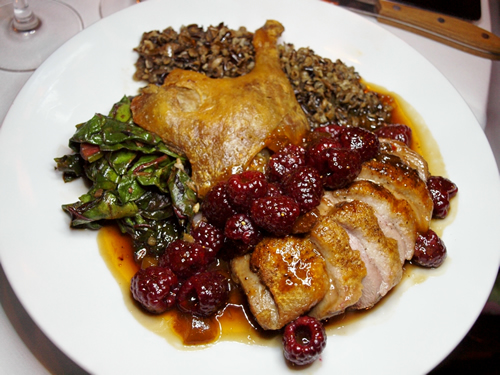 This is a variant of Tommy's duck served at Tomas Bistro, owned by the same people and cooked with a similar style, all right across the street.[/caption]
This is a variant of Tommy's duck served at Tomas Bistro, owned by the same people and cooked with a similar style, all right across the street.[/caption]
Tommy's. Warehouse District: 746 Tchoupitoulas. 504-581-1103.
This is among the 500 best dishes in New Orleans area restaurants. Click here for a list of the other 499. [divider type=""] July 18, 2017
July 18, 2017
Days Until. . .
Satchmo Summer Fest 17
Food On The Road
Today in 1936, the first Oscar Meyer Wienermobile was built in Chicago. It was a tremendous hit, especially with kids, and the hot dog-shaped cars (now more like RV's) have been on the road ever since. They appear in parades and at festivals, driven by young people just out of college. Crews of three or four of them drive one of the six Wienermobiles around the country. I'll bet that's a great experience. We've had the Wienermobile crews on my radio show many times in the past, and they're well-spoken representatives with a unifying talent for making awful puns about hot dogs. They come here to participate in Mardi Gras parades. In the New Orleans parades, they're required by the law against commercial displays in parades to cover up the company logo. But you'd have to be really out of it not to recognize the Wienermobile for what it is.
Food Calendar
It is National Caviar Day. The word "caviar" connotes luxury and gourmandise. The best caviar is among the most expensive and rarest foods in the world. Indeed, the king of caviars--from the endangered beluga sturgeon in the Caspian Sea--has become so rare that it lately has been banned from import into the United States. But not all caviar is expensive; not all of it is good.
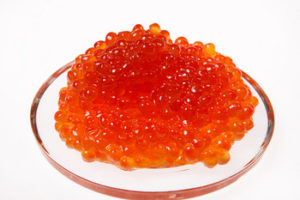 You know that caviar is fish eggs, but there's more to it than that. Eggs in fish are enclosed by a pouch, and held together by a membrane. Like every other part of a fish, roe is highly perishable. The challenge and expense in making caviar is to separate the eggs and to somehow keep them from spoiling. The latter job is usually accomplished through the addition of barely enough salt to do the job.
You probably eat more caviar than you think you do. Tobiko, for example, is the tiny caviar you get on sushi rolls. (It's from flying fish.) Around New Orleans, we eat a great deal caviar from bowfin (choupique, as we call the fish). If you dine in Greek restaurants you may enjoy a great appetizer spread called taramasalata, made with carp caviar.
I do hope it's possible to enjoy beluga caviar again someday. It's best all by itself--no onions, sour cream, capers, or anything. Maybe some little bread underneath. (I use small, non-sweet waffles for that.) But if the beluga sturgeon must be left alone to preserve the species, then we must not eat any more beluga caviar, no matter how delicious it is.
You know that caviar is fish eggs, but there's more to it than that. Eggs in fish are enclosed by a pouch, and held together by a membrane. Like every other part of a fish, roe is highly perishable. The challenge and expense in making caviar is to separate the eggs and to somehow keep them from spoiling. The latter job is usually accomplished through the addition of barely enough salt to do the job.
You probably eat more caviar than you think you do. Tobiko, for example, is the tiny caviar you get on sushi rolls. (It's from flying fish.) Around New Orleans, we eat a great deal caviar from bowfin (choupique, as we call the fish). If you dine in Greek restaurants you may enjoy a great appetizer spread called taramasalata, made with carp caviar.
I do hope it's possible to enjoy beluga caviar again someday. It's best all by itself--no onions, sour cream, capers, or anything. Maybe some little bread underneath. (I use small, non-sweet waffles for that.) But if the beluga sturgeon must be left alone to preserve the species, then we must not eat any more beluga caviar, no matter how delicious it is.
Deft Dining Rule #715
Eating a great deal of caviar can give you a buzz. It is not all coming from the Champagne that you're drinking with it.
Gourmet Gazetteer
Apple is a crossroads in cattle ranching and farming country in southeast Oklahoma. It's ten miles north of the Red River and the Texas state line. It's also right next to a growing reservoir called Lake Hugo, which spreads out from the banks of the Kiamichi River, a tributary of the Red. All the restaurants are ten miles away in Hugo, where there's a bunch of fast food plus the intriguing Angie's Circus City Diner.
Edible Dictionary
beluga caviar, n.--The most prized and expensive of all caviars, it is no longer legally available in the United States. It's the roe of the beluga sturgeon, which lives in the Caspian Sea and (in much smaller numbers) in the Black Sea and the Adriatic Sea. It is considered an endangered species, hence the American import ban. The Caspian Sea is the world's biggest lake, and straddles the border between Russia and Iran--both of which continue to harvest the 2000-pound fish for caviar. The eggs are the largest of all the sturgeon roes, with a metallic gray color and a magnificent flavor that is best appreciated with no garnishes of any kind. Maybe conservation efforts will make it possible to taste it again.
Food On The Air
 At five minutes after ten in the morning on this date in 1988, I threw a microphone switch and began a new daily radio talk program called The Food Show. It broadcast from the original 1925-vintage studios of WSMB, on the roof of the Maison Blanche Building. It's now the longest-running New Orleans radio show of any kind: same station, same host, same concept. I'd been on the radio since 1974 with a variety of shows on several stations, but this gig took on a life of its own. The Food Show has survived nine format changes for 1350 AM, four sets of owners, and a close brush with extinction of the station. The show is an anomaly in radio programming; not many reach their twentieth anniversary. I know of nothing comparable in any other city. And what other radio show shares a birthday with the Wienermobile?
At five minutes after ten in the morning on this date in 1988, I threw a microphone switch and began a new daily radio talk program called The Food Show. It broadcast from the original 1925-vintage studios of WSMB, on the roof of the Maison Blanche Building. It's now the longest-running New Orleans radio show of any kind: same station, same host, same concept. I'd been on the radio since 1974 with a variety of shows on several stations, but this gig took on a life of its own. The Food Show has survived nine format changes for 1350 AM, four sets of owners, and a close brush with extinction of the station. The show is an anomaly in radio programming; not many reach their twentieth anniversary. I know of nothing comparable in any other city. And what other radio show shares a birthday with the Wienermobile?
Food In Art Supplies
Today in 1994, Crayola began selling scented crayons. My two favorites are Garlic-Sardine and Huitlacoche.
Food And Drink Namesakes
David Cone pitched a perfect game on this date in 1999 for the Yankees. . . Soap actor Dolph Sweet experienced his first episode today in 1920. . . Syd Mead, an industrial designer who created cars and gizmos for movies, invented himself today in 1933. . . Canadian actor Carl Grain was harvested today in 1978.
Words To Eat By
 "Caviar is to dining what a sable coat is to a girl in evening dress."--Ludwig Bemelmans.
"Caviar is to dining what a sable coat is to a girl in evening dress."--Ludwig Bemelmans.
"There is more simplicity in the man who eats caviar on impulse than in the man who eats grape-nuts on principle."--G.K. Chesterton.
"There is, we feel, a decent area somewhere between boiled carrots and Beluga caviar, sour plonk and Chateau Lafitte, where we can take care of our gullets and bellies without worshipping them."--J.B. Priestley.
Words To Drink By
I cannot eat but little meat,
My stomach is not good;
But sure I think that I can drink
With him that wears a hood.
--Bishop Still, in Gammer Gurton's Needle.
[divider type=""]

The Differences Between Home Cooking And Restaurant Food.
There are some ingredients you can only get in restaurants, but an important one you only get at home.Click here for the cartoon.
[divider type=""] #### Wednesday, July 2, 2017. The post-holiday catchup begins. I get to work on the pile waiting at my desk for me. The emails run somewhere between 250 and 300 messages. I'm giving about two seconds to each, but it still takes all the evening from sundown until after dark. I go as late as I can see straight, at which time Mary Ann asks if I'd like to watch a movie. She's always urging me to get away from the computer screen and watch the television screen for awhile. She rightly knows that after two weeks of semi-leisure, I want to continue relaxing.
The movie she picks is "The Boss." In it Melissa McCarthy--whose celebrity is so distant from my tastes in film that it takes me awhile to accept her character, let along feel the kind of merryment that Mary Ann gets from the unlikely protagonist. I don't fall asleep, nor am I tempted to get back to catching up with the emails. When MA brings out another of McCarthy's oeuvres ("Spy," which makes "The Boss" seem realistic), I decide that her following is fired by a semi-cult. MA, at least, gets many more laughs than I do.
Wednesday, July 3, 2017. El Paso Passes With Molé! What happened during our search for a place to have dinner calls for a top-dozen list. The targets: days in the calendar on which restaurants are largely closed. Such days are sometimes unexpected and mess up the day, even if one gives some thought as to where they will find open tables.
Today is a perfect example. It's the day before the Fourth of July. Almost everybody takes the day off, including most restaurateurs. But this doesn't occur to many people, who a) don't recognize The Night Before The Fourth of July as a holiday, and 2) might assume that the official holiday is not tomorrow, but today.
Didn't we go through all this a few days ago? Apparently we don't learn. And I say "we" because we were among these dummies. But there was a lucky twist. We had planned to sample the new Legacy Kitchen, which has taken over the former N'Tini's. Surely they would be open, we thought. Nix.
We move on, an in so doing drive in front of the former Macaroni Grill. MA is unhappy that it is gone, but she gets excited when I tell her that El Paso Grill has opened its second location in the New Orleans area. The Florida-based chain has most of its location in central Louisiana. MA loves Tex-Mex food, and we go for it. Maybe it might even have molé poblano, the best flavor in all of Mexican cooking and one of the world's greatest sauces. We get very little molé from local restaurants, so I rush right over when I hear that it has been spotted. And we did. And it was very good indeed. All I'd hope for. The rest of the menu was well executed, too.
This cries out for a list of the best restaurants open when you expect them to be open, but they're not. Next opportunity for this: Labor Day.
El Paso. Mandeville: 3410 Highway 190. 985-624-2345.
Tuesday, July 4, 2017. We Barbecue, Of Course. Mary Ann grew up in a family that seemed always to have a batch of burgers and sausage on the barbecue pit. Her father liked to grill, and her three brothers added to the tradition of grilling on holidays. All of those men have moved to other lives, but we keep the tradition alive. Mary Ann takes charge, of course. Savoie-brand andouille, which has a very hot kick. Thick hamburgers. Grilled vegetables fill the remaining space on the Big Green Egg, which took about an hour to get the heat going to the exciting degree we like. Nobody but me ever cleans out the bottom vent, which is always clogged with nearly-powdered charcoal.
When the sun begins to go down, I take a shot at mowing the Cool Water Ranch's acres of green fields. They are in desperate need, not having been cut for a month or more. But they're still pretty wet from all the rain this summer has absorbed. And the holes the dogs dug about eight months ago--I still have no idea why--make driving the little tractor alarming.
The inevitable happened. About a city block from the carport, the right-side rear wheel fell into a hole and stuck there. Trying to get the tractor out of the hole only made the hole deeper. Great. Something else for me to think about. The best I can do right now is to cover the tractor with trash bags and wait until the weekend to unstick it.
Wednesday, July 3, 2017. Porter And Luke. A nice moment transpired at Porter and Luke, the big neighborhood restaurant in Old Metairie. Abut two tables away from me are two grandparents of two boys who looked to be about seven or so. They stay at the table most of the time, but now and then get up to walk around the table, while talking at a volume that I didn't have to tune in to hear. The boys were having a great time. Their grandparents didn't have them roped in.
Meanwhile, I start my dinner with a cup of red beans, hold the rice, with extra sauce. I had red beans on my mind when I came to Porter and Luke. But the waiter said that he had some big pompano fillets. Well, one side was filleted. The other still bore the skin, which in a pompano bears a good bit of good-tasting fish fat. It was as enjoyable as I am making it out to be.
When I finished, I walked over to the table with the two generations. I congratulated the grandparents for letting the kids play themselves in the restaurant experience, and weren't removed from it. It made for happy tables--theirs and mine. Another nice after-effect from spending three days with my 18-month-old grandson.
Porter & Luke. Old Metairie: 1517 Metairie Road. 504-875-4555.
[divider type=""]
Thursday, July 6, 2017. Inspiration In Carpentry. Peppermill.
In the middle of the night, an idea arrived that told me how I will be able to extricate my lawn tractor from the muddy hole it fell into a few days ago. Thus far, I couldn't get past the fact that the entire yard was soft and muddy, such that a truck or even a bigger tractor would also get itself stuck.
My idea is so obvious that I'm sure someone else must have thought of it in the past. I put a wide, strong piece of wood on the ground, between the back wheels (the ones stuck in the mud). Then I used a car jack--the one that used to be part of my totaled PT Cruiser--to jack up the back of the tractor about a foot above ground.
Then I would slide some wide boards between the ground and the bottom of the mired wheel. If all goes well, after I remove the jack I will have the shortest bridge in the world, spanning the pit that the wheel had dug out.
I didn't have time to do this today, but at least I won't be tossing and turning overnight as I think the problem through. The more I think, the better it sounds.
Dinner solo at the Peppermill. I am waved down by Bob O'Neill, the sames manager of theTimes-Picayune for many years. We have a few mutual friends, most of them from the years when I wrote and designed ads for the newspaper. That was a long time ago--1974. Bob and his wife seem to be in good shape physically and mentally.
[caption id="attachment_26079" align="alignright" width="480"]
Wednesday, July 2, 2017. The post-holiday catchup begins. I get to work on the pile waiting at my desk for me. The emails run somewhere between 250 and 300 messages. I'm giving about two seconds to each, but it still takes all the evening from sundown until after dark. I go as late as I can see straight, at which time Mary Ann asks if I'd like to watch a movie. She's always urging me to get away from the computer screen and watch the television screen for awhile. She rightly knows that after two weeks of semi-leisure, I want to continue relaxing.
The movie she picks is "The Boss." In it Melissa McCarthy--whose celebrity is so distant from my tastes in film that it takes me awhile to accept her character, let along feel the kind of merryment that Mary Ann gets from the unlikely protagonist. I don't fall asleep, nor am I tempted to get back to catching up with the emails. When MA brings out another of McCarthy's oeuvres ("Spy," which makes "The Boss" seem realistic), I decide that her following is fired by a semi-cult. MA, at least, gets many more laughs than I do.
Wednesday, July 3, 2017. El Paso Passes With Molé! What happened during our search for a place to have dinner calls for a top-dozen list. The targets: days in the calendar on which restaurants are largely closed. Such days are sometimes unexpected and mess up the day, even if one gives some thought as to where they will find open tables.
Today is a perfect example. It's the day before the Fourth of July. Almost everybody takes the day off, including most restaurateurs. But this doesn't occur to many people, who a) don't recognize The Night Before The Fourth of July as a holiday, and 2) might assume that the official holiday is not tomorrow, but today.
Didn't we go through all this a few days ago? Apparently we don't learn. And I say "we" because we were among these dummies. But there was a lucky twist. We had planned to sample the new Legacy Kitchen, which has taken over the former N'Tini's. Surely they would be open, we thought. Nix.
We move on, an in so doing drive in front of the former Macaroni Grill. MA is unhappy that it is gone, but she gets excited when I tell her that El Paso Grill has opened its second location in the New Orleans area. The Florida-based chain has most of its location in central Louisiana. MA loves Tex-Mex food, and we go for it. Maybe it might even have molé poblano, the best flavor in all of Mexican cooking and one of the world's greatest sauces. We get very little molé from local restaurants, so I rush right over when I hear that it has been spotted. And we did. And it was very good indeed. All I'd hope for. The rest of the menu was well executed, too.
This cries out for a list of the best restaurants open when you expect them to be open, but they're not. Next opportunity for this: Labor Day.
El Paso. Mandeville: 3410 Highway 190. 985-624-2345.
Tuesday, July 4, 2017. We Barbecue, Of Course. Mary Ann grew up in a family that seemed always to have a batch of burgers and sausage on the barbecue pit. Her father liked to grill, and her three brothers added to the tradition of grilling on holidays. All of those men have moved to other lives, but we keep the tradition alive. Mary Ann takes charge, of course. Savoie-brand andouille, which has a very hot kick. Thick hamburgers. Grilled vegetables fill the remaining space on the Big Green Egg, which took about an hour to get the heat going to the exciting degree we like. Nobody but me ever cleans out the bottom vent, which is always clogged with nearly-powdered charcoal.
When the sun begins to go down, I take a shot at mowing the Cool Water Ranch's acres of green fields. They are in desperate need, not having been cut for a month or more. But they're still pretty wet from all the rain this summer has absorbed. And the holes the dogs dug about eight months ago--I still have no idea why--make driving the little tractor alarming.
The inevitable happened. About a city block from the carport, the right-side rear wheel fell into a hole and stuck there. Trying to get the tractor out of the hole only made the hole deeper. Great. Something else for me to think about. The best I can do right now is to cover the tractor with trash bags and wait until the weekend to unstick it.
Wednesday, July 3, 2017. Porter And Luke. A nice moment transpired at Porter and Luke, the big neighborhood restaurant in Old Metairie. Abut two tables away from me are two grandparents of two boys who looked to be about seven or so. They stay at the table most of the time, but now and then get up to walk around the table, while talking at a volume that I didn't have to tune in to hear. The boys were having a great time. Their grandparents didn't have them roped in.
Meanwhile, I start my dinner with a cup of red beans, hold the rice, with extra sauce. I had red beans on my mind when I came to Porter and Luke. But the waiter said that he had some big pompano fillets. Well, one side was filleted. The other still bore the skin, which in a pompano bears a good bit of good-tasting fish fat. It was as enjoyable as I am making it out to be.
When I finished, I walked over to the table with the two generations. I congratulated the grandparents for letting the kids play themselves in the restaurant experience, and weren't removed from it. It made for happy tables--theirs and mine. Another nice after-effect from spending three days with my 18-month-old grandson.
Porter & Luke. Old Metairie: 1517 Metairie Road. 504-875-4555.
[divider type=""]
Thursday, July 6, 2017. Inspiration In Carpentry. Peppermill.
In the middle of the night, an idea arrived that told me how I will be able to extricate my lawn tractor from the muddy hole it fell into a few days ago. Thus far, I couldn't get past the fact that the entire yard was soft and muddy, such that a truck or even a bigger tractor would also get itself stuck.
My idea is so obvious that I'm sure someone else must have thought of it in the past. I put a wide, strong piece of wood on the ground, between the back wheels (the ones stuck in the mud). Then I used a car jack--the one that used to be part of my totaled PT Cruiser--to jack up the back of the tractor about a foot above ground.
Then I would slide some wide boards between the ground and the bottom of the mired wheel. If all goes well, after I remove the jack I will have the shortest bridge in the world, spanning the pit that the wheel had dug out.
I didn't have time to do this today, but at least I won't be tossing and turning overnight as I think the problem through. The more I think, the better it sounds.
Dinner solo at the Peppermill. I am waved down by Bob O'Neill, the sames manager of theTimes-Picayune for many years. We have a few mutual friends, most of them from the years when I wrote and designed ads for the newspaper. That was a long time ago--1974. Bob and his wife seem to be in good shape physically and mentally.
[caption id="attachment_26079" align="alignright" width="480"]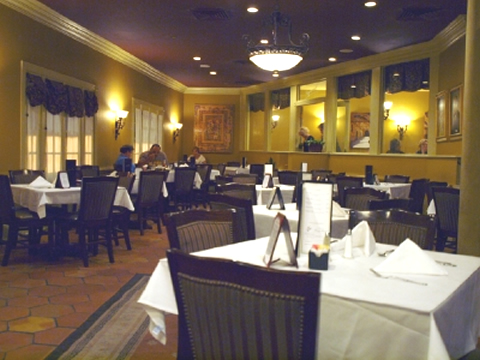 Peppermill DiningRoom[/caption]
I begin my eating with crabcakes with remoulade. Then a dish I don't recall: chicken Positano, named for a city in the Amalfi Coast in Italy. I've been to Positano, and tried to get some laughs aout of the idea of a rival community nearby called Negatano. See, the Negatanese people have bad attitudes about everything. Get it?
Again I tell you, I have been trying to get a laugh with this anecdote for over twenty years. The dish itself was not one of the best things I've had at the Peppermill. Chicken, tomatoes, cheese.
Peppermill DiningRoom[/caption]
I begin my eating with crabcakes with remoulade. Then a dish I don't recall: chicken Positano, named for a city in the Amalfi Coast in Italy. I've been to Positano, and tried to get some laughs aout of the idea of a rival community nearby called Negatano. See, the Negatanese people have bad attitudes about everything. Get it?
Again I tell you, I have been trying to get a laugh with this anecdote for over twenty years. The dish itself was not one of the best things I've had at the Peppermill. Chicken, tomatoes, cheese.
 [title type="h2"]Pelican Club. French Quarter: 615 Bienville. 504-523-1504. [/title]
[title type="h2"]Pelican Club. French Quarter: 615 Bienville. 504-523-1504. [/title]
Three Courses, $39
Plus tax and gratuity
APPETIZERS
Shrimp, Chicken and Andouille Sausage Gumbo
Seafood Martini Ravigote
Maine lobster, gulf shrimp, jumbo lump crabmeat, Yukon gold potato salad
Pelican Club Baked Oysters
On the half shell, applewood smoked bacon, roasted red peppers, parmesan & garlic herb butter
Fritto Misto
Shrimp, calamari, zucchini, Japanese eggplant, mushroom, pickled onions and caper tartar sauce
Clay Pot "Barbequed Shrimp"
Jumbo shrimp, rice noodles, chiles and pineapple, spicy sauce
Korean 24-Hour-Cooked Boneless Baby Back Ribs
With spicy kimchee
Wedge Salad Bowl
Blue cheese dressing, little gem lettuce, applewood smoked bacon, cherry tomato and watermelon radish
ENTRÉES
Pannéed Gulf Fish and Blue Crab
Butterbean succotash, jalapeno hollandaise and meuniére sauce (Add $3)
Crispy Peking Duck Breast
House-made pancakes, jasmine rice, cashew snow pea pods,
Ginger duck demi-glace and assorted condiments
Six-Ounce Filet Mignon and Crab Cake
Almond haricots verts, bearnaise sauce and truffle mashed yukon gold potatoes (Add $4)
Blue Crab Fettuccine
Crab butter, asparagus, sweet corn, pea pods, watercress and lemon gremolata
Vegetarian Market Platter of the Day
One-Pound Whole Maine Lobster, Fried Jumbo Shrimp
With asparagus and lemon cream (Add $5)
Seared Sashimi Grade Tuna and Chinois Salad
Soy wasabi glaze and avocado
DESSERTS
Chocolate Decadence Cake
White Chocolate Bread Pudding
Coconut Cream Pie
Banana Pudding
Choice of appetizer, entree and dessert. Limit 12 guests. Please, no sharing.
Selected Cocktail and Wine Pairings
(Three for $24, mix and match)
SELECTED WINES
Sparkling
Comte de Lafayette Rose France NV
Rosé
Guilhem Rosé Languedoc France '16
White
Louis Latour Ardeche Chardonnay France '15
Portal De Callcado Vinho Verde Portugal '16
Gabbiano Promessa Pinot Grigio Venezia Italy '15
Pacific Oasis Riesling Columbia Valley Washington '13
Red
Lago Cerqueira Douro Valley Portugal '14
Tortoise Creek "Mission Grove" Pinot Noir California '15
Henry Fessy Beaujolais-Villages Old Vines France '15
Murphy-Goode Homefront Red Zinfandel Blend California '11
[divider type=""]

Cannoli
Cannoli are a favorite dessert in Sicily, and anywhere Sicilians have roamed--including New Orleans. They're made by stuffing tubes of sweet, thin dough fried until crispy with sweetened ricotta cheese, usually including jellied fruit, chocolate chips, and pistachio nuts. They are made outstandingly well at Angelo Brocato's in New Orleans. This recipe is based on the one in La Cucina di Andrea's, a cookbook I wrote in 1989 with Chef Andrea Apuzzo. The shells are the hard part, but not too bad. While special forms are made for making cannoli, you can also use a six-inch length of broomstick (with the pain sanded off, of course).
[caption id="attachment_34657" align="alignnone" width="400"]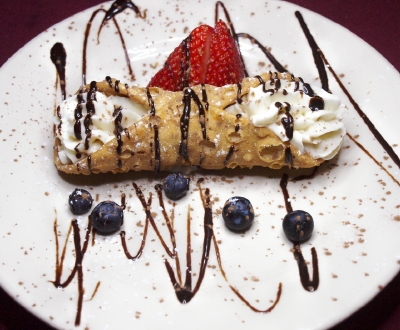 Cannoli, dressed up, from VIncent's. [/caption]
Cannoli, dressed up, from VIncent's. [/caption]
- Shells:
- 1 1/4 cup all-purpose flour
- 5 Tbs. Marsala wine
- 1 Tbs. sugar
- Pinch of cocoa powder
- Pinch cinnamon
- Pinch salt
- Vegetable oil for frying
- Filling:
- 1 lb. ricotta cheese
- 1 cup sugar
- 1/2 cup mixed jellied fruit (as for fruitcake)
- 2 Tbs. chocolate chips
- 1 Tbs. vanilla
- 1/2 oz. triple sec liqueur
- Garnish:
- Chopped pistachio nuts
- Chocolate shavings
- Powdered sugar
1. To make the shells, mix all the dry ingredients in a bowl. Add Marsala and stir with a whisk until the mixture turns crumbly.
2. Knead the dough a bit to make it solid, with no air gaps. Roll it out on a board to about the thickness of two stacked nickels. Fold it over and roll it out again, then repeat the process once more.
3. Heat the vegetable oil in a deep saucepan to 375 degrees. While waiting for it to come up to temperature, cut out circles of the dough about five inches in diameter. Wrap them around the cannoli forms.
4. Deep-fry the dough-wrapped forms
until crisp--about five minutes. Remove from the oil and drain. Remove the
forms, and allow the shells to cool.
5. Make the filling by mixing all the ingredients until well blended. When the shells are cool, use a thin knife to scrape the filling into the shells. Be careful not to break the shells. Dip ends of cannoli in pistachio nuts or chopped chocolate bits. Dust with powdered sugar.
Makes 18-24 cannoli.
[divider type=""]
 Spinach Pie @ Byblos
Spinach Pie @ Byblos

Spinach pie is better identified as a Greek dish than Lebanese. But the cuisines are related, and the way Byblos makes it seems Greek to me. The lightness is the key. Both the phyllo pastry and the spinach-and-feta filling are puffy, lacking the heaviness we sometimes find in other versions. All the flavors are in balance. The portion is large enough almost to make an entree.
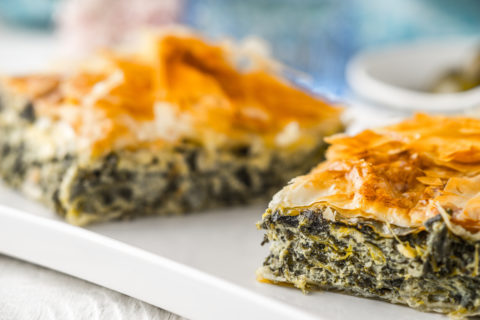
Byblos. Old Metairie: 1501 Metairie Rd. 504-834-9773.
Uptown: 3218 Magazine. 504-894-1233. This is among the 500 best dishes in New Orleans area restaurants. Click here for a list of the other 499.
[divider type=""]
 July 17, 2017
July 17, 2017
Days Until. . .
- Shells:
- 1 1/4 cup all-purpose flour
- 5 Tbs. Marsala wine
- 1 Tbs. sugar
- Pinch of cocoa powder
- Pinch cinnamon
- Pinch salt
- Vegetable oil for frying
- Filling:
- 1 lb. ricotta cheese
- 1 cup sugar
- 1/2 cup mixed jellied fruit (as for fruitcake)
- 2 Tbs. chocolate chips
- 1 Tbs. vanilla
- 1/2 oz. triple sec liqueur
- Garnish:
- Chopped pistachio nuts
- Chocolate shavings
- Powdered sugar
 Spinach Pie @ Byblos
Spinach Pie @ Byblos July 17, 2017
July 17, 2017
Satchmo Summer Fest 18
Restaurant Anniversaries
This is the birthday, in 1979, of Mr. B's Bistro. Its opening was a turning point in many ways. It was the first new restaurant opened by the Commander's Palace side of the Brennan family after it split with Brennan's on Royal Street in 1973. In the intervening years, they closed four of their six restaurants. Mr. B's represented the rise of the next generation of Brennans, who opened one restaurant after another thereafter. More important, Mr. B's was the archetype for the gourmet Creole bistro--a new kind of restaurant at the time. It was widely imitated in the next decade, and restaurants like Mr. B's now dominate the dining scene. They serve great food of high intrinsic quality, but in casual dining rooms devoid of pretense and ceremony. It was a perfect match to the tastes of baby Boomers, who were coming into their own in 1979. Mr. B's was the last major restaurant to return to action after the hurricane. Its opening brought the number of real restaurants in town to 809--the number we had before the storm. It's a keystone in the New Orleans restaurant scene. Crab cakes, gumbo ya-ya, barbecue shrimp, bread pudding--all are the best in town.
Annals Of Dining Comfort
This is one of several dates that could be called the anniversary of air conditioning. In 1901 on this date, Willis Carrier started up his air conditioner in a printing plant in Brooklyn. The owners of the place were trying to cool the equipment, not the people running it--although the benefits they enjoyed from the comfortable air were so great that air conditioning spread. First to public buildings, then to homes. Movie theatres found they could attract much larger crowds if they offered respite from the summer as well as entertainment. In climates like ours it was a godsend. Think about what it must have been like to dine in Antoine's or Galatoire's before air conditioning on a day like today.
Today's Flavor
It is National Parsley Day. As mild a flavor as it possesses, parsley adds something. Its mild acidity (ounce for ounce, parsley actually has more vitamin C than oranges do), the fresh, green flavor, the color and texture. . . all contribute that last two percent to a dish.
 Parsley is more than a garnish, though. The classic recipe for oysters Rockefeller--the one that doesn't use spinach--employs parsley by the bunch. So does the lenten Creole soup-stew, gumbo z'herbes. In Lebanese cooking, parsley is used by the fistful in dishes like tabbouleh.
If you have to cook with dried herbs, or if you have a dish that leans toward gloppiness (like crawfish etouffee), or if you have some leftovers you'd like to enjoy again. . . try adding fresh parsley. It brings the flavor and texture right up without altering the flavor of the dish deeply.
Finally, there is the matter that parsley refreshes the breath. That's a minor point, but it has been used to explain the parsley sprig that comes on many plates (or used to.)
Always pick the leaves off the parsley stems before cutting. It's tedious, but the leaves have a better flavor than the stems. (Save the stems, though--they're a great addition to the stock pot.) Chop the leaves finely, using a sharp chef's knife. A food processor beats it up too much. Don't chop it much in advance. Parsley loses its fresh charm if it sits out for more than an hour. Forget freezing.
Two other members of the parsley family are out there, and may cause confusion. Cilantro is now almost universally available in supermarkets, and usually displayed right next to the flat-leaf and curly parsley. The leaves look different, but not dramatically. To be certain you have what you want, pick a leaf, break it, and smell it. The salsa-like aroma of cilantro is unmistakable. The other, much less common parsley variant is chervil, whose leaves are smaller than regular parsley. It has a subtle anise-like aroma and flavor.
Parsley is more than a garnish, though. The classic recipe for oysters Rockefeller--the one that doesn't use spinach--employs parsley by the bunch. So does the lenten Creole soup-stew, gumbo z'herbes. In Lebanese cooking, parsley is used by the fistful in dishes like tabbouleh.
If you have to cook with dried herbs, or if you have a dish that leans toward gloppiness (like crawfish etouffee), or if you have some leftovers you'd like to enjoy again. . . try adding fresh parsley. It brings the flavor and texture right up without altering the flavor of the dish deeply.
Finally, there is the matter that parsley refreshes the breath. That's a minor point, but it has been used to explain the parsley sprig that comes on many plates (or used to.)
Always pick the leaves off the parsley stems before cutting. It's tedious, but the leaves have a better flavor than the stems. (Save the stems, though--they're a great addition to the stock pot.) Chop the leaves finely, using a sharp chef's knife. A food processor beats it up too much. Don't chop it much in advance. Parsley loses its fresh charm if it sits out for more than an hour. Forget freezing.
Two other members of the parsley family are out there, and may cause confusion. Cilantro is now almost universally available in supermarkets, and usually displayed right next to the flat-leaf and curly parsley. The leaves look different, but not dramatically. To be certain you have what you want, pick a leaf, break it, and smell it. The salsa-like aroma of cilantro is unmistakable. The other, much less common parsley variant is chervil, whose leaves are smaller than regular parsley. It has a subtle anise-like aroma and flavor.
Edible Dictionary
suppli al telefono, Italian, n.--It translates literally as "telephone wires," a name that will puzzle anyone who's seen but not eaten the dish. These are balls of rice about the size of a golf ball, held together with eggs and sometimes with just enough tomato sauce to make the rice a pale orange. In the center is a cube of mozzarella cheese. The balls are rolled in bread crumbs and fried long enough that the interior is very hot. When you cut into it with a fork and lift the bite to your mouth, festoons of cheese stretch between the ball and the fork. These are supposed to resemble telephone wires. The dish is a common appetizer around Italy, especially in Rome.
Gourmet Gazetteer
Orange, Texas, population 18,700, is the easternmost large town in Texas, right on the Sabine River and the Louisiana state line. That gives it the trivial distinction of having the highest-numbered Interstate exit and mile marker anywhere. It's 880 miles on the I-10 to El Paso. Orange was founded as a port town on the Gulf of Mexico in 1836, and that's how it's always made its living. Oranges may be grown there, but not on a large scale; the land is low and marshy in the area. Except for the many fast-food places on the I-10, Orange's cuisine has been thoroughly converted to Cajun. The best restaurant in town (sez Texas Monthly, a good source) is Robert's Meat Market And Steakhouse, 3720 W. Park Ave., 409-883-0979.
The Lunch Counter
F.W. Woolworth Co. announced today in 1997 that it would close all the remaining Woolworth's five-and-dime stores in America, after over a century in business. Although Woolworth's was the same nationwide, we always considered it a part of the New Orleans scene. The two stores on Canal Street (three blocks apart) were on everybody's downtown shopping itinerary in the days when everybody shopped on Canal Street. Who doesn't remember going there for breakfast or for a grilled cheese sandwich with crinkle-cut fries? Other Woolworth's around town includes two on Magazine Street and one on Oak Street, all of which were anchors in their neighborhoods. Woolworth is still around, under different names--Foot Locker being the most prominent.
Restaurant Namesakes
King George V of England changed his surname today in 1917. He relinquished his German titles (England was at war with the Germans at the time), and proclaimed that his heirs would no longer be called the House of Saxe-Coburg-Gotha, but the House of Windsor. It is this name that landed on the Windsor Court Hotel--often lauded in its twenty-five years as the finest hotel in New Orleans.
Fromage Du Jour
Banon (French), [bah-NONH], n.--One of the soft white cheeses made since ancient times in what is now the southeastern French region of Provence. Banon comes from the town of the same name. It's usually made with unpasteurized goat's milk, although sometimes sheep's milk is also used. After being made into small wheels, it gains a thin, snowy layer of mold. Then it's distinctively wrapped in chestnut leaves and tied with raffia. In its fresh form, it's spreadable and tangy. As it gets older--especially if it's been aged in a jar with vinegar and eau-de-vie, a process that can go on for years--it becomes very assertive and harder.
Music To Watch Movies By
The first record released by the Supremes came out today in 1961. It was called Buttered Popcorn. Has anyone ever heard it?
Food And Drink Namesakes
The British satirical magazine Punch published its first issue today in 1841. . . Canadian actress-turned-politician Andrée Champagne popped her cork today in 1939. . . Movie actor Bill Sage leafed out today in 1962.
Words To Eat By
"Approaching the stove, she would don a voluminous apron, toss some meat on a platter, empty a skillet of its perfectly cooked a point vegetables, sprinkle a handful of chopped parsley over all, and then, like a proficient striptease artist, remove the apron, allowing it to fall to the floor with a shake of her hips."--Bert Greene.
Words To Drink By
Old friends are the best! Age appears to be best in four things; old wood best to burn, old wine to drink, old friends to trust, and old authors to read.--Francis Bacon.
[divider type=""]

Extreme Overeating.
Probably with reflux. Don't let this happen to you!Click here for the cartoon.
[divider type=""] #### [divider type=""]
Upcoming Eat Club Dinners
Lakehouse In Mandeville
Scroll down for details, menus, reservation form, list of reservations and general info about the Eat Club.
Click here to reserve.
The Lakehouse has a long history. It went up on the Mandeville lakefront in the 1840s, and became a restaurant in the 1890s. It's been that ever since. After repairs of hurricane and fire damage in the past decade, the big two-story house is beautiful, with an expansive view of Lake Pontchartrain. Cayman Sinclair, who has been involved in major North Shore dining for over 20 years, has kept up the historic look while Chef Marlon Hornsby pushes ahead with the Lakehouse's cuisine. It's decidedly up to date, but at the same time familiar. The Eat Club will show just how good the Lakehouse is with a dinner on Thursday, July 27. Four courses of classy eats. with paired wines, to wit:
U-10 Sea Scallops
English peas, pickled tomatoes, brown-butter croutons, and soft fresh herbs
Louisiana Crawfish Arancini
Fried croquettes of bread crumbs, Parmigiano cheese, Crystal hot sauce butter, celery, preserved lemon. Italian parsley
New York Strip Sirloin Steak
Painted Hills Ranch. Ember-roasted turnips, smoked eggplant puree, crispy leeks, chimichurri butter, Burgundy wine reduction
Dark Chocolate Pâté
Blueberry coulis, spiced pecan-rum butter
The dinner begins around seven, so we can see the sun set. If you arrive late, no problem. Dress is casual. If the weather is really nice, we may decide to serve outdoors on the lawn. The price is $80, inclusive of tax, tip, and wines. You will pay by credit card when you arrive. Reservations are essential; click here to do that. Please let us know a day in advance if you must cancel. The restaurant is at 2025 Lakeshore Drive in Mandeville, a half-block from Girod Street.
[divider type=""]

Shirred Eggs with Crabmeat Remick
The biggest brunch dish I ever served at home was this one. We had a half-dozen friends over at noonish, and they were expecting something special. I gave them a classic crabmeat appetizer that I turned into a terrific egg dish. You don't see shirred eggs very often, even in restaurants, but I love the style. The technique is to cook the eggs with powerful heat from above after setting them on something savory.
- 6 slices smoky, thick bacon
- 1 lb. jumbo lump crabmeat
- 1 Tbs. lemon juice
- 12 eggs
- Sauce:
- 1/2 tsp. salt-free Creole seasoning
- 1/4 tsp. salt
- 1/2 tsp. Tabasco
- 1/4 cup bottled chili sauce
- 1/2 cup mayonnaise
- 1 Tbs. Creole mustard
- 1 green onion, tender green parts only, sliced fine.
- 1 Creole mustard
- 1 Tbs. tarragon vinegar
[caption id="attachment_42916" align="alignnone" width="480"]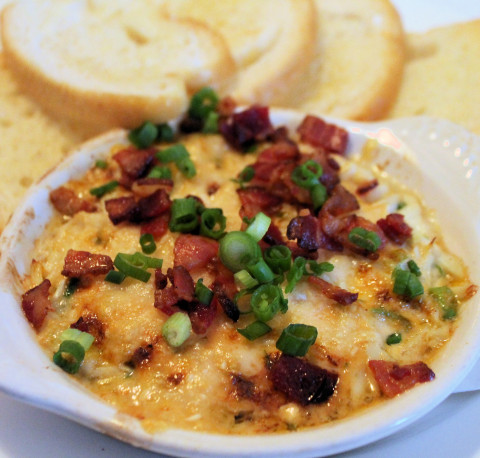 Eggs Remick, before the eggs are added.[/caption]
1. Slice the bacon into squares and fry till crisp. Drain very well and set aside.
2. Divide crabmeat among six small, shallow au gratin dishes or ramekins. Sprinkle the lot with lemon juice, and heat in 350-degree oven for three minutes.
3. While waiting for crabmeat to warm, blend all the sauce ingredients.
4. When the crabmeat is hot, top each baking dish with an equal portion of crumbled bacon. Pour the sauce right on top, just enough to cover. Then carefully break two eggs onto each dish, keeping the yolk whole.`
5. Turn the oven on broil and place the ramekins under the fire until the eggs have set. The centers of the eggs should be just a little runny. Serve immediately with a warning that the dish is hot!
Serves six.
[divider type=""]
Eggs Remick, before the eggs are added.[/caption]
1. Slice the bacon into squares and fry till crisp. Drain very well and set aside.
2. Divide crabmeat among six small, shallow au gratin dishes or ramekins. Sprinkle the lot with lemon juice, and heat in 350-degree oven for three minutes.
3. While waiting for crabmeat to warm, blend all the sauce ingredients.
4. When the crabmeat is hot, top each baking dish with an equal portion of crumbled bacon. Pour the sauce right on top, just enough to cover. Then carefully break two eggs onto each dish, keeping the yolk whole.`
5. Turn the oven on broil and place the ramekins under the fire until the eggs have set. The centers of the eggs should be just a little runny. Serve immediately with a warning that the dish is hot!
Serves six.
[divider type=""]
 Crab On Crab @ Cafe B
Crab On Crab @ Cafe B
During the summer, Cafe B can be relied upon for its continuously creative-yet-familiar seafood dishes, most of which are not available the rest of the year. Last Year, it was a ravioli of Lobster with crabmeat--a dish I hope comes back now and then. This summer we find a doubly-crabby dish, whose centerpeice is a fried soft-shell crab with brown butter sauce. Also on the plate is a crab salad, made with jumbo lump and arugula. You can go either way with this: light entree or an appetizer shared for two. While Cafe B started as a very casual Old Metairie cafe, it has evolved into an excellent bistro where running into friends is inevitable. [caption id="attachment_42340" align="alignnone" width="480"]
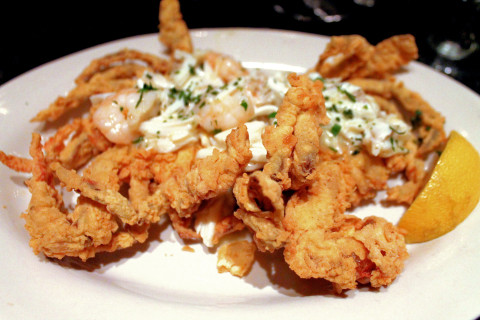 Crab on crab.[/caption]
Crab on crab.[/caption]
Cafe B. Old Metairie: 2700 Metairie Road. 504-934-4700.
This is among the 500 best dishes in New Orleans area restaurants. Click here for a list of the other 499. [divider type=""] July 14, 2017
July 14, 2017
Days Until. . .
Satchmo Summer Fest 20
Vive La France!
This is Bastille Day, the French version of the Fourth of July, commemorating the end of the monarchy (for the moment) and the beginning of the French Republic in 1789. Their Revolution had far worse effects than ours did, but the ancien regime it overthrew was much more oppressive than what America had to deal with. It would be awhile before the aristocrats would be gone for good. France still had Napoleon in its unfortunate future.
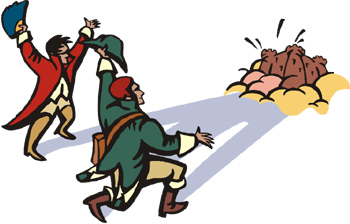 The French Revolution is often credited for the genesis of the restaurant as we know it. When the nobles were beheaded, the chefs who worked for them had to go out on their own. Then, the only places one would eat outside the home were inns and pubs, but these were strictly for subsistence. The idea of cooking and serving grand food for whoever wanted to pay for it was revolutionary.
The French Revolution is often credited for the genesis of the restaurant as we know it. When the nobles were beheaded, the chefs who worked for them had to go out on their own. Then, the only places one would eat outside the home were inns and pubs, but these were strictly for subsistence. The idea of cooking and serving grand food for whoever wanted to pay for it was revolutionary.
 It's currently in vogue to dislike the French, even though the reasons are less than reasonable. In the culinary arena, hating things French seems especially pointless. A friend and fellow food writer had a good line about France: "It's the mother of us all."
That's certainly true in New Orleans. Creole cuisine is founded on French cookery, and although we've come far enough that it's unique to this place, we can't deny where it came from. Any culture capable of producing this is worth our respect, no matter what momentary other currents may be out there. Eat some French food today.
It's currently in vogue to dislike the French, even though the reasons are less than reasonable. In the culinary arena, hating things French seems especially pointless. A friend and fellow food writer had a good line about France: "It's the mother of us all."
That's certainly true in New Orleans. Creole cuisine is founded on French cookery, and although we've come far enough that it's unique to this place, we can't deny where it came from. Any culture capable of producing this is worth our respect, no matter what momentary other currents may be out there. Eat some French food today.
Food Calendar
This is International Pâté Day. "Pâté" in French comes from the same etymological root that gives us "pasta" in Italian and "paste" in English. The latter word explains the essence of pâté. It's a meat (or vegetable, fish, or other food) rendered into a spreadable consistency. There's lots of leeway; pâtés can have chunks or hard bits in them. Or they can be light, smooth mousses. The French have different names for all the possibilities, but pâté can cover them all generically.
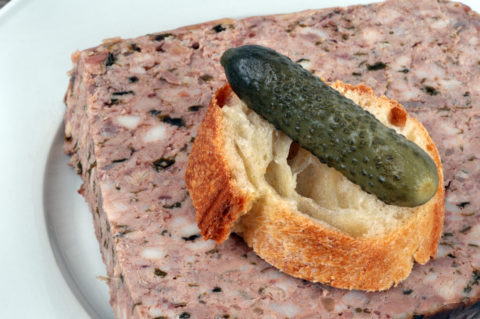 The first time I had pâté de foie gras, it reminded me of liver cheese, which I always enjoyed as a kid. Contrary to popular belief, not all pâtés are made with liver. But a lot of them do include liver as a main ingredient, and those are the most popular. It's just the perfect meat to start with, because of its depth of flavor and smoothness when made into a forcemeat. The livers come from mammals (particularly pigs), but the most famous liver pâtés are those made from birds' livers. Pâté de foie gras is the smooth forcemeat of fattened goose or duck liver. Most pâtés contain a good bit of fat, both from the meat component as well as from butter.
Pâtés begin a meal well, and that's when they're best served, at cool room temperature. Crackers or croutons usually come with them, so you can eat the spreadable kind. But the chunky ones--pâté de campagne, for example--can be eaten with a fork. A platter full of pâtés can easily have no two looking or tasting alike. It's a great start to a meal, the perfect partner to wine.
The first time I had pâté de foie gras, it reminded me of liver cheese, which I always enjoyed as a kid. Contrary to popular belief, not all pâtés are made with liver. But a lot of them do include liver as a main ingredient, and those are the most popular. It's just the perfect meat to start with, because of its depth of flavor and smoothness when made into a forcemeat. The livers come from mammals (particularly pigs), but the most famous liver pâtés are those made from birds' livers. Pâté de foie gras is the smooth forcemeat of fattened goose or duck liver. Most pâtés contain a good bit of fat, both from the meat component as well as from butter.
Pâtés begin a meal well, and that's when they're best served, at cool room temperature. Crackers or croutons usually come with them, so you can eat the spreadable kind. But the chunky ones--pâté de campagne, for example--can be eaten with a fork. A platter full of pâtés can easily have no two looking or tasting alike. It's a great start to a meal, the perfect partner to wine.
Gourmet Gazetteer
Chops Creek is twenty-seven miles north of Augusta, Maine. It's a tidal stream that runs through an alluvial flat in a valley with low hills on both sides. In Louisiana it would be called a bayou. Its course is parallel to the Kennebec River as it nears the Atlantic Ocean, and just off Merrymeeting Bay. We get a good idea of what kind of activity is in these waterways from the name of the nearest restaurant to Chops Creek: The Five Islands Lobster Company.
Edible Dictionary
coriander, n.--A member of the parsley family, whose leaves have a distinctly sharper flavor than other parsleys. References to coriander on menus or in spice jars almost always mean the seeds of that plant, which have a thin, aromatic sharpness that sets off many other flavors without jumping into the foreground, even if you use a lot of it. The plant's leaves themselves are most often called by their Spanish name, cilantro, which tastes very different from the seeds. Few people who hate cilantro (and there are many of those) find anything objectionable in coriander.
Deft Dining Rule #115
Beware of complimentary pates served at the outset of dinner. It can kill one's appetite, especially if it and the restaurant's bread is good.
Annals Of Cheesemaking
Frederick Louis Maytag was born in Chicago today in 1857. He formed the manufacturing company that became famous for its washing machines and refrigerators. His grandsons began making blue cheeses in Iowa in 1941, and still does. It's the best-known premium blue cheese made in America, and is still owned by the Maytag family.
Annals Of Popular Cuisine
Tom Carvel was born today in 1904. He began a chain of ice cream parlors--the first of its kind, paving the way for Baskin-Robbins and all the others. Carvel remains ubiquitous in the Northeast, and has begun to grow more rapidly lately. It currently has over 8000 ice cream parlors around the country.
Food And Drink Namesakes
Northrop Frye, an academic writer who redefined the concept of literary criticism, was born today in 1912. . . Taboo, a Hispanic rapper who performs with the Black Eye Peas, came out of his shell today in 1975. . . Lee Mead, a British actor and singer in musical theater, hit The Big Mark today in 1981.
Words To Eat By
"The perfect lover is one who turns into a pizza at four a.m."--Charles Pierce, American comedian, born today in 1926. "A pâté is nothing more than French meat loaf that's had a couple of cocktails."--Carole Cutler, American cookbook author.
Words To Drink By
"I am the world's last barman poet! I see America drinking the fabulous cocktails I make. America is getting stinking on something I stir or shake."--Tom Cruise, playing a Jamaican bartender named Brian in the movie Cocktail.
[divider type=""]

Prepared Especially For You.
You hear that a lot, but how true is it? Don't they make the same recipes for everybody? Or is is like this?Click here for the cartoon.
[divider type=""] #### Saturday, July 1, 2017. 12:33 p.m. Disorientation. I head across the lake to the radio station to do my Saturday Food Show. There is nobody in the facility except Dave Potter, who produces the show on Saturdays.
"Where is everybody?" I ask.
"What are you doing here?" he asks.
"I'm here for the Saturday show," I say.
"It's not Saturday," he says." It's Monday, a company holiday. You're off."
I'm off, all right. But I push ahead. "So this is the Third of July?"
"No," Dave says. "It's the first. Tomorrow is the second. Monday is the third, and Tuesday is the Fourth of July. You have no show until Wednesday."
I wave at him and go to my office to dope this out. It's nothing new for me to get confused about what day of the week it is, especially if a holiday intervenes. The day after a holiday always registers in my mental calendar as a Monday. But this is a bit more confusing than usual. If I get two unusual days off followed by two days of regular schedules, the next day feels like a Friday. All of this is amplified if I'm just coming back from a long vacation--as I am. Two weeks away, returned last night on a crazy-making train. I always talk about this effect on the air, and find that I am not the only one who gets mixed up. Still. . .
"Did you take your meds?" Dave asks, with a laugh. I laugh back.
At my desk, I take the calendar down from the wall and look it over. The graphics help me understand what's what.
This is not a good night to go to a restaurant on the South Shore. The Essence Festival fills the eateries. I head home. Mary Ann finds, when we start calling possible restaurants for dinner, that most restaurants are closed. We get into the car with Mary Leigh, who is also running from the Essence crowds. We try New Orleans Food and Spirits. Forty-five minute wait. Ox Lot 9: over an hour. Meribo: almost an hour. Another five or six places: same general report.
[caption id="attachment_38482" align="alignnone" width="480"]
Saturday, July 1, 2017. 12:33 p.m. Disorientation. I head across the lake to the radio station to do my Saturday Food Show. There is nobody in the facility except Dave Potter, who produces the show on Saturdays.
"Where is everybody?" I ask.
"What are you doing here?" he asks.
"I'm here for the Saturday show," I say.
"It's not Saturday," he says." It's Monday, a company holiday. You're off."
I'm off, all right. But I push ahead. "So this is the Third of July?"
"No," Dave says. "It's the first. Tomorrow is the second. Monday is the third, and Tuesday is the Fourth of July. You have no show until Wednesday."
I wave at him and go to my office to dope this out. It's nothing new for me to get confused about what day of the week it is, especially if a holiday intervenes. The day after a holiday always registers in my mental calendar as a Monday. But this is a bit more confusing than usual. If I get two unusual days off followed by two days of regular schedules, the next day feels like a Friday. All of this is amplified if I'm just coming back from a long vacation--as I am. Two weeks away, returned last night on a crazy-making train. I always talk about this effect on the air, and find that I am not the only one who gets mixed up. Still. . .
"Did you take your meds?" Dave asks, with a laugh. I laugh back.
At my desk, I take the calendar down from the wall and look it over. The graphics help me understand what's what.
This is not a good night to go to a restaurant on the South Shore. The Essence Festival fills the eateries. I head home. Mary Ann finds, when we start calling possible restaurants for dinner, that most restaurants are closed. We get into the car with Mary Leigh, who is also running from the Essence crowds. We try New Orleans Food and Spirits. Forty-five minute wait. Ox Lot 9: over an hour. Meribo: almost an hour. Another five or six places: same general report.
[caption id="attachment_38482" align="alignnone" width="480"]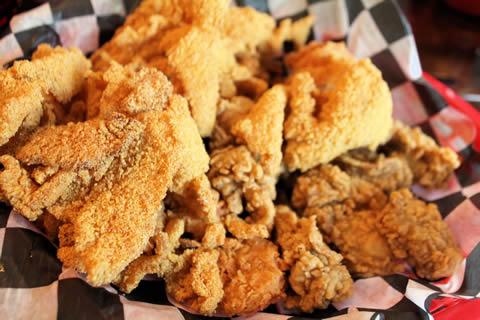 Fried artichoke hearts and thin-sliced fried onion rings at Crabby's Shack.[/caption]
Finally we call the Crabby Shack, where we are told that there was immediate seating, but that they wouldn't hold a table if somebody shows up before we do. Someone does. In fact, five tables of people beat us there. We decide to tough out our time investment. An hour later, we sit down. Of course, this isn't the restaurant's fault, it's ours.
We devour the usual Crabby Shack goods. Fried artichokes. Big salads. Chicken gumbo. Fried shrimp. Cheeseburger. I eat best of all: blackened red snapper. Excellent.
This is one of those unexpected semi-holidays that nobody expects to find filled up or closed. I will have to compile a list of such restaurants, and possible substitutes.
Crabby's Seafood Shack. Madisonville: 305 Covington. 985-845-2348.
[divider type=""]
Fried artichoke hearts and thin-sliced fried onion rings at Crabby's Shack.[/caption]
Finally we call the Crabby Shack, where we are told that there was immediate seating, but that they wouldn't hold a table if somebody shows up before we do. Someone does. In fact, five tables of people beat us there. We decide to tough out our time investment. An hour later, we sit down. Of course, this isn't the restaurant's fault, it's ours.
We devour the usual Crabby Shack goods. Fried artichokes. Big salads. Chicken gumbo. Fried shrimp. Cheeseburger. I eat best of all: blackened red snapper. Excellent.
This is one of those unexpected semi-holidays that nobody expects to find filled up or closed. I will have to compile a list of such restaurants, and possible substitutes.
Crabby's Seafood Shack. Madisonville: 305 Covington. 985-845-2348.
[divider type=""]

Fish In A Salt Dome
The late Chef Jamie Shannon cooked this for a dinner I had at Commander's Palace in New Orleans in 1992. It was one of the first dinners served at the restaurant's now-famous Chef's Table. The fish was as delicious as it was dramatic. The whole fish was on a pan covered with a pile of salt in which it had been baked. The salt formed a shell that had to be broken. Amazingly, it was not salty at all--just full of elemental fish flavor. I recommend drum, redfish, red snapper, small grouper, Spanish mackerel, or other nice fatty fish.
- 1 whole Gulf fish, 2 to 4 pounds, dressed
- 2 boxes kosher salt
Preheat the oven to 375 degrees.
1. The best pan to use for this is an oval pan about 18 inches long by 12 inches wide, and about three inches deep. Cover the bottom with about a half-inch of salt. Place the fish on top of the salt. Now cover the fish with salt so that it mounds up about a half-inch thick at its thinnest part.
2. Using a clean spray bottle, spray water all over the salt until it's glistening with dampness. Put the pan into the oven at 375 degrees and bake for between 40 minutes (for a two-pounder) to an hour (for a four-pounder). If you want to be exacting, shove (this will not be easy) a meat thermometer through the salt and into the fish when you think it's nearing doneness. Look for an internal temperature of 125-130 degrees.
3. Remove the fish from the oven and allow it to stand for 10-15 minutes. Break the salt shell, brush off the excess salt and, as you carve the fish, remove the skin. This fish will be so juicy and delicious that no sauce is needed.
Serves two to six, depending on the size of the fish. (Figure about ten ounces per person of whole fish.)
[divider type=""]
 Smoked Salmon And Bagel @ Stein's Deli
Smoked Salmon And Bagel @ Stein's Deli
In this well-worn deli, the refrigerator cases are full of meats from both the Jewish and Italian traditions, and are as fine as can be found locally. This is also true of the breads, which are a godsend if one has grown up eating New York bagels and has a hankering for them. New Orleans has as few good sources of excellent bagels as New York has muffuletta bread bakers. Dan Stein brings his bagels in from New York regularly. Add the silky smoked salmon and the usual accoutrements, close your eyes, and pretend you're in the Apple. It almost works.
[caption id="attachment_55262" align="alignnone" width="480"]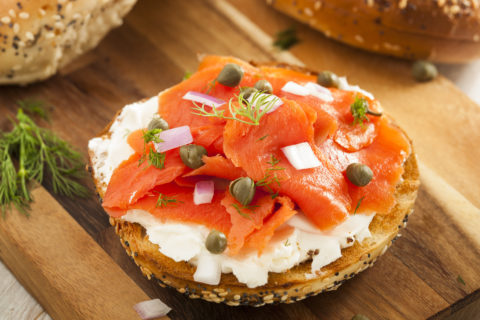 Bagel, lox, cream cheese, capers, and dill[/caption]
Bagel, lox, cream cheese, capers, and dill[/caption]
Stein's Deli. Uptown: 2207 Magazine . 504-527-0771.
This is among the 500 best dishes in New Orleans area restaurants. Click here for a list of the other 499. [divider type=""] July 13, 2017
July 13, 2017
Days Until. . .
Satchmo Summer Fest 21
Celebrity Chefs Today
Chef Paul Prudhomme was born today in 1940. He was the youngest of thirteen children, and grew up on a farm near Opelousas. He often said that the goodness of Cajun cooking came from having to sell the best of what they caught and grew, and making secondary foodstuffs taste good. He also said that people who grew up close to the earth, as his family did, had the advantage of having the ultimate in freshness in their food. Chef Paul first came to our attention when, in 1974, he became chef of La Bon Creole, the restaurant in the Maison Dupuy Hotel that's now Le Meritage. After a few other gigs, he turned up as executive chef of all of the restaurants operated by the Commander's Palace branch of the Brennan family. Commander's became great while he was there, as he introduced an entirely new style of Cajun and Creole cooking. During those years, Paul began encouraging young people to take up cooking as a profession--not the kind of advice they heard much in those days. He opened his own restaurant on July 3, 1979. K-Paul's Louisiana Kitchen (the "K" is for his late wife Kay Hinrichs, a big part of the operation) was an instant hit, and Paul's celebrity grew exponentially. He remains one of the best-known chefs in America, and his cookbooks began their long and continuing run as best-sellers. After the hurricane, Chef Paul became highly visible locally, giving free food from his spice plant in Elmwood, and camping out on the sidewalk in front of K-Paul's to encourage the revival of New Orleans. Chef Paul passed away on October 8, 2015, but his restaurant and cookbooks live on as robust as ever.
Food Calendar
It is National French Fry Day. Fried potatoes are among the greatest culinary creations of all time. Even when they're badly made, they're tempting. When well made, they're irresistible. Chefs and restaurateurs from the lowest to the highest orders brag about their fries as much as about anything. No less a gourmet than Thomas Jefferson proudly served fries at the White House.
 A clear uptick in the quality of restaurant French fries appeared in recent years. More of them take the trouble to cut their own from fresh potatoes. That was at one time universal. Even McDonald's use to have fresh-cut fries, as late as the 1970s. Frozen, pre-blanched, pre-cut potatoes now rule the world. They're treated with batter or flavorings to approximate the crispness and flavor of the fresh article. That must be done because most French fries are fried in advance. They may be wonderful as they come out of the fryer, but unless something is done they become limp or dry a few minutes later. I understand why fast food restaurants serve frozen potatoes. But why should seafood restaurants, neighborhood cafes, and even some uppity, expensive bistros serve frozen fries?
The answer is distressing. It's that most Americans are so accustomed to eating frozen French fries that they look askance at potatoes done the right way. The problem is exacerbated by a lack of fry-making skill in some of the restaurants that try to use fresh potatoes.
But the technique is simple. To make great French fries, all you have to do is fry them twice. That way they not only have that great potato flavor, but they're crisp as well. There's only one problem: after the first frying, they're really ready to eat, and some people can't resist. So there they go. I've found a way around this: I fry the potatoes at a lower temperature, but for a long time. The effect is nearly as good as frying them twice. And incomparably better than any frozen fries.
A clear uptick in the quality of restaurant French fries appeared in recent years. More of them take the trouble to cut their own from fresh potatoes. That was at one time universal. Even McDonald's use to have fresh-cut fries, as late as the 1970s. Frozen, pre-blanched, pre-cut potatoes now rule the world. They're treated with batter or flavorings to approximate the crispness and flavor of the fresh article. That must be done because most French fries are fried in advance. They may be wonderful as they come out of the fryer, but unless something is done they become limp or dry a few minutes later. I understand why fast food restaurants serve frozen potatoes. But why should seafood restaurants, neighborhood cafes, and even some uppity, expensive bistros serve frozen fries?
The answer is distressing. It's that most Americans are so accustomed to eating frozen French fries that they look askance at potatoes done the right way. The problem is exacerbated by a lack of fry-making skill in some of the restaurants that try to use fresh potatoes.
But the technique is simple. To make great French fries, all you have to do is fry them twice. That way they not only have that great potato flavor, but they're crisp as well. There's only one problem: after the first frying, they're really ready to eat, and some people can't resist. So there they go. I've found a way around this: I fry the potatoes at a lower temperature, but for a long time. The effect is nearly as good as frying them twice. And incomparably better than any frozen fries.
Deft Dining Rule #114
Few tidbits are better with cocktails than crisp, hot, thin French fries made from fresh potatoes.
Gourmet Gazetteer
Okra is a crossroads community on the Tennessee side of the Kentucky state line. It's 125 miles east-northeast of Nashville. It's a hilly area, with some rock outcroppings here and there. Horses are raised in a number of farms nearby. When Okrans get hungry, it's only a mile and a half south to the Farm House Restaurant. No gumbo there, though.
The Old Kitchen Sage Sez
When buying potatoes for making fries, buy the biggest Russet potatoes you can find. Scratch the skin lightly with your fingernail. If you see even a hint of green, put that spud back.
Edible Dictionary
edacious, (i-DAY-shuhss), adj.--Having a strong appetite for eating, voracious. The connotation is that the edacious person is not merely hungry or even famished, but possessed of a powerful desire to eat for the sake of eating. It comes from the Latrin worde "edere," which means "to eat." This is a word we ought to use more often, but with moderation.
Annals Of Popular Cuisine
 Today in 1937, the first Krispy Kreme doughnuts were sold to food stores in Winston-Salem, North Carolina. At first, there was no doughnut shop as such, but after people came by asking to buy them they cut a hole in a wall and started vending them through a window. The recipe for the dough came from a chef in New Orleans, according to the company's lore. We've never tracked down who that might have been. But if I get my hands on that guy, I'll. . .
Today in 1937, the first Krispy Kreme doughnuts were sold to food stores in Winston-Salem, North Carolina. At first, there was no doughnut shop as such, but after people came by asking to buy them they cut a hole in a wall and started vending them through a window. The recipe for the dough came from a chef in New Orleans, according to the company's lore. We've never tracked down who that might have been. But if I get my hands on that guy, I'll. . .
Food In Forest Fires
The Sour Biscuit Fire began today in 2002, when a lightning strike ignited a dry forest in Oregon. It spread to Northern California, and by the time it was brought under control it had burned a half-million acres.
Food Namesakes
Pro basketballer Spud Webb was born today in 1963. . . Jazz bass player Leroy Vinnegar was born today in 1928. . . Captain James Cook set out today in 1772 from Plymouth, England, on his second voyage of exploration of the Pacific Ocean. . . This is the birthday, in 100 B.C.E., of Julius Caesar, the first Emperor of Rome and most translated of Latin authors. The Caesar salad is named for him only indirectly.
Words To Eat By
"The hand that dips into the bottom of the pot will eat the biggest snail."--Wole Soyinka, Nigerian playwright, born today in 1934.
Words To Drink By
"You say potato, I say vodka."--Megan Mullally as Karen Walker on the television show Will & Grace.
[divider type=""]

The Recipe For A Certain Kind Of Funeral.
Eight legs, plus the aforementioned lemon and butter.Click here for the cartoon.
[divider type=""] #### Thursday, June 29, 2017. 6:17 a.m. I get up, don my clothes, collapse the bottom bed (I haven't used the top one on this trip), then check out the dining car. Indeed, they are serving breakfast. I get the tortilla and omelette with salsa--the same item that I was disappointed by on the first lunch, a week and a half ago. The menu's name for this is illusive.
Nevertheless, I return to Roomette #7 in the sleeper. I stare out the window and see that we're in the endless desert flatlands of extreme southern California. We may already be past the California-Arizona state line. The ground is almost denuded of vegetation. Even the cactus and the greasewoods are missing. An interstate highway carries a lot of cars, and a parallel railroad is taking a long freight train in the other direction.
I am hardly the first person to find this environment hypnotic. Painters, writers, musicians, designers, and architects come away from these parched, spooky miles with changed, inspired and reinspired outlooks.
And so it begins for me. From here until Mary Ann collects me (the perfect word for her actions) in New Orleans two days later, I will find my outlook transformed by a mix of puzzlement, isolation, worried concern, and wonder. Hypnotism is a good word for it, but having the right word doesn't explain my strange thoughts.
The usual concerns of other people are here also mine to be addressed. I'm getting older and will soon have to address that matter, especially as regards my health. When I first started writing professionally about eating forty years ago, I was the only person doing so in New Orleans. Now there are hundreds of people in on the act, most of them amateurs working for free. No reason I should quit because of that, but I can't ignore the development either.
I didn't really want to think about such issues during this fun vacation, but to get away from them. But there they are.
When the train works its way through El Paso to that city's beautiful train terminal (amazing, since only six trains a week use it), we are met by the Burrito Lady. She makes burritos filled with chile peppers in all standard colors, cheese, beans and, if you're lucky chicharrones. They cost two dollars each. The challenge is that the train is only in the station briefly, and passengers have to move quickly. I was in line, but the horn honked before I could make my purchase.
The temperature was something like 115 degrees, with no shade over the burrito line. I felt like I was being roasted myself.
Out of El Paso the train runs east through textbook Chihuahuan desert. I never get tired of that mix of lush green here and decidedly desert foliage there. A string of large mountain ranges almost overhang the flat desert. Then the tracks cross US 90, whose Westernmost extremity is about fifty miles west. US 90 is the highway companion of the Sunset Route from here all the way to New Orleans.
The train stays with US 90 until it reaches Alpine, where it performs a crew change and some refreshing of the train's utilities. Then the tracks cross through Paisano Pass in the midst of a rather large mountain range. It emerges from the rocks heading north into a wide valley full of not very much.
It's now that my Fear Alert Light came on. On our way to Los Angeles, the train experienced overheating of its axles and had to slow down for a time. Nothing bad came of this in the long run.
Today, the train decelerates to something like thirty miles per hour, and it stays at that speed for quite awhile. I hear that this is to make room for an oncoming freight train. But I can't forget last week. And I know that this train will travel for at least a hundred miles with almost zero habitation along the way. My overly-worrying mind wonders: what if something happens to the locomotive and we are stuck out here. I have seen very few crossroads. The mapping function of my smart phone sees nothing in any direction. On top of that, it's starting to get dark, and some of the roughest territory in Texas is ahead of us. I keep trying to forget about this--surely a locomotive would be sent out to tow us back in if there were a problem. But what if it derails? Also, if the engine stops running the air conditioning will stop, too. And there is no shelter from the heat here.
Nothing happens, of course. By now I am not quite a basket case, but plenty agitated.
Thank God it's dinner time. I have been tipping well on both trips, and I get a little bit of special service. I sit with a couple with a wide range of interests. He is a church pastor. His wife is along for the ride. Nice people. They are very interested in what I do, but they don't seem to be gourmets. I keep my concerns about the train and other matters to myself.
The dining car's entree for me today is the house special filet mignon, served with a bearnaise sauce from a jar--but that's better than no bearnaise. The steak, for the second time (I tried it on the ride in from New Orleans a week ago), is nicely seasoned and quite good. I get a half-bottle of generic California Cabernet. It all makes me feel better. But. . .
As happened in the opposite direction in the westward half of this trip, the Sunset Limited stops in San Antonio. There it jettisons several cars--a sleeper, a dining car, and a coach. All these will be hitched to the half of this train that came down from Chicago. The remaining cars of the Sunset Limited continue on to New Orleans, but not before a great movement of cars--sometimes my car. I had a mental problem about this on the way west, even though I've been through this routine more about a dozen times before. I keep thinking about the possibility of my going out on the wrong train. I don't sleep as well as usual tonight, and I awaken early.
And that's when the weirdness begins. I know as well as I know anything that this train will follow US 90 all the way to New Orleans. I know exactly where that route will go: through Houston, Lake Charles, Lafayette, New Iberia, and Morgan City, then up and over the Huey P. Long Bridge. We did all the above in reverse at the beginning of this voyage.
We get off to a bad start in Houston. From a very peculiar part of town, the train backs up for several miles at a snail's pace. We go through some very rough neighborhoods. Then, when we work our way into an actual railyard, we must weave in and out of some freights.
I find myself wondering how the train will cross the Calcasieu River at Lake Charles. It looks like the train will ride across the river waters. I didn't get a good look.
We arrive at Lafayette, where upon the train's arrival a young woman is honored for something she did recently. (She arrived on the train.) We heard her speech and that of other notables. We move on through the street-running part of New Iberia, where there might be a full-size moving train in the middle of the street you're on.
Darkness falls. We cross the Atchafalaya River in Morgan City. The bridge looks sturdy enough.
When we get to Schriever, near Thibodeaux, I get it in my mind that there is no railroad track here, but we move on anyway. Of course, there are tracks. I was just imagining their absence.
Midnight. The train is now officially late for the time I asked Mary Ann to pick me up. She has been pleasant and welcoming on the phone so far, but that begins to fade. It's after midnight.
I don't remember crossing the Mississippi on the Huey. But it's dark. I do remember hanging out with a few other passengers, comparing notes, telling jokes, impressing them with my radio show, and wondering if they knew what was going on.
Then the train is moving along on the lake side of the I-10 through downtown New Orleans. I remember that the train made a near-circle around the old Times-Picayune building. This is where a bit of rail called a "wye" allows the train to essentially do a U-turn. It backs into the New Orleans Union Passenger Terminal. My big suitcase is on the platform. MA is angry, sitting in the car in front of the station, and being told by the cops to move on. I all but run to catch her. I remember leaving a suit jacket in my roomette. I run back to get it. The train is gone.
There's a lot of traffic here and everywhere else. It's the Essence Festival downtown. It's hard to get around.
MA takes me to the radio station's parking garage. I go up to where I left my car. It's still there. When I take it down, I show my card and the gate opens. I drive home.
[divider type=""]
Thursday, June 29, 2017. 6:17 a.m. I get up, don my clothes, collapse the bottom bed (I haven't used the top one on this trip), then check out the dining car. Indeed, they are serving breakfast. I get the tortilla and omelette with salsa--the same item that I was disappointed by on the first lunch, a week and a half ago. The menu's name for this is illusive.
Nevertheless, I return to Roomette #7 in the sleeper. I stare out the window and see that we're in the endless desert flatlands of extreme southern California. We may already be past the California-Arizona state line. The ground is almost denuded of vegetation. Even the cactus and the greasewoods are missing. An interstate highway carries a lot of cars, and a parallel railroad is taking a long freight train in the other direction.
I am hardly the first person to find this environment hypnotic. Painters, writers, musicians, designers, and architects come away from these parched, spooky miles with changed, inspired and reinspired outlooks.
And so it begins for me. From here until Mary Ann collects me (the perfect word for her actions) in New Orleans two days later, I will find my outlook transformed by a mix of puzzlement, isolation, worried concern, and wonder. Hypnotism is a good word for it, but having the right word doesn't explain my strange thoughts.
The usual concerns of other people are here also mine to be addressed. I'm getting older and will soon have to address that matter, especially as regards my health. When I first started writing professionally about eating forty years ago, I was the only person doing so in New Orleans. Now there are hundreds of people in on the act, most of them amateurs working for free. No reason I should quit because of that, but I can't ignore the development either.
I didn't really want to think about such issues during this fun vacation, but to get away from them. But there they are.
When the train works its way through El Paso to that city's beautiful train terminal (amazing, since only six trains a week use it), we are met by the Burrito Lady. She makes burritos filled with chile peppers in all standard colors, cheese, beans and, if you're lucky chicharrones. They cost two dollars each. The challenge is that the train is only in the station briefly, and passengers have to move quickly. I was in line, but the horn honked before I could make my purchase.
The temperature was something like 115 degrees, with no shade over the burrito line. I felt like I was being roasted myself.
Out of El Paso the train runs east through textbook Chihuahuan desert. I never get tired of that mix of lush green here and decidedly desert foliage there. A string of large mountain ranges almost overhang the flat desert. Then the tracks cross US 90, whose Westernmost extremity is about fifty miles west. US 90 is the highway companion of the Sunset Route from here all the way to New Orleans.
The train stays with US 90 until it reaches Alpine, where it performs a crew change and some refreshing of the train's utilities. Then the tracks cross through Paisano Pass in the midst of a rather large mountain range. It emerges from the rocks heading north into a wide valley full of not very much.
It's now that my Fear Alert Light came on. On our way to Los Angeles, the train experienced overheating of its axles and had to slow down for a time. Nothing bad came of this in the long run.
Today, the train decelerates to something like thirty miles per hour, and it stays at that speed for quite awhile. I hear that this is to make room for an oncoming freight train. But I can't forget last week. And I know that this train will travel for at least a hundred miles with almost zero habitation along the way. My overly-worrying mind wonders: what if something happens to the locomotive and we are stuck out here. I have seen very few crossroads. The mapping function of my smart phone sees nothing in any direction. On top of that, it's starting to get dark, and some of the roughest territory in Texas is ahead of us. I keep trying to forget about this--surely a locomotive would be sent out to tow us back in if there were a problem. But what if it derails? Also, if the engine stops running the air conditioning will stop, too. And there is no shelter from the heat here.
Nothing happens, of course. By now I am not quite a basket case, but plenty agitated.
Thank God it's dinner time. I have been tipping well on both trips, and I get a little bit of special service. I sit with a couple with a wide range of interests. He is a church pastor. His wife is along for the ride. Nice people. They are very interested in what I do, but they don't seem to be gourmets. I keep my concerns about the train and other matters to myself.
The dining car's entree for me today is the house special filet mignon, served with a bearnaise sauce from a jar--but that's better than no bearnaise. The steak, for the second time (I tried it on the ride in from New Orleans a week ago), is nicely seasoned and quite good. I get a half-bottle of generic California Cabernet. It all makes me feel better. But. . .
As happened in the opposite direction in the westward half of this trip, the Sunset Limited stops in San Antonio. There it jettisons several cars--a sleeper, a dining car, and a coach. All these will be hitched to the half of this train that came down from Chicago. The remaining cars of the Sunset Limited continue on to New Orleans, but not before a great movement of cars--sometimes my car. I had a mental problem about this on the way west, even though I've been through this routine more about a dozen times before. I keep thinking about the possibility of my going out on the wrong train. I don't sleep as well as usual tonight, and I awaken early.
And that's when the weirdness begins. I know as well as I know anything that this train will follow US 90 all the way to New Orleans. I know exactly where that route will go: through Houston, Lake Charles, Lafayette, New Iberia, and Morgan City, then up and over the Huey P. Long Bridge. We did all the above in reverse at the beginning of this voyage.
We get off to a bad start in Houston. From a very peculiar part of town, the train backs up for several miles at a snail's pace. We go through some very rough neighborhoods. Then, when we work our way into an actual railyard, we must weave in and out of some freights.
I find myself wondering how the train will cross the Calcasieu River at Lake Charles. It looks like the train will ride across the river waters. I didn't get a good look.
We arrive at Lafayette, where upon the train's arrival a young woman is honored for something she did recently. (She arrived on the train.) We heard her speech and that of other notables. We move on through the street-running part of New Iberia, where there might be a full-size moving train in the middle of the street you're on.
Darkness falls. We cross the Atchafalaya River in Morgan City. The bridge looks sturdy enough.
When we get to Schriever, near Thibodeaux, I get it in my mind that there is no railroad track here, but we move on anyway. Of course, there are tracks. I was just imagining their absence.
Midnight. The train is now officially late for the time I asked Mary Ann to pick me up. She has been pleasant and welcoming on the phone so far, but that begins to fade. It's after midnight.
I don't remember crossing the Mississippi on the Huey. But it's dark. I do remember hanging out with a few other passengers, comparing notes, telling jokes, impressing them with my radio show, and wondering if they knew what was going on.
Then the train is moving along on the lake side of the I-10 through downtown New Orleans. I remember that the train made a near-circle around the old Times-Picayune building. This is where a bit of rail called a "wye" allows the train to essentially do a U-turn. It backs into the New Orleans Union Passenger Terminal. My big suitcase is on the platform. MA is angry, sitting in the car in front of the station, and being told by the cops to move on. I all but run to catch her. I remember leaving a suit jacket in my roomette. I run back to get it. The train is gone.
There's a lot of traffic here and everywhere else. It's the Essence Festival downtown. It's hard to get around.
MA takes me to the radio station's parking garage. I go up to where I left my car. It's still there. When I take it down, I show my card and the gate opens. I drive home.
[divider type=""]

Bloomin' Chicken Salad a la Potpourri
The Potpourri was the last white-tablecloth restaurant operated by the D.H. Holmes department store, one of the two major players in the golden era of shopping on Canal Street. (The other was Maison Blanche, of course.) Holmes always had restaurants in its stores, but that era was near its end when they renovated and renamed the dining rooms on Canal Street and at Lakeside Mall. Potpourri was a fern restaurant, with all the atmosphere and the menu of that 1970s dining style. It did have a lot of regular customers, though, and they liked the Potpourri so much that they still seek recipes for its most famous dishes. The Bloomin' Chicken Salad was one of these. I get asked about it every year or so. This is, I believe, an authentic recipe from Holmes's kitchen, but I'm not positive. It tastes about like I remember--which is to say that the first thing you notice in eating it is a decidedly sweet flavor. Two ingredients in the original recipe are offbeat. One is chicken base, an ingredient used in second-rate restaurants across America. It's available in (oddly) in gourmet supermarkets and some not-so-gourmet places, next to the canned stock and bouillon cubes. I don't like bases, so I have given instructions for making a bit of chicken stock. (You have to cook the chicken, anyway). The poppyseed dressing was, I'll bet, a bottled product the restaurant bought off the shelf. I have given a separate recipe for this sweet stuff. When is the last time you had poppyseed dressing?
- 2 bone-in chicken breasts
- 1 small onion, cut up into chunks
- Stems from a bunch of parsley (optional)
- Leafy top of a bunch of celery, chopped coarsely
- 1 tsp. black (or three-color) peppercorns
- 8 oz. (by weight) slivered almonds
- ~
- Poppyseed dressing:
- 1/3 cup sugar
- 1/4 tsp. Colman's dry mustard
- 1/4 tsp. salt
- 1/8 tsp. granulated onion or onion powder
- 1 Tbs. poppyseeds
- 1/3 cup vegetable oil
- 3 Tbs. cider vinegar
- 1 cup mayonnaise
- 1 Tbs. chicken base (or stock--see instructions)
- 2 ribs celery, thinly sliced
- 2 heads Boston, bibb, or butter lettuce
- Seasonal fresh fruits: strawberries, blueberries, melons, mango, pears, apricots, satsuma sections. . . whatever is available that sounds delicious
1. Put the chicken, onion, parsley stems, celery tops, and peppercorns into a saucepan with a quart of water. Bring to a simmer and cook, covered, for 45 minutes.
2. Remove the chicken. Debone it and put the bones into the saucepan. Return to a low boil, this time uncovered.
3. Chop the chicken into one-inch dice and refrigerate.
4. Toast the almonds in a pan in a toasted oven or a broiler at 400 degrees. When you see the first sign of browning, remove the almonds from the heat and set aside to cool.
5. Make the poppyseed dressing by combining all the ingredients in a bowl and whisking or blending in a food processor or blender.
6. In a bowl, blend the mayonnaise with the chicken base, or with 3 Tbs. of the chicken stock (if still hot, whisk in a little at a time). Add the chopped chicken meat and the sliced celery. Toss until well coated. Refrigerate.
7. Tear the leaves of lettuce into large pieces. Toss with the poppyseed dressing (use your judgment as to the amount) and divide into serving plates. Top with the chicken-celery mixture, then with the fruits, then with the almonds. Serve immediately.
[divider type=""]
 Fries With Manchego Cheese. @ Capdeville
Fries With Manchego Cheese. @ Capdeville
Capdeville is among the most prominent of the many new bars with serious kitchens that we find in the CBD and Warehouse District. This one is a little rougher in its premises, but it draws a substantial after-work-and-later crowd. The burgers are good, but they menu goes far beyond. Since you're already having a drink, you may as well get fries--which are such an area of specialization that they have their own menu section. They also have a somewhat similar mac & cheese with pancetta, brown butter, fresh sage, peas, Parmigiano-Reggiano cheese and truffle oil
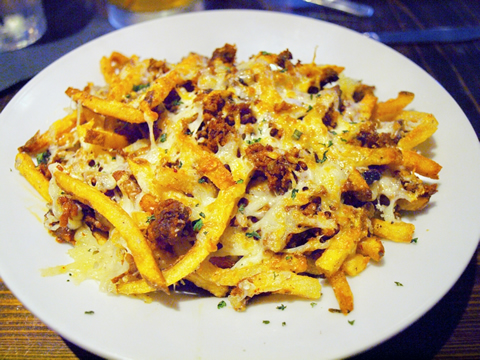
Capdeville. CBD: 520 Capdeville St. 504-371-5915.
This is among the 500 best dishes in New Orleans area restaurants. Click here for a list of the other 499. [divider type=""] July 12, 2017
July 12, 2017
Days Until. . .
Satchmo Summer Fest 22
Masters Of Food Research
George Washington Carver was born today in 1864, as a slave. He became one of history's greatest botanists, gaining particular renown because his discoveries benefited poor farmers. He first advocated the more widespread planting of sweet potatoes by showing all the things it could be used for. He then moved to his most famous specialty: peanuts. He showed not only that peanuts could be used in hundreds of different ways, but also that growing them improved the soil. He did all this while constantly fighting people who wouldn't take advice from a former slave. His work spoke for itself, however, and by the 1920s, his reputation as a great man was beyond dispute.
Food Calendar
 In honor of George Washington Carver, today ought to be National Peanut Something Or Other Day. But there are already many peanut observances on the calendar. And it's also National Pecan Pie Day. Pecan pie is one of the finest desserts in all of Southern cooking. We eat our share of it in New Orleans. The most famous local pecan pie is the one at the Camellia Grill. Like everything there, it's a pretty simple recipe. Pecan pie is not easy to make; the problem many cooks have is in getting the custard mixture to set. For that reason, for a long time one of New Orleans' best restaurants (you'd be shocked if I told you who, but I won't) took Mrs. Smith's pies out of their boxes, sliced them up, and served them.
In honor of George Washington Carver, today ought to be National Peanut Something Or Other Day. But there are already many peanut observances on the calendar. And it's also National Pecan Pie Day. Pecan pie is one of the finest desserts in all of Southern cooking. We eat our share of it in New Orleans. The most famous local pecan pie is the one at the Camellia Grill. Like everything there, it's a pretty simple recipe. Pecan pie is not easy to make; the problem many cooks have is in getting the custard mixture to set. For that reason, for a long time one of New Orleans' best restaurants (you'd be shocked if I told you who, but I won't) took Mrs. Smith's pies out of their boxes, sliced them up, and served them.
Gourmet Gazetteer
Peach Hill rises 180 feet above sea level, forty miles west of Boston, Massachusetts. There is no higher spot anywhere between the two places. The hill is thoroughly wooded, but houses are evenly spaced along Peach Hill Road and the other highways in the area. A mile north is the Bolton Road House Bar and Grill for a pop and a nosh.
Exercising The Food Away
Today is the birthday of fitness and exercise comedian Richard Simmons. He's a New Orleans guy, and succumbed to the common local condition of enjoying food so much that he became quite pudgy. When he got into exercise, the zeal of the converted propelled him onto television, where he works his way to the edge of embarrassment for laughs. Here's his website.
Annals Of Food Advertising
The Green Giant trademark was registered today in 1927. Originally, it was applied to a variety of extra-large peas, but the brand had such resonance that it was extended to package all kinds of vegetables.
Deft Dining Rule #184
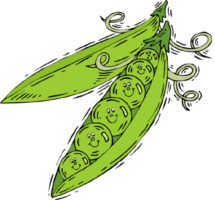 If you want to throw off an overbearing waiter, ask him if the peas on the dish that has them (there always seems to be one) are genuine Green Giant peas.
If you want to throw off an overbearing waiter, ask him if the peas on the dish that has them (there always seems to be one) are genuine Green Giant peas.
Annals Of The Dinner Table
Josiah Wedgwood was born today in 1730. He was a fanatical perfectionist in the art of pottery, leading him produce the fine dinner china that still bears his name. You know--the plates you were given when you got married, but have never actually used? Wedgwood was also the grandfather of Charles Darwin.
Edible Dictionary
rollmops, n.--Pickled herring, rolled around pickled cucumbers and onions. The roll is pickled by marinating in vinegar and mustard for a few days. Although the roll part of the word is clear, rollmops have no resemblance to a mop. "Mops" is German for "dog's head," which clears up nothing. Rollmops are most often seen in kosher-style delicatessens as well as German ones. Pickled herring, in places like New Orleans where it's never seen, is among the most underrated of delicacies.
Food Namesakes
Willis Eugene Lamb, Jr., who won the Nobel Prize in Physics in 1955, was born today in 1913. . . Eugene Louis Boudin came out of the casing today in 1824. He was a French Impressionist painter. . . Film director Tod Browning heard "action!" today in 1880. . . Gospel singer Sandi Patty (I think I've had one of those from a burger joint at the beach) got the spirit today in 1956. . . British comedian Richard Herring got his first laugh today in 1967.
Words To Eat By
"I never did like chitlins. I think they spelled it wrong."
"The least-used sentence in the English language is, 'Can I have your beets?'"--Both these by Bill Cosby. Unfortunately, quotations from Cosby--and there are many good ones related to food--have become taboo. He was born today in 1937, for what that's worth.
Words To Drink By
"To eat, to drink, and to be merry."--A toast from Ecclesiastes, 8:15.
[divider type=""]

The Recipe For A Certain Kind Of Funeral.
Eight legs, plus the aforementioned lemon and butter.Click here for the cartoon.
[divider type=""] #### Sunday. June 25, 2017. 8:00 a.m.This is the big sightseeing day for the Fitz Family. We begin with our longtime tradition of a big breakfast. The Marys are intrigued by the Tartine Manufactory, a much-praised baker of hand-made sourdough and other breads and pastries. We can see that they're not exaggerating the artisan quality of these loaves, because our table is a few feet from the mammoth ovens. The aroma of the breads is so alluring that all the girls buy a loaf just for their own uses.
The popularity of Tartine is such that MA must use all her wiles to nail down a table for us. The service is less than welcoming --you have to fend for yourself. That is especially true at the between-breakfast-and-lunch time we are there. Once everything is ordered and paid for, however, we enjoy an array of hybrids of sandwiches and omelettes, punctuated by pastries and good coffee. We take a tour of the bakery. Mary Leigh, a near-professional baker, was especially fascinated by everything Tartine, which she already loved enough to have a couple of cookbooks from the place.
We depart from there with Jude at the helm to drive through Golden Gate Park, across the famous bridge, then into the Muir Woods, north of the Gate. It's a long drive, winding around on a narrow road in search of. . . what? Jude somehow knows the way, and we keep driving until we get to a spot with both redwood trees and access to the ocean and a beach. MA reports that the water is very cold. I wasn't for one second going to sample that.
3:46 p.m. It is now that Jude reveals that he has no idea which way is out from Muir Woods. We just turn around and exit the way we entered. The plan was to visit Sausalito, the folksy community across the bay from the city, but it is decreed that there's not enough time. Instead, Jude, Suzanne, and Jackson all go to a children's science and arts presentation, adjacent to some fertile fishing piers and almost under the Golden Gate Bridge. The Marys and I walk around in the hot, glaring sun (I still haven't found a pair of clip-on sunglasses) until I feel a sunburn coming on.
Next we begin a random tour of the Presidio end of the city. Here we stop and walk around in the Palace of Fine Arts, a striking piece of architecture with no obvious utility. At least I am getting my quota of walking accomplished.
We wove through the steep streets until we find Taco-Licious, a new Mexican place that Jude somehow knew about. The appeal of this place was lost on me, but the others--notably Mary Leigh and Jude--found it exciting. A jarring moment occurred when a loud burst came from just outside. This proved to be a big, loud motorcycle starting up. If you have a motorcycle, you can do anything in California. I am especially put off by the way cyclists can ride between streams of traffic, even on freeways at top speed.
7:00 p.m. ML returns to work tomorrow. She leaves for home tonight on a redeye flight--using a buddy pass. On standby. Even though many seats are available, a glitch causes her to miss her flight. Luckily, there's another flight an hour later, and she makes that one.
Back in San Francisco, MA decides to keep the rental car and head out on an excursion on her own. With a dead cell phone. And my phone in her hand. I start worrying at around nine. To calm down, I decide that she will walk in at about 10:30.
10:08 p.m.Mary Ann returns. She wanted to check out the Presidio. Not much, she says. It's cool, with a Disney Museum, in old military buildings. And the Golden Gate Bridge in the background.
Monday. June 26, 2017. 7:00 a.m. It's our last morning to be awakened by the sound of the cable cars. Love that sound! Still no coffee in the room. I walk across the street to where a restaurant managed by a former New Orleans fellow used to specialize in breakfast. All gone now. I decide to just wait for the inevitable breakfast ideas of the others. Surely between Jude and Mary Ann an oddball café will be offered, even if it may require going well out of our way from the hotel to the airport.
8:47 a.m. "Outerlands" is the name of the restaurant. Jude found by way of a favorable review in a newspaper. It's not far from the waterfront, on the route of the commuter trains from south. These short trains are very entertaining to Jackson's eyes. My grandson likes trains!
The Outerland menu is decidedly West Coast in its tastes, but not far out. Among the choices are: Today's Doughnut; a sandwich of pork shoulder, pastrami and Swiss cheese; warm mushroom broth with brown rice and greens; and a cast-iron grilled cheese sandwich. I have a malted waffle with walnut and strawberries. We occupy a large bench for a long time.
10:20 a.m.Then we go to the airport. How Jude maneuvered there is a mystery, but I'm glad he's at the wheel instead of me. He and Suzanne and Jackson and I are on the same flight back to Los Angeles. Mary Ann is on her own, as usual. Everything is calm and conventional. There's even a kid's indoor playground next to our gate. Jackson has a fun time with the other kids, even the ones bigger than he is.
11:00 a.m.Then we board.
11:22 a.m. Then we sit there for awhile.
11:46 a.m. Then the captain says there is a hydraulic problem. The engineers come in from ten minutes away. They find another hydraulic problem. They test again. And yet a new bogus reading comes up. The attendants pass out cups of water. They seem very sober. Some of the passengers can be heard saying that they want off this plane.
Noon And then the captain says that the hydraulics are not the problem, but a goobered-up gauge. Now that they have it metered up, everything is okay. It takes a long time in line with the other airplanes before we find out for sure whether all is well. Apparently, it was.
1:22 p.m. I lead the applause when we land in Los Angeles in one piece. Funny habit of mine.
1:34 p.m. Jude picks up his car from the garage, where he has arranged to have it washed and detailed. He delivers all of us home, and all lives except mine return to normal.
Tuesday. June 27, 2017. 6:45 a.m. I have not spent many nights in the abode of Jude, Suzanne and Jackson (JS&J). But I know what I must do and must not do. Essentially, I must avoid awakening Jackson from his midday nap (easy: I take my own nap at the same time), and especially from his overnight sleep. (Around seven-thirty.) Also, I must not arouse the two little dogs that live in the back yard. With the exception of one night when I took a wrong turn in the darkness and briefly awakened Jackson, I committed no sins for the next two mornings.
Jude asks me to scramble some eggs for Jackson and to keep my eye on his oatmeal. Meanwhile, I make coffee from Jude's Nespresso machine. Then the nanny shows up. Jude and Suzanne leave for the day. And I am pulled into light service as baby sitter/grandfather. Call me "Poppy." In this I am replacing "Emmie," the aval name adopted by Mary Ann. In no other way can I fill in for my wife in the parental department. She is simply the best when it comes to little kids having fun.
Jackson and I have hit it off pretty well, though, and for the next three days I am his constant playmate. We do a lot of reading, piano playing, and running around. Last time I saw him, he wasn't walking. Now he's not only running but zooming around every environment we find ourselves in.
It's a long time since I played this role. I am inept when it come to matters like changing diapers. Soon, I remember what the late Ted Brennan said to me after Jude was born. "You are not Mr. Food. You are not a restaurant critic. You are not the guy on the radio. The only thing you are now is Jude's daddy, period!" That proved very true back then, and once again now.
So we play all day long, without a stop. Occasionally I have to keep him away from dangers. The ballpoint pen at eye level that he insisted on running around with, for example. He showed his strength by resisting my efforts and screaming at me.
Other than such moments, we are the best of friends for the next three days. I'm pleased that he doesn't run to his parents' sides when they come home. He likes me, and I like him.
[divider type=""]
Sunday. June 25, 2017. 8:00 a.m.This is the big sightseeing day for the Fitz Family. We begin with our longtime tradition of a big breakfast. The Marys are intrigued by the Tartine Manufactory, a much-praised baker of hand-made sourdough and other breads and pastries. We can see that they're not exaggerating the artisan quality of these loaves, because our table is a few feet from the mammoth ovens. The aroma of the breads is so alluring that all the girls buy a loaf just for their own uses.
The popularity of Tartine is such that MA must use all her wiles to nail down a table for us. The service is less than welcoming --you have to fend for yourself. That is especially true at the between-breakfast-and-lunch time we are there. Once everything is ordered and paid for, however, we enjoy an array of hybrids of sandwiches and omelettes, punctuated by pastries and good coffee. We take a tour of the bakery. Mary Leigh, a near-professional baker, was especially fascinated by everything Tartine, which she already loved enough to have a couple of cookbooks from the place.
We depart from there with Jude at the helm to drive through Golden Gate Park, across the famous bridge, then into the Muir Woods, north of the Gate. It's a long drive, winding around on a narrow road in search of. . . what? Jude somehow knows the way, and we keep driving until we get to a spot with both redwood trees and access to the ocean and a beach. MA reports that the water is very cold. I wasn't for one second going to sample that.
3:46 p.m. It is now that Jude reveals that he has no idea which way is out from Muir Woods. We just turn around and exit the way we entered. The plan was to visit Sausalito, the folksy community across the bay from the city, but it is decreed that there's not enough time. Instead, Jude, Suzanne, and Jackson all go to a children's science and arts presentation, adjacent to some fertile fishing piers and almost under the Golden Gate Bridge. The Marys and I walk around in the hot, glaring sun (I still haven't found a pair of clip-on sunglasses) until I feel a sunburn coming on.
Next we begin a random tour of the Presidio end of the city. Here we stop and walk around in the Palace of Fine Arts, a striking piece of architecture with no obvious utility. At least I am getting my quota of walking accomplished.
We wove through the steep streets until we find Taco-Licious, a new Mexican place that Jude somehow knew about. The appeal of this place was lost on me, but the others--notably Mary Leigh and Jude--found it exciting. A jarring moment occurred when a loud burst came from just outside. This proved to be a big, loud motorcycle starting up. If you have a motorcycle, you can do anything in California. I am especially put off by the way cyclists can ride between streams of traffic, even on freeways at top speed.
7:00 p.m. ML returns to work tomorrow. She leaves for home tonight on a redeye flight--using a buddy pass. On standby. Even though many seats are available, a glitch causes her to miss her flight. Luckily, there's another flight an hour later, and she makes that one.
Back in San Francisco, MA decides to keep the rental car and head out on an excursion on her own. With a dead cell phone. And my phone in her hand. I start worrying at around nine. To calm down, I decide that she will walk in at about 10:30.
10:08 p.m.Mary Ann returns. She wanted to check out the Presidio. Not much, she says. It's cool, with a Disney Museum, in old military buildings. And the Golden Gate Bridge in the background.
Monday. June 26, 2017. 7:00 a.m. It's our last morning to be awakened by the sound of the cable cars. Love that sound! Still no coffee in the room. I walk across the street to where a restaurant managed by a former New Orleans fellow used to specialize in breakfast. All gone now. I decide to just wait for the inevitable breakfast ideas of the others. Surely between Jude and Mary Ann an oddball café will be offered, even if it may require going well out of our way from the hotel to the airport.
8:47 a.m. "Outerlands" is the name of the restaurant. Jude found by way of a favorable review in a newspaper. It's not far from the waterfront, on the route of the commuter trains from south. These short trains are very entertaining to Jackson's eyes. My grandson likes trains!
The Outerland menu is decidedly West Coast in its tastes, but not far out. Among the choices are: Today's Doughnut; a sandwich of pork shoulder, pastrami and Swiss cheese; warm mushroom broth with brown rice and greens; and a cast-iron grilled cheese sandwich. I have a malted waffle with walnut and strawberries. We occupy a large bench for a long time.
10:20 a.m.Then we go to the airport. How Jude maneuvered there is a mystery, but I'm glad he's at the wheel instead of me. He and Suzanne and Jackson and I are on the same flight back to Los Angeles. Mary Ann is on her own, as usual. Everything is calm and conventional. There's even a kid's indoor playground next to our gate. Jackson has a fun time with the other kids, even the ones bigger than he is.
11:00 a.m.Then we board.
11:22 a.m. Then we sit there for awhile.
11:46 a.m. Then the captain says there is a hydraulic problem. The engineers come in from ten minutes away. They find another hydraulic problem. They test again. And yet a new bogus reading comes up. The attendants pass out cups of water. They seem very sober. Some of the passengers can be heard saying that they want off this plane.
Noon And then the captain says that the hydraulics are not the problem, but a goobered-up gauge. Now that they have it metered up, everything is okay. It takes a long time in line with the other airplanes before we find out for sure whether all is well. Apparently, it was.
1:22 p.m. I lead the applause when we land in Los Angeles in one piece. Funny habit of mine.
1:34 p.m. Jude picks up his car from the garage, where he has arranged to have it washed and detailed. He delivers all of us home, and all lives except mine return to normal.
Tuesday. June 27, 2017. 6:45 a.m. I have not spent many nights in the abode of Jude, Suzanne and Jackson (JS&J). But I know what I must do and must not do. Essentially, I must avoid awakening Jackson from his midday nap (easy: I take my own nap at the same time), and especially from his overnight sleep. (Around seven-thirty.) Also, I must not arouse the two little dogs that live in the back yard. With the exception of one night when I took a wrong turn in the darkness and briefly awakened Jackson, I committed no sins for the next two mornings.
Jude asks me to scramble some eggs for Jackson and to keep my eye on his oatmeal. Meanwhile, I make coffee from Jude's Nespresso machine. Then the nanny shows up. Jude and Suzanne leave for the day. And I am pulled into light service as baby sitter/grandfather. Call me "Poppy." In this I am replacing "Emmie," the aval name adopted by Mary Ann. In no other way can I fill in for my wife in the parental department. She is simply the best when it comes to little kids having fun.
Jackson and I have hit it off pretty well, though, and for the next three days I am his constant playmate. We do a lot of reading, piano playing, and running around. Last time I saw him, he wasn't walking. Now he's not only running but zooming around every environment we find ourselves in.
It's a long time since I played this role. I am inept when it come to matters like changing diapers. Soon, I remember what the late Ted Brennan said to me after Jude was born. "You are not Mr. Food. You are not a restaurant critic. You are not the guy on the radio. The only thing you are now is Jude's daddy, period!" That proved very true back then, and once again now.
So we play all day long, without a stop. Occasionally I have to keep him away from dangers. The ballpoint pen at eye level that he insisted on running around with, for example. He showed his strength by resisting my efforts and screaming at me.
Other than such moments, we are the best of friends for the next three days. I'm pleased that he doesn't run to his parents' sides when they come home. He likes me, and I like him.
[divider type=""]
 Char-Broiled Oysters @ Drago's
Char-Broiled Oysters @ Drago's
It's a simple dish. That fact kept fancy restaurants from offering it until the it became such a phenomenon that almost every restaurant with a local theme had to add it to the menu. Shucking oysters is the first step, and most chefs don't want any part of that. So it fell to the city's great oyster specialist to create and serve them, by the hundreds of sacks per week, to people willing to wait quite some time for them. Are they really as good as all that? Yes. Why? Because the oysters are so good. Which also explains why other restaurants never quite get it up to Drago's standard.
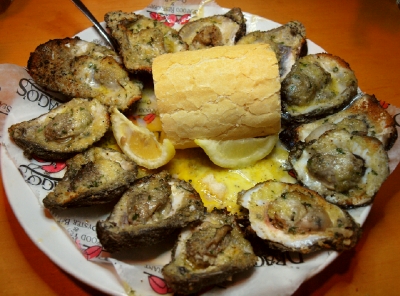 In the unlikely case that you never had them before, Drago's char-broiled oysters are shucked fresh, blasted by fire and steam on an open grill, basted with a lot of garlic-herb butter, dusted with Parmigiano cheese, and left on the grill till the juices bubble. Simple, yes. But so good that you can eat dozens of them and still want more.
There's a reason we chose Drago's today as the source of one of our 500 Best Restaurant Dishes, even though char-broiled oysters Drago's style is so widely known that not much more can be said.
Recently, Drago's in Metairie opened a new dining room, one that can hold about 150 more people and doubling the size of the place. What did they need that for? Anyone who has ever dined at Drago's knows the answer to this: the wait for a table was so long as to become a deterrent. I have little doubt that the restaurant will remain busy, but the turnover should be much quicker, a very welcome improvement.
The restaurant's slogan makes a big but true statement: "the best single bite of food in New Orleans." Yup, I'd go along with that.
In the unlikely case that you never had them before, Drago's char-broiled oysters are shucked fresh, blasted by fire and steam on an open grill, basted with a lot of garlic-herb butter, dusted with Parmigiano cheese, and left on the grill till the juices bubble. Simple, yes. But so good that you can eat dozens of them and still want more.
There's a reason we chose Drago's today as the source of one of our 500 Best Restaurant Dishes, even though char-broiled oysters Drago's style is so widely known that not much more can be said.
Recently, Drago's in Metairie opened a new dining room, one that can hold about 150 more people and doubling the size of the place. What did they need that for? Anyone who has ever dined at Drago's knows the answer to this: the wait for a table was so long as to become a deterrent. I have little doubt that the restaurant will remain busy, but the turnover should be much quicker, a very welcome improvement.
The restaurant's slogan makes a big but true statement: "the best single bite of food in New Orleans." Yup, I'd go along with that.
Drago's. CBD: 2 Poydras. 504-584-3911.
||Metairie: 3232 N Arnoult Rd. 504-888-9254. This is among the 500 best dishes in New Orleans area restaurants. Click here for a list of the other 499. [divider type=""]
Drago's Char-Broiled Oysters
Drago Cvitanovich has been the oyster king of New Orleans for four decades--and that's saying something. Like most other people in the oyster business, he was a Croatian immigrant. When he opened his restaurant in the 1970s, he kept his ties with his countrymen down the river, and as a result always had the best oysters available. Drago's son Tommy, who now runs the restaurant, created this dish in the early 1990s. It became wildly popular, and restaurants all over town now copy the dish. It's simple enough. The only tough part is obtaining oysters of Drago's quality (sometimes you can get them directly from the restaurant), and then opening them. Don't attempt this without freshly-shucked oysters and an outdoor grill. This is the perfect dish for those who want to enjoy oysters in their unadorned form, but can't or won't eat raw. Once you start eating these, you won't be able to stop. My personal best is four and a half dozen. By the way, this recipe is the real McCoy. Tommy Cvitanovich has never kept it a secret, for this reason: "You may have the right recipe, but you don't have my oysters."
- 2 lb. butter, softened
- 1/2 cup finely chopped fresh garlic
- 1 Tbs. black pepper
- 1 tsp. dried Italian seasoning
- 6 dozen oysters on the half shell
- 1 cup grated Parmesan and Romano cheeses, mixed
- 3 Tbs. chopped parsley
1. Mix butter with the garlic, pepper, and Italian seasoning.
2. Heat a gas or charcoal grill and put oysters on the half shell right over the hottest part. Spoon the seasoned butter over the oysters enough so that some of it will overflow into the fire and flame up a bit.
3. The oysters are ready when they puff up and get curly on the sides. Sprinkle the grated Parmesan and Romano and the parsley on top. Serve on the shells immediately with hot French bread.
Serves eight to twelve normal people, or two serious oyster fanatics.
[divider type=""]
 July 11, 2017
July 11, 2017
Days Until. . .
Satchmo Summer Fest 23
Celebrity Restaurateurs Today
Drago Cvitanovich was born today in 1922, in a small town near Split, Yugoslavia (now Croatia). He moved to Louisiana along with many of his countrymen, and joined the oyster industry in Plaquemines Parish. He moved to New Orleans in the 1950s, and worked for a time at a restaurant owned by his brother-in-law Drago Batinich. Drago C. opened his own place (also called Drago's) in 1969, in what later became Fat City. Drago C. passed away February 4, 2017.
[caption id="attachment_38364" align="alignleft" width="159"]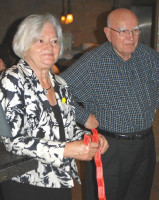 Klara and Drago Cvitanovich.[/caption]
The new Drago's menu was half seafood and half Croatian food. It was also half-full, on a busy day. Its specialty always has been oysters. Drago handled that end of the business personally, drawing on his contacts with the oystermen in Empire and thereabouts. The restaurant's success was a long time in coming, but it did come--especially after it invented char-broiled oysters. That was such a phenomenon that it's as widely imitated as barbecue shrimp or oysters Rockefeller. Now, led by Drago's son Tommy, Drago's is one of the most successful restaurants in town.
Klara and Drago Cvitanovich.[/caption]
The new Drago's menu was half seafood and half Croatian food. It was also half-full, on a busy day. Its specialty always has been oysters. Drago handled that end of the business personally, drawing on his contacts with the oystermen in Empire and thereabouts. The restaurant's success was a long time in coming, but it did come--especially after it invented char-broiled oysters. That was such a phenomenon that it's as widely imitated as barbecue shrimp or oysters Rockefeller. Now, led by Drago's son Tommy, Drago's is one of the most successful restaurants in town.
Today's Flavor
 Today is National Blueberry Muffin Day. Beware: the "blueberries" in many commercial muffins are actually little bits of dried apple colored blue. However, a good blueberry muffin is wonderful. Make some: blueberry season is ending down here, but it spreads north trough the next couple of months. The most famous blueberry muffins in New Orleans were (and are) those baked at the Pontchartrain Hotel. Although the restaurant offerings of the Pontchartrain are much diminished from their glory days when the Aschaffenburg family owned the place, the blueberry muffins still go on. Actually, they're a little on the dry side, but they do make a breakfast something special.
Today is National Blueberry Muffin Day. Beware: the "blueberries" in many commercial muffins are actually little bits of dried apple colored blue. However, a good blueberry muffin is wonderful. Make some: blueberry season is ending down here, but it spreads north trough the next couple of months. The most famous blueberry muffins in New Orleans were (and are) those baked at the Pontchartrain Hotel. Although the restaurant offerings of the Pontchartrain are much diminished from their glory days when the Aschaffenburg family owned the place, the blueberry muffins still go on. Actually, they're a little on the dry side, but they do make a breakfast something special.
Gourmet Gazetteer
Nectar, Alabama is a town of 372 people forty miles north of Birmingham. It's in a very picturesque, prosperous farming and orchard area, in the foothills of the Great Smokies. Nectar is surrounded by a big, looping bend of the Locust Fork of the Black Warrior River, far upstream. A long, historic covered bridge crossed the river at Nectar until 1993, when it was burned down by vandals. Its memory lives on at the Covered Bridge Grill, three miles away from the center of Nectar.
Annals Of Dueling
Today in 1804, the most famous duel in American history came to a bad end when Aaron Burr killed Alexander Hamilton. Hamilton--the man most responsible for assembling the U.S. government as we know it--fell in Weehawken, New Jersey, across the Hudson from Manhattan. Burr, who came out of the deal with a badly damaged reputation, came to New Orleans, where he began starting other trouble. Now, of course, men challenge one another with knives in the kitchen (i.e., the Iron Chef).
Gambling And Food
Today in 1913, within walking distance of the Dueling Oaks, the New Orleans City Park Casino opened. It served as the central refreshment stand for the park (and still does). When we were kids, we associated a visit to City Park with the sno-balls, popcorn, and hot dogs we gleaned from the Casino. Then we climbed all over the big live oaks outside between merry-go-round rides and turns on the swings. Ah, innocent childhood.
Dressing Up For Dinner
Today is the birthday, in 1934, of Italian fashion designer Giorgio Armani. I wish I could wear one of his suits, but you need a certain kind of physique for those beautiful duds. Avid eaters rarely have such a shape.
Edible Dictionary
pippin, n.--An apple--generally a good one--from a tree grown from a seed. Since the apples on ungrafted seedling trees are almost never like the apple the seed came from, when a good apple results from such a tree it's considered a lucky break--a "pippin." (Most fruit from chance seedlings are very bad for anything but making cider.) The most famous American pippin is the Newtown pippin, a green apple from a tree that grew on Long Island, New York in the 1700s. Trees grafted from that one were grown throughout the American colonies. It is still considered one of the best of the green apples.
Annals Of Overeating
Former U.S. President William Howard Taft was sworn in today in 1921 as Chief Justice of the Supreme Court. He was the first and only man to head two major branches of the Federal government. He was the size of two men, at well over 300 pounds.
Treat Of The Day
Many locations of the 7-11 chain of convenience stores around the world will give you a free 7.11-ounce Slurpee today if you ask. Note the date.
Food In The Wild
Today in 2001, a patrolman in Vancouver was accosted by a duck who walked up and grabbed him by the pants leg. The duck kept pulling the cop, who kept breaking loose, down the street to a catch basin. There, in the drainage, were eight baby ducklings. The policeman fished them out with a vegetable strainer, and the reunited duck family resumed its walk to a nearby pond. I'm thinking of some tale of how delicious they all were in the police kitchen that night, but I can't bring myself to write it.
The Saints
Today is the feast day of St. Benedict, founder of the Benedictine monks, the first Christian monastic order, in the sixth century. His rule was "Pray and work." Cooking and baking have always been a big part of the work. The Benedictines at St. Joseph's Abbey near Covington bake an enormous amount of bread everyday, most of which they give away to the poor.
Food Namesakes
Bobby Rice, pop singer in the 1960s and 1970s, was born today in 1944. He was heard on the Fireballs' song Sugar Shack. . . Mel Appleby, of the rock duo Mel 'n' Kim, was born today in 1966. . . Blind Lemon Jefferson, one of the most influential early blues singers and guitarists, wailed for the first time today in 1897. . . Brazilian physicist Cesare Lattes discovered himself today in 1924. He discovered the pi meson, so small its filling could not be tasted.
Words To Eat By
"Mother: "It's broccoli, dear."
Child: "I say it's spinach, and I say the hell with it."--E. B. White, long-time New Yorker writer, born today in 1899.
Words To Drink By
"They never taste who always drink."--Matthew Prior, On a Passage in the Scaligerana.
[divider type=""]

The Least-Welcome Guest During The Holidays.
If she starts talking about her work during a dinner, bring out the earplugs.Click here for the cartoon.
[divider type=""] #### [title type="h2"]Leaving One's Heart In San Francisco. [/title] During mid-June this year all three generations of my family--starting with my wife Mary Ann and me--took a vacation in Los Angeles and San Francisco. Our son Jude, his wife Suzanne, and their 18-month-old son Jackson live in Los Angeles. To and from Los Angeles I traveled by rail on Amtrak's trains #1 and #2, the Sunset Limited, whose route passes through the heart of the American Southwest. During all parts of the trip I have kept the Dining Diary rigorously. Now I'm spilling it all out, as much as I can edit every day. Here is the fifth installment. (At the ends, I'll run them all together for the many people who have asked me to do that. )
Saturday. June 24, 2017. 8:00 a.m. Jude wants us to have breakfast at the grandest hotel in San Francisco. The Palace Hotel is well named. Its largest dining room is topped by an enormous glass dome some 100 years old. Very impressive. The breakfast is served mostly in a buffet, for which the charge is over forty dollars per person. The waiter seemed to be on our side, telling us which dishes to avoid if we want the lower price than the full feed. Some of us get it, some of us don't. It's my turn to pick up the check, which pushes past the $150 line.
The gang spreads out into the many stores on and around Market Street, San Francisco's answer to New Orleans's Canal Street. nearby. I split off to the nearest Walgreens, where I buy a razor and a quartet of shoe laces. I am also in need of a pair of clip-on sunglasses, but I only find that item where I don't desperately need it.
8:33 a.m. I have another goal. Market Street is served by antique streetcars. Some of them are from the same era as New Orleans's fleet on St. Charles Avenue. But I everything about those. More interesting are the 1940s-1950s modern streetcars. They looked like the General Motors transit buses that were everywhere until the 1960s. Among my geekiest interests, I'm fascinated by these machines. I spend a few minutes riding the streetcars up and down Market Street. I am particularly (and, my gang says, weirdly) in the thrall of the old streetcar doors and how they operate. Ask me about it someday.
Also here are the famous SF cable cars--an entirely different and older technology, amazing and unique. But I've been on those on other trips.
Meanwhile, the Marys and Jude walk around the financial and Mission districts. When we meet again, we drive down some of the steepest streets in SF. I mean some really scary ones, including the zig-zaggedy Lombard Street. We work our way back into the center of town, there to dine at Yank Sing. It's the best-known Chinese dim-sum restaurant in San Francisco. Carts roll up to your table, full of dozens of one- or two-bite appetizers of all kinds.
Indeed, you have to negotiate pronto. If you don't move quickly enough to turn the waiters' offerings aside, you find yourself with another little plate to eat, one that perhaps you were thinking of asking for. This runs up a tidy $260 for our gang of six. New Orleans doesn't have anything like this (although the Royal China near Dorignac's in Metairie has an excellent if smaller assortment).
Jude and Mary Ann are particularly fascinated by Yank Sing and its wares. It's been a long time since my last dinner here, and I come away with less on an impression. The jam-packed fining room is one reason for that, as is the rapid-fire moves of the waiters. But it's still engaging in its way.
3:28 p.m. We scatter after that, me to the St. Francis for a rest and to let my stomach to catch up. The planned restaurant for tonight is a vaunted Vietnamese place in the Ferry Building: The Slanted Door. I meet up with the gang after taking another streetcar to the ferry, checking out its door movements.
6:44 p.m. When I arrive at the Ferry Building, Mary Leigh and I run into one another. We walk up and down the interior and exterior halls of the place. We never found The Slanted Door. The others decide against the place anyway. We change plans. We were to have dinner tomorrow night at the Tadich Grill, the oldest restaurant in San Francisco. But we learn that the place is closed Sundays. We try to get in tonight, and we do.
The Tadich Grill dates back to the 1849s. It will feel comfortable to New Orleans diners, especially those who like me have a taste for the old bistros--Galatoire's, Antoine's, Arnaud's, and Tujague's. The Tadich is more like that last one than the others, but the similarities are many.
The front door is managed by the bartender and loose waiters, all of whom have a somewhat wise-guy approach. For example, one of the waiters--he looks just like New Orleans Mayor Mitch Landrieu--tells us just stand there until all six of us had ditched the car and were now within the waiter's eyeshot.
The Marys had this place figured as yet another old-pooperoo restaurant of the kind I like. So, to make its points, the Tadich had to put on a show for the Marys that we all agreed was the best dinner we had in this visit to San Francisco. Most of that magic was performed by a nicely-seared steak with some nice steakhouse sides. Jude, who put in the order, was especially thrilled, even though he had to pass the platter around.
7:33 p.m. My dinner was the best on the table. I start with a half-dozen oysters Rockefeller. As is usually the case when that dish turns up outside New Orleans, the oysters were topped with melted cheese over the classic green, buttery sauce. Different, but very good.
My entree was the same one I remember having when I last ate here about twenty-five years ago. Petralé sole is a smallish local flounder found in the seas around S.F. It's small enough that it took three fish to fill the plate. The sauce was a magnificent veloute, the kind of thing I will play with at home next time I find some nice fish that might work for this concept.
The waiter--an older guy who had the style I expected to find in a restaurant like this--was helpful, always on the move, and entertaining.
9:49 p.m.Back at the St. Francis, some of us go down to the pastry and coffee shop in the lobby. They bake all this in house, but that operation could use some more life. They have specialty coffees, but they're not very good at it. Most of the three days we are here, I remember that there's coffee down here--it might even be complimentary, I thought. It wasn't. U made do with the little coffee maker in the room. But even that effort is stymied. After the first morning, they never restocked the percolator again.
I'm sorry to say that the St. Francis, which I have called my favorite hotel in the world, is not the hotel I remember from the 1980s-2000s, when I came this way once or twice a year to cover the wine world.
On the positive side, I still love the sounds of the cable cars as they make the turn in front of the hotel all day and all night. And the beds are the most comfortable I've ever slept in. I probably will stay here again, unless MA is with me. I don't think she'd stay here again.
[divider type=""]
During mid-June this year all three generations of my family--starting with my wife Mary Ann and me--took a vacation in Los Angeles and San Francisco. Our son Jude, his wife Suzanne, and their 18-month-old son Jackson live in Los Angeles. To and from Los Angeles I traveled by rail on Amtrak's trains #1 and #2, the Sunset Limited, whose route passes through the heart of the American Southwest. During all parts of the trip I have kept the Dining Diary rigorously. Now I'm spilling it all out, as much as I can edit every day. Here is the fifth installment. (At the ends, I'll run them all together for the many people who have asked me to do that. )
Saturday. June 24, 2017. 8:00 a.m. Jude wants us to have breakfast at the grandest hotel in San Francisco. The Palace Hotel is well named. Its largest dining room is topped by an enormous glass dome some 100 years old. Very impressive. The breakfast is served mostly in a buffet, for which the charge is over forty dollars per person. The waiter seemed to be on our side, telling us which dishes to avoid if we want the lower price than the full feed. Some of us get it, some of us don't. It's my turn to pick up the check, which pushes past the $150 line.
The gang spreads out into the many stores on and around Market Street, San Francisco's answer to New Orleans's Canal Street. nearby. I split off to the nearest Walgreens, where I buy a razor and a quartet of shoe laces. I am also in need of a pair of clip-on sunglasses, but I only find that item where I don't desperately need it.
8:33 a.m. I have another goal. Market Street is served by antique streetcars. Some of them are from the same era as New Orleans's fleet on St. Charles Avenue. But I everything about those. More interesting are the 1940s-1950s modern streetcars. They looked like the General Motors transit buses that were everywhere until the 1960s. Among my geekiest interests, I'm fascinated by these machines. I spend a few minutes riding the streetcars up and down Market Street. I am particularly (and, my gang says, weirdly) in the thrall of the old streetcar doors and how they operate. Ask me about it someday.
Also here are the famous SF cable cars--an entirely different and older technology, amazing and unique. But I've been on those on other trips.
Meanwhile, the Marys and Jude walk around the financial and Mission districts. When we meet again, we drive down some of the steepest streets in SF. I mean some really scary ones, including the zig-zaggedy Lombard Street. We work our way back into the center of town, there to dine at Yank Sing. It's the best-known Chinese dim-sum restaurant in San Francisco. Carts roll up to your table, full of dozens of one- or two-bite appetizers of all kinds.
Indeed, you have to negotiate pronto. If you don't move quickly enough to turn the waiters' offerings aside, you find yourself with another little plate to eat, one that perhaps you were thinking of asking for. This runs up a tidy $260 for our gang of six. New Orleans doesn't have anything like this (although the Royal China near Dorignac's in Metairie has an excellent if smaller assortment).
Jude and Mary Ann are particularly fascinated by Yank Sing and its wares. It's been a long time since my last dinner here, and I come away with less on an impression. The jam-packed fining room is one reason for that, as is the rapid-fire moves of the waiters. But it's still engaging in its way.
3:28 p.m. We scatter after that, me to the St. Francis for a rest and to let my stomach to catch up. The planned restaurant for tonight is a vaunted Vietnamese place in the Ferry Building: The Slanted Door. I meet up with the gang after taking another streetcar to the ferry, checking out its door movements.
6:44 p.m. When I arrive at the Ferry Building, Mary Leigh and I run into one another. We walk up and down the interior and exterior halls of the place. We never found The Slanted Door. The others decide against the place anyway. We change plans. We were to have dinner tomorrow night at the Tadich Grill, the oldest restaurant in San Francisco. But we learn that the place is closed Sundays. We try to get in tonight, and we do.
The Tadich Grill dates back to the 1849s. It will feel comfortable to New Orleans diners, especially those who like me have a taste for the old bistros--Galatoire's, Antoine's, Arnaud's, and Tujague's. The Tadich is more like that last one than the others, but the similarities are many.
The front door is managed by the bartender and loose waiters, all of whom have a somewhat wise-guy approach. For example, one of the waiters--he looks just like New Orleans Mayor Mitch Landrieu--tells us just stand there until all six of us had ditched the car and were now within the waiter's eyeshot.
The Marys had this place figured as yet another old-pooperoo restaurant of the kind I like. So, to make its points, the Tadich had to put on a show for the Marys that we all agreed was the best dinner we had in this visit to San Francisco. Most of that magic was performed by a nicely-seared steak with some nice steakhouse sides. Jude, who put in the order, was especially thrilled, even though he had to pass the platter around.
7:33 p.m. My dinner was the best on the table. I start with a half-dozen oysters Rockefeller. As is usually the case when that dish turns up outside New Orleans, the oysters were topped with melted cheese over the classic green, buttery sauce. Different, but very good.
My entree was the same one I remember having when I last ate here about twenty-five years ago. Petralé sole is a smallish local flounder found in the seas around S.F. It's small enough that it took three fish to fill the plate. The sauce was a magnificent veloute, the kind of thing I will play with at home next time I find some nice fish that might work for this concept.
The waiter--an older guy who had the style I expected to find in a restaurant like this--was helpful, always on the move, and entertaining.
9:49 p.m.Back at the St. Francis, some of us go down to the pastry and coffee shop in the lobby. They bake all this in house, but that operation could use some more life. They have specialty coffees, but they're not very good at it. Most of the three days we are here, I remember that there's coffee down here--it might even be complimentary, I thought. It wasn't. U made do with the little coffee maker in the room. But even that effort is stymied. After the first morning, they never restocked the percolator again.
I'm sorry to say that the St. Francis, which I have called my favorite hotel in the world, is not the hotel I remember from the 1980s-2000s, when I came this way once or twice a year to cover the wine world.
On the positive side, I still love the sounds of the cable cars as they make the turn in front of the hotel all day and all night. And the beds are the most comfortable I've ever slept in. I probably will stay here again, unless MA is with me. I don't think she'd stay here again.
[divider type=""]

Tasso Shrimp
Chef Jamie Shannon died tragically at age 40, in the prime of his career as chef at Commander's Palace. He brought many unforgettable dishes to the menu. This one is one of the best. It looks simple: three shrimp on a minimal sauce. But it explodes with flavor. The tasso is a Cajun-style ham cured to be very spicy, smoky, and salty. It's used more as a seasoning than as a meat. I'd recommend Chef Paul Prudhomme's brand of tasso, easily available in local grocery stores and by mail order.
- 6 Tbs. softened butter
- Pinch of chopped garlic
- Pinch of chopped shallots (or onion)
- 1 Tbs. Crystal Hot Sauce
- 1 tsp. whipping cream
- 24 jumbo shrimp, shelled and deveined
- 4 oz. tasso, sliced into matchstick-size pieces
- 1 cup flour
- 1 Tbs. salt
- Vegetable oil for frying
- 1/4 cup pepper jelly
1. In a pan over medium-low heat, sauté garlic and shallots in a little butter for a minute. Add hot sauce and bring to a boil. Cook until very little liquid is left. Add cream and cook about one more minute.
2. Remove from the heat and whisk in the softened butter, a little at a time, until it takes on a creamy consistency. This is beurre blanc. Keep warm.
3. Cut a slit down the back of each shrimp and insert a strip of tasso. Close the slit with a toothpick.
4. Mix the salt into the flour in a wide bowl. Dust the shrimp with the seasoned flour.
5. In a skillet, fry the shrimp in oil heated to about 375 degrees. Drain.
6. Place the cooked shrimp in a bowl with the beurre blanc. Toss to coat.
7. Spread a thin film of pepper jelly on the bottom of a small dish and arrange three shrimp on each plate. Garnish with pickled okra or pickled green beans.
Serves eight.
[divider type=""]
 Roast Lamb Leg With Hummus @ Mona's Cafe
Roast Lamb Leg With Hummus @ Mona's Cafe
Although hummus is thought of as a dip or spread, it is also commonly used in Middle Eastern restaurants as a sauce, usually on roast lamb served in large cubes. Mona's is one of the best makers of hummus around New Orleans. They make an interesting variation on this with ground lamb and beef mixed together, made into patties and grilled. The sauce for this is sort of hummus without the chickpeas--just the sesame-seed paste called tahini, with some oil and lemon juice. (In some restaurants, that sauce is called taratour.) Even during the advent of upscale Middle Eastern restaurants, this version is impressive.
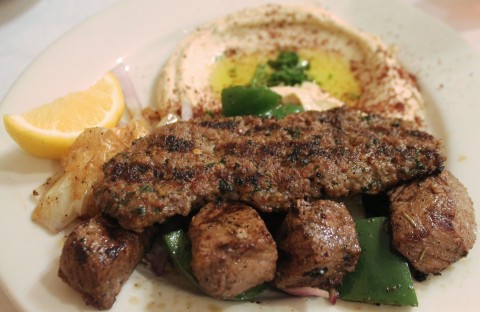
Mona's Cafe. Marigny: 504 Frenchmen. 504-949-4115.
||Mid-City: 3901 Banks. 504-482-7743. || This is among the 500 best dishes in New Orleans area restaurants. Click here for a list of the other 499. [divider type=""] July 10, 2017
July 10, 2017
Days Until. . .
Satchmo Summer Fest 24
Today's Flavor
Today is National Buffet Day. No restaurateur would serve a buffet if he could avoid it. But some restaurants can't get away from the all-you-can-eat curse. The Chinese restaurant category, for example, is going wholesale to buffet service.
The appeal is clear: quantity attracts a wider range of potential customers than quality does. Many diners suspend all their standards of goodness in order to let the all-you-can-eat miracle happen. But put the same food on a regular menu, and they stop coming.
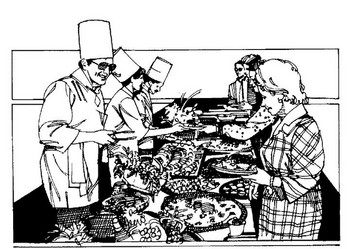 It's possible for infinitely large meals to be good. But it's not likely. Cooked dishes are at their best the minute they come off the stove. Then they go rapidly downhill as they cool and and dry out. Few dishes survive the stem table. (Red beans and soups are among those rarities.) And when quantity is the main draw, the added expense is made up for by depressing the intrinsic merit of the food. You don't see prime beef or organically grown vegetables much on buffets.
There are some good buffets. They're lavish in their cold dishes. They have roast-carving stations and setups where some dishes (eggs, most commonly) are cooked to order. The rest of the hot food is prepared in small batches. The desserts--which are made ahead in most restaurants anyway--are spectacular. But that kind of buffet is rare, and almost always more expensive than what you'd pay if ordering from a menu.
Service is rarely at its best in buffet restaurants. Servers in buffets are undertipped by their customers, who believe that, because they're fetching their own food, the tip should be lower. In fact, it should be higher than usual, because a) the server is doing everything he or she would do in an a la carte restaurant except getting the food and b) buffet diners eat much more and create more used serviceware than they would if ordering the same dollars' worth from a menu. No good waiter stays in an undertipping situation long.
Finally, there is the matter of overeating. Look at the waistlines of buffet fans. Is that above-average girth just a coincidence? Then get back to where the portions are controlled, the food is better, and the experience more pleasant.
It's possible for infinitely large meals to be good. But it's not likely. Cooked dishes are at their best the minute they come off the stove. Then they go rapidly downhill as they cool and and dry out. Few dishes survive the stem table. (Red beans and soups are among those rarities.) And when quantity is the main draw, the added expense is made up for by depressing the intrinsic merit of the food. You don't see prime beef or organically grown vegetables much on buffets.
There are some good buffets. They're lavish in their cold dishes. They have roast-carving stations and setups where some dishes (eggs, most commonly) are cooked to order. The rest of the hot food is prepared in small batches. The desserts--which are made ahead in most restaurants anyway--are spectacular. But that kind of buffet is rare, and almost always more expensive than what you'd pay if ordering from a menu.
Service is rarely at its best in buffet restaurants. Servers in buffets are undertipped by their customers, who believe that, because they're fetching their own food, the tip should be lower. In fact, it should be higher than usual, because a) the server is doing everything he or she would do in an a la carte restaurant except getting the food and b) buffet diners eat much more and create more used serviceware than they would if ordering the same dollars' worth from a menu. No good waiter stays in an undertipping situation long.
Finally, there is the matter of overeating. Look at the waistlines of buffet fans. Is that above-average girth just a coincidence? Then get back to where the portions are controlled, the food is better, and the experience more pleasant.
Deft Dining Rule #28
Food served buffet-style will never be as good as the same food from the same kitchen served on a plate at your table by a waiter.
The Old Kitchen Sage Sez:
Except red beans and rice, which will be better on the buffet.
Edible Dictionary
bechamel, French, n.--One of the "mother sauces" of classical French cooking used as a starting point for many other sauces. It's essentially a blonde roux with milk whisked in, with a pinch of nutmeg. Chefs from the old school insisted on straining it through cheesecloth to make it perfectly smooth. Bechamel adds richness and texture to a sauce or a dish (particularly gratins), without adding a foreground flavor. I like using it as a base for crab cakes and stuffings for things like eggplants or mushrooms. It's named for the Marquis de Bechamel, who employed a sauce like it in the cooking for Louis XIV's court.
Gourmet Gazetteer
Leek Creek flows south from some hills in northeastern Texas for about eighteen miles. Through intermediate streams its water flows into the Red River, then all the way across Louisiana into the Gulf of Mexico via the Atchafalaya. Lee Creek winds through swampy land near its southern end, with pine tree farms and hundreds of gas wells the main local activity. The nearest restaurants are twelve miles away, across the Louisiana state line in Vivian. Outlaw Bar-B-Q sounds logical.
Great Food Moments In Literature
Today is the birthday, in 1871, of Marcel Proust. He is the author of the seven-volume Recherche du Temps Perdu--usually mistranslated as Remembrance Of Things Past. The seemingly endless work (set aside a year at least to read it) is the reflective, image-laden, occasionally perverse recollection of the protagonist's past life. All of the memories are famously triggered when he has tea with the shell-shaped cookies called madeleines.
Food On The Air
American inventor Nicola Tesla was born today in Serbia in 1856. He was a mad genius who invented many of the major machines and concepts now used routinely in electronics today. His most famous contribution was alternating current, which makes it possible for you to read these words. He also was as important a figure in Marconi in the development of radio, for which I would like to thank him personally. Most recently, Tesla's name appears on the next generation of automobiles.
Annals Of Soft Drinks
Following a tremendous uproar from customers, today in 1985 the Coca-Cola Company returned the original formulation of Coke to the shelves, under the name Coca-Cola Classic. It quickly shoved New Coke off the market (except in New Coke's disguises, such as Cherry Coke, and Diet Coke, which still have the new flavor).
Brewmasters
Adolphus Busch, who founded Anheuser-Busch, the world's biggest maker of beer, was born today in 1839. I wonder how he would feel about the efforts of a Belgian brewer to take over his baby.
Music To Eat Dinner In The Diner By
Arlo Guthrie, who came to prominence with the rambling recording of the song-saga Alice's Restaurant, was born today in 1947. His biggest hit was The City of New Orleans, about the train of the same name.
Food Namesakes
Bernard Buffet, French artist and designer, was sketched out today in 1928. Interesting that his birthday coincides with National Buffet Day. . .Jason Orange, singer and dancer in the group Take That, was born today in 1970.
Words To Eat By
"I raised to my lips a spoonful of the cake . . . a shudder ran through my whole body and I stopped, intent upon the extraordinary changes that were taking place."--Marcel Proust, born today in 1871. "Most vegetarians look so much like the food they eat that they can be classified as cannibals."--Finley Peter Dunne, born today in 1867. "I went to this restaurant last night that was set up like a big buffet in the shape of an Ouija board. You'd think about what kind of food you want, and the table would move across the floor to it."--Steven Wright.
Words To Drink By
"Fill up the goblet and reach to me some!
Drinking makes wise, but dry fasting makes glum."
--William R. Alger, "Wine Song of Kaitmas."
[divider type=""]

Four And Twenty.
That's the number of blackbirds required to make the classic blackbird pie. But modern production and marketing methods are too powerful for tradition to remain undiluted.Click here for the cartoon.
[divider type=""] #### [title type="h3"]Sunset Training: New Orleans-Los Angeles-San Francisco[/title] June 21-28, 2017. During two recent weeks I was on vacation in Los Angeles and San Francisco. To and from home, I traveled by rail on Amtrak's trains #1 and #2, the Sunset Limited, whose route passed through the heart of the American Southwest. I kept my Dining Diary rigorously while on the road, which explains why subscribers didn't receive the New Orleans Menu Daily fpr those two weeks. I was writing like crazy, but couldn't put it out on the web until now.
Thursday, June 22, 2017. For a change, MA and I stay in JS&J's guest room instead of checking into a hotel. MA will wind up staying here for about a week, after which she flies back to New Orleans to guest-host the radio show during most of next Tuesday. She knows the rules of the house, especially as regards Jackson's quiet hours.
Breakfast is a big deal for Jude and Jackson. Jude makes perfect omelettes and oatmeal with berries for all who want them, with Jackson being the most avid taker. The main difference in Jackson's behavior since I last hung out with him six months ago is that he eats with gusto, devouring almost everything put in front of him. He's a much more enthusiastic eater than either his father or grandfather were.
1:43 p.m.--Jean-Georges Vongerichten is among the most celebrated restauteurs in America, with twenty-four establishments scattered in major cities around the country. They range from casual, alfresco dining to the most ambitious.
Mary Ann heard that JG recently opened two restaurants in the Waldorf Astoria Hotel in Beverly Hills. It wouldn't be a trip to LA for MA without at least a little gadding about in Beverly Hills. This location includes not only a serious gourmet room with a casual garden adjacent to it, but The Rooftop By JG, exactly where it said it was. We went up to take a look. It's quite a view from up there, but also very, very hot on this sunny day.
We returned downstairs, where it took us awhile to get a seat. As always, I found that I can accelerate the opening of a table by sitting down at a table (not a mere barstool) in the lounge. where I have a serious cocktail, while seemingly interested in the restaurant. The hour wait they at first offered shrank down by thirty-five minutes.
We started with a steamed artichoke, to which a mustardy sauce had been applied and a bouquet of frisee with a vinaigrette. MA sez: "A lovely, polished dish."
I was intrigued by the pea soup, brilliant in enough color and vivid flavor that any association with the standard split-pea soup might as well have suggested porridge. That was followed by black code, a fish we see most often in Japanese restaurant. This also involved a sauce with the same sort of brilliant green sauce that came with the pea soup. MA waited that out long enough for her to get the chocolate cake for dessert.
Most important, the place was beautiful. This semi-outdoor feeling is what MA most likes in her restaurants. And she liked being in the eatery of one of the superstar chefs. (Who, if he was there at all, was out of my sight.)
Let's do the numbers: $150, with the tip and tax. Worth it for my bride's full enjoyment of her kind of dining environment.
Afterwards, we went on a labyrinthine search for Ronald Reagan's house. Not my idea of a fine afternoon, but I just sit back and listen.
6:14 p.m.-- Sushi is a big deal in Los Angeles, and it's regularly on the menu for Jude and Suzanne. Their favorite place is Kabosu, a jammed little café in the Toluca Lake neighborhood. It's perfect for testing my standards for Japanese restaurants. These begin by going through the menu of chef's rolls. The less fake crabmeat in it, the better the restaurant. Kabosu had none. Zero. This test showed its validity when the sushi rolls came out. This was real wasabi, something we don't see a lot. I could tell this authenticity with my first bite, which all but blew me against the wall, as it should.
Jude suggests the lime roll, with a few different fish wrapped up with avocado, and the ends capped off by thin slices of the namesake citrus. I can't remember having encountered anything quite like this. I will have a couple of variations by the time I departed California.
Kabosu is Jude's and Suzanne's regular sushi place. Also on the menu here and elsewhere are excellent dumplings. Jude is a lover of dumplings, with a thing for them since he was a kid. I thought he food excellent, the service less so. The place was loaded with people, is why.
Kabosu. Toluca Lake (Los Angeles) CA. 818-623-4425.
[divider type=""]
June 21-28, 2017. During two recent weeks I was on vacation in Los Angeles and San Francisco. To and from home, I traveled by rail on Amtrak's trains #1 and #2, the Sunset Limited, whose route passed through the heart of the American Southwest. I kept my Dining Diary rigorously while on the road, which explains why subscribers didn't receive the New Orleans Menu Daily fpr those two weeks. I was writing like crazy, but couldn't put it out on the web until now.
Thursday, June 22, 2017. For a change, MA and I stay in JS&J's guest room instead of checking into a hotel. MA will wind up staying here for about a week, after which she flies back to New Orleans to guest-host the radio show during most of next Tuesday. She knows the rules of the house, especially as regards Jackson's quiet hours.
Breakfast is a big deal for Jude and Jackson. Jude makes perfect omelettes and oatmeal with berries for all who want them, with Jackson being the most avid taker. The main difference in Jackson's behavior since I last hung out with him six months ago is that he eats with gusto, devouring almost everything put in front of him. He's a much more enthusiastic eater than either his father or grandfather were.
1:43 p.m.--Jean-Georges Vongerichten is among the most celebrated restauteurs in America, with twenty-four establishments scattered in major cities around the country. They range from casual, alfresco dining to the most ambitious.
Mary Ann heard that JG recently opened two restaurants in the Waldorf Astoria Hotel in Beverly Hills. It wouldn't be a trip to LA for MA without at least a little gadding about in Beverly Hills. This location includes not only a serious gourmet room with a casual garden adjacent to it, but The Rooftop By JG, exactly where it said it was. We went up to take a look. It's quite a view from up there, but also very, very hot on this sunny day.
We returned downstairs, where it took us awhile to get a seat. As always, I found that I can accelerate the opening of a table by sitting down at a table (not a mere barstool) in the lounge. where I have a serious cocktail, while seemingly interested in the restaurant. The hour wait they at first offered shrank down by thirty-five minutes.
We started with a steamed artichoke, to which a mustardy sauce had been applied and a bouquet of frisee with a vinaigrette. MA sez: "A lovely, polished dish."
I was intrigued by the pea soup, brilliant in enough color and vivid flavor that any association with the standard split-pea soup might as well have suggested porridge. That was followed by black code, a fish we see most often in Japanese restaurant. This also involved a sauce with the same sort of brilliant green sauce that came with the pea soup. MA waited that out long enough for her to get the chocolate cake for dessert.
Most important, the place was beautiful. This semi-outdoor feeling is what MA most likes in her restaurants. And she liked being in the eatery of one of the superstar chefs. (Who, if he was there at all, was out of my sight.)
Let's do the numbers: $150, with the tip and tax. Worth it for my bride's full enjoyment of her kind of dining environment.
Afterwards, we went on a labyrinthine search for Ronald Reagan's house. Not my idea of a fine afternoon, but I just sit back and listen.
6:14 p.m.-- Sushi is a big deal in Los Angeles, and it's regularly on the menu for Jude and Suzanne. Their favorite place is Kabosu, a jammed little café in the Toluca Lake neighborhood. It's perfect for testing my standards for Japanese restaurants. These begin by going through the menu of chef's rolls. The less fake crabmeat in it, the better the restaurant. Kabosu had none. Zero. This test showed its validity when the sushi rolls came out. This was real wasabi, something we don't see a lot. I could tell this authenticity with my first bite, which all but blew me against the wall, as it should.
Jude suggests the lime roll, with a few different fish wrapped up with avocado, and the ends capped off by thin slices of the namesake citrus. I can't remember having encountered anything quite like this. I will have a couple of variations by the time I departed California.
Kabosu is Jude's and Suzanne's regular sushi place. Also on the menu here and elsewhere are excellent dumplings. Jude is a lover of dumplings, with a thing for them since he was a kid. I thought he food excellent, the service less so. The place was loaded with people, is why.
Kabosu. Toluca Lake (Los Angeles) CA. 818-623-4425.
[divider type=""]

Oysters Roland
Roland Huet was one of the most skillful French chefs ever to work in New Orleans. Born and trained in the Loire Valley of France, he fetched up in the 1960s at Galatoire's in the French Quarter. Chris Ansel--one of the family managers of Galatoire's--left in the 1970s to open his own restaurant, Christian's. Roland went with Chris, and created the menu that would make Christian's an essential restaurant. On it was this baked oyster appetizer. It remained until the restaurant came to an end with Hurricane Katrina. [caption id="attachment_55201" align="alignnone" width="480"]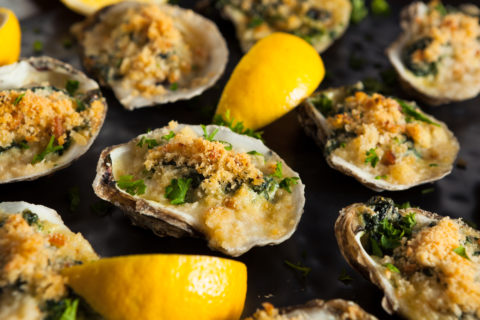 From the hand of Christian's longtime chef Roland Huet.[/caption]
From the hand of Christian's longtime chef Roland Huet.[/caption]
- 4 dozen medium oysters
- 1 bunch curly-leaf parsley, bottom stems removed
- 3 cloves garlic
- 8 oz. small mushrooms, well washed
- 1 lb. softened butter
- 1 tsp. salt
- 1 tsp. black pepper
- Generous pinch nutmeg
- 1 cup French bread crumbs
Preheat oven to 400 degrees.
1. Bring 1/2 cup of water to a light boil in a small skillet. Add the oysters and poach for two minutes. Strain the pan contents, reserving the liquid. Return the liquid to a light boil and reduce by about a third.
2. Put the parsley, garlic, mushrooms, salt, pepper, and nutmeg into a food processor, and process into a very fine mixture. Add the butter and process into a coarse gritty puree.
3. Add the bread crumbs and the reserved stock from the oysters and process only long enough to mix everything thoroughly.
4. Place six oysters in the bottom of each of eight small gratin dishes. With a spatula, lightly pack down enough sauce to cover the oysters completely, filling the dishes nearly to the top. (You can prepare the dish to this point ahead of time and hold in the refrigerator. Take them out of the refrigerator a half-hour before the final baking.)
5. Bake the gratins of oysters in a preheated 400-degree oven until the tops are distinctly browned and crusty, and the sauce is heaving and steaming. Serve immediately with hot French bread for getting up the extra sauce.
Makes eight appetizers.
[divider type=""]
 Crab Stack In Three Layers @ La Thai Cuisine
Crab Stack In Three Layers @ La Thai Cuisine
This sounds irresistible and insane at the same time. It works because La Thai is as much a Louisiana-style restaurant as a Thai explorer. And because this is a tower of crabmeat. . . and how far wrong could you go with that? The tower begins with a crab cake, forming the foundation. Then a soft-shell crab mounts the stack, to be topped with jumbo lump crabmeat. A Thai-style chili glaze amplifies all the flavors. For crab fanatics with exotic tastes. This will only get better as we advance into crab season and as the water temperatures warm.
La Thai Cuisine. Uptown: 4938 Prytania. 504-899-8886.
This is among the 500 best dishes in New Orleans area restaurants. Click here for a list of the other 499.[divider type=""] July 6, 2017
July 6, 2017
Days Until. . .
Satchmo Summer Fest 29
Food Calendar
Today is National Fried Chicken Day. In the 1960s and before, fried chicken was considered a gourmet dish, featured with total respect in fancy food magazines like Gourmet. Then, just as they did to the hamburger, the mass-production restaurants moved in on fried chicken and ruined its reputation. Fortunately, good fried chicken still exists, although it requires some diligence to either find it in a restaurant or make it yourself.
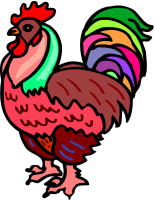 The main criterion of fried chicken excellence is the crust. Different from most fried foods, a crispy coating on fried chicken is not necessarily a good thing. The best fried chicken I've had in my life had a rather thin, non-crisp coating. What it did have, though, was an interesting flavor dominated by herbs, with pepper as a background flavor. Much of that flavor comes from marinating. I like to use buttermilk as a marinade, because it tenderizes as well as flavors the chicken. It also seems to make the coating stay on better.
The next two hallmarks of great fried chicken are that it comes out hot and greaseless. Those are both the result of the same kitchen skill. When chicken is fried and then held under a heat lamp--as it is in most restaurants--it gets soggy and greasy. Cooking it right before serving makes all that difference. This is something the fast-food operators can't abide, because frying a chicken takes fifteen or twenty minutes. Even Colonel Sanders knew that. As late as the Sixties (before it was bought by Pepsi) Kentucky Fried Chicken was fried to order. They did it in a pressure cooker to speed things up, but they did make it specially for you.
This is a very big subject, fried chicken.
The main criterion of fried chicken excellence is the crust. Different from most fried foods, a crispy coating on fried chicken is not necessarily a good thing. The best fried chicken I've had in my life had a rather thin, non-crisp coating. What it did have, though, was an interesting flavor dominated by herbs, with pepper as a background flavor. Much of that flavor comes from marinating. I like to use buttermilk as a marinade, because it tenderizes as well as flavors the chicken. It also seems to make the coating stay on better.
The next two hallmarks of great fried chicken are that it comes out hot and greaseless. Those are both the result of the same kitchen skill. When chicken is fried and then held under a heat lamp--as it is in most restaurants--it gets soggy and greasy. Cooking it right before serving makes all that difference. This is something the fast-food operators can't abide, because frying a chicken takes fifteen or twenty minutes. Even Colonel Sanders knew that. As late as the Sixties (before it was bought by Pepsi) Kentucky Fried Chicken was fried to order. They did it in a pressure cooker to speed things up, but they did make it specially for you.
This is a very big subject, fried chicken.
Deft Dining Rule #866
No restaurant where the surroundings seem to call for eating fried chicken with a knife and fork is a good place to eat fried chicken.
Gourmet Gazetteer
Catfish Bayou flows from the Mermentau River into Catfish Lake and Little Catfish Lake, both bays off the much larger Grand Lake in southwestern Louisiana. This is all wild, marshy, undeveloped land visited mostly by hunters, fishermen, and oilfield workers. Hurricane Rita did tremendous damage here shortly after Hurricane Katrina hit New Orleans. It's a long way to civilization, which you can best reach by boat. The nearest restaurant of interest is Poole's Boil and Go in Lake Arthur, eighteen miles north up the Mermentau.
Edible Dictionary
picnic, n.--The lower part of a pork shoulder, below the Boston butt. A picnic has much more bone and fat than the Boston butt does. It is neither as tender nor as useful for barbecuing or roasting. Indeed, it's quite difficult to cook it so that its tender enough to eat as is. The muscles are smaller, with a good deal of fat and connective tissue in between the sections. Its most common use is to flavor a soup, a pot of beans or greens, or to make sausage. It can also be cut up into small cubes for stir-frying, or run through the grinder.
People I Wish I'd Dined With
Today in 1918, the film and television actor Sebastian Cabot was born in London. He was a rotund, bearded fellow who liked New Orleans (he was a good friend of the Brennans) and was a connoisseur of good food. He was best known for the television show Family Affair, although I remember him most fondly as the host of the television version of the long-running radio series Suspense.
The Saints
Today is the feast day of St. Goar of Aquitaine, France. He lived in the sixth century, and is a patron saint of vinegrowers and hoteliers. It's also the feast day of St. Maria Goretti, who is much venerated in New Orleans as a patron saint of children.
Paying For Food
 Today is the birthday of the dollar. It was chosen to be the monetary unit of the United States by the Congress of the Confederation on this date in 1785 . We are approaching the day when it will become impossible to find anything on the menu of any restaurant that can be bought for a dollar. (It may surprise you to know that we aren't there yet.) One of these days, I'll make a list of the dates when certain benchmark dishes hit a dollar in price. I have a menu from Antoine's in the 1960s, for example, that shows oysters Rockefeller for a dollar. I sold six-packs of Jax Beer at the Time Saver in 1970 for a dollar. I remember being able to buy two roast beef poor boys at Martin's Poor Boy Restaurant for a dollar.
Today is the birthday of the dollar. It was chosen to be the monetary unit of the United States by the Congress of the Confederation on this date in 1785 . We are approaching the day when it will become impossible to find anything on the menu of any restaurant that can be bought for a dollar. (It may surprise you to know that we aren't there yet.) One of these days, I'll make a list of the dates when certain benchmark dishes hit a dollar in price. I have a menu from Antoine's in the 1960s, for example, that shows oysters Rockefeller for a dollar. I sold six-packs of Jax Beer at the Time Saver in 1970 for a dollar. I remember being able to buy two roast beef poor boys at Martin's Poor Boy Restaurant for a dollar.
Food Namesakes
The Cherry Venture--a Scandinavian cargo ship that became a tourist attraction on the Australian beach where it wrecked--ran aground there today in 1973. . . Former Illinois Governor John Lourie Beveridge was born today in 1824.
Words To Eat By
"Chicken may be eaten constantly without becoming nauseating."--Andre Simon, French-born British gourmet and wine merchant.
Words To Drink By
"The chief reason for drinking is the desire to behave in a certain way, and to be able to blame it on alcohol."--Mignon McLaughlin, The Neurotic's Notebook, 1960
[divider type=""]

Blessed Are Those Who Hunger. . .
. . . and thirst, for they will find something to eat and drink.Click here for the cartoon.
[divider type=""] ####
By Train: Sunset Limited, June 19-28, 2017
During the past two weeks I have been on vacation in Los Angeles, San Francisco, and in numerous venues throughout the American Southwest, a place I love. During the sojourn, I have kept my Dining Diary pretty rigorously. And here it is. The first part is largely about railroads, a longtime hobby of mine. As it goes on, it will shift to food I encountered along the way. June 19, 9:00 a.m.-Amtrak Train #1 leaves New Orleans Union Passenger Terminal. 9 a.m.-Train passes next to Jesuit High School baseball stadium. Something new since I was there. 9:21 a.m.-Train crosses Central Avenue, then begins to climb the approach to the Huey P. Long Bridge, the world’s longest railroad bridge. 9:30 a.m-Train crests the Huey P. Long Bridge peak and crosses the Mississippi River. 9:40 a.m.-Train back on terra firma. 9:47 a.m-Train passes through two large railroad yards, then enters an assortment of very dense woods alternating with sugar cane fields. The latter are all the same size, and line up uniformly 1:34-Bridges cross the bayous in the Des Allemands. This is where the best wild-caught catfish are fished locally, and where the name of the place is a mark of quality. 9 a.m-We run along the edges of the most extensive sugar cane fields we will see, extending to about half of the horizon. 9 a.m.-The sugar cane tapers out in favor of trees-mostly oak, often covered with Spanish moss-bushes, and an improbably large number of bayous, many of them connected with Bayou Lafourche, a former distributary of the Mississippi River. The train races along at speed; track is quite good, and sometimes very smooth. 10:35 a.m.-Train arrives in Schriever, the first stop on the westbound Sunset Limited, whose name is the oldest in the gazetteer of train names. When the train leaves Schriever, it is five minutes late. 10:53 a.m.-Train enters a swamp rooted in many 50-foot and taller trees, with standing water about eight inches deep and covered with bright greenish-yellows and magentas. Beautiful in its way. 11:00 a.m. Train crosses the Atchafalaya River at Berwick, where the Sunset Limited once derrailed into the river. There were fatalities, which is a rarity in passenger railroading. The bridge was rebuilt handsomely. 11:30 a.m. The train travels alongside of US 90, which follows almost all of the Sunset’s route. Here it especially obvious, what with the many businesses selling the needs of the petroleum industry. It can all get more than a little unpretty. I talk at length with a young woman who is learning the ropes of being a sleeper car attendant. We discuss trains and model trains. She says that model trains are the way grown-up men act like children. I resemble that remark. 11:40 a.m. We pass a freight train heading in the same direction as ours. It’s the third freight train we’ve encountered. The first was on the Huey P. Long bridge at the same time we were crossing the river. This train carries ninety-four cars behind four diesel units. We will see many more freight trains with many more cars. Many, many automobiles are among these shipments. I’m guessing, but it looked like around over a thousand automobiles are going one way or another. 12:18 p.m. We cross the New Iberia city limits. Here is the most flagrant example of what is called “street running.” The main line of a major intercontinental railroad shares the tracks with everyday street traffic. I saw a particularly bad such combination, our train heading west while five passenger automobiles moved slowly eastward. I watched it from the window of the Sunset Limited. 12:34 p.m. The dining car requires reservations, to keep everyone from trying to dine at the same time. I chose half-past noon. When I showed up, I was seated with a man and his six-year son. The boy has a sharp wit and an articulate speaking style. The third person is a young woman working on her PhD in Psychology. She’s quiet, but I think this owed entirely to big-mouthed males sitting with her. I order a quesadilla, which would have been better described as two flour tortillas with bacon and cheddar in front of it. I should have ordered the Korean pork sliders, and I will have the opportunity to do that tomorrow. The father of the sharp six-year old, after a few minutes, figures out who I am. He used to work as a sous chef at Carrollton Market. He also cooked at Cuvee and a few other first-class restaurants. The conductor on this train and an attendant in my sleeper car are others who ask me about I had no idea so many Amtrak people are into food. As the conversation went on, the dad with the chef credentials figured out who I am. That has almost never happened to me on a train. Meanwhile, the waiter neglected to bring the salad I asked for. I got even with him by not having dessert. (It didn’t appeal to me.) I go back to the roomette and mostly just stared at the window. Which is, of course, one of the more pleasant activities on a train. 13:34 p.m. Sooner or later I knew I would require a nap, since I was up before five this morning. I fold down the bottom seats and let it go at that. I slept about an hour and fifteen minutes, only until the dining room steward came by to ask when I’d like to have dinner. Six-thirty, I tell him, hoping as I do that the Amtrak steak is still there. It was delicious two years ago. 14:00 p.m. The train remains at the Lake Charles depot for a long time. A passenger needing to debark can’t be found on the train. Never found out what happened to her, but she is forgotten except by this diary and get rolling again on this hot, sunny day with our freezing-cold sleeper car. We slow down for a 114-car freight train, then go to Beaumont, Texas. This is the point at which the BNSF (Burlington Northern Santa Fe) gives way to the Union Pacific. The Union Pacific in these parts used to be the Southern Pacific. Indeed, the Southern Pacific ran the entire Sunset Route from its earliest years, until the UP bought it a few years ago. 4:30 p.m.The most miserable part of our rail route follows US 90 between Beaumont and Houston, where the 1927-vintage US highway number disappears in the center of the big city. It emerges from Houston on the west side of town, but not until going through some of the most distressing rail passageways I've ever seen. It’s in the northeastern part of the well-spread city and is highly industrial, with immense piles of what can only be called “material.” The railroad yard is made of what looks like at least thirty parallel , rusty, parallel lines of classification yards. It’s all ugly in a host of different ways. Only the handsomeness of the big buildings in central Houston lift one’s heart above all this junk. 5:28 p.m. We escape from that mess, but in so doing we learn that there was some sort of accident on our route somewhere along our route. The train sat waiting for this to be cleared up. The engineer tells us nothing. This is the big problem with passenger rail service. If a train or even a streetcar stops, action on other rails nearby stops dead. They can’t back out, they can’t shift to an adjacent track, they can’t do anything but wait either for what lies before us and what lies in back. 6:18 p.m. We start moving just as I have that thought. Am I glad. I am starting to think in a very pessimistic way. Almost as soon as we did, my name was called by the dining car for dinner. This cheers me up. I am seated with a young couple from Los Angeles, heading home after spending a good bit of time in New Orleans. They seemed to want to carry on their own conversation in hushed tones, I try to insert my thoughts into the conversation. As part of my appeal to my dining companions, I offer to share my bottle of Cabernet with them. They remain engaged with one another. I shift my attention to dinner. It begins with a salad composed of iceberg ribs and those lathe-carved fake baby carrots. Neither of which is easy to chew. Thing warm up in the entree section, from which I ordered the most expensive ($25) meal I’ve ever had aboard an Amtrak train. It’s a nicely-encrusted, juicy strip sirloin, served with a prefabricated but tolerable bearnaise saice. I never though I’d ever see the king of the French sauces in service on Amtrak, but here it is. This is served with little green beans and corn with tiny tomatoes, but this is good enough, I didn’t yet know that this same combination will turn up four more times during this trip. 7:44 p.m We roll along at a less-than brisk pace when, after the little passenger traffic that Houston’s railroad operation supports, we pull away with speed. After another twenty minutes, we stop again. This time I ask around as to what’s going on. Answer: a fire on a highway about half a mile away from the train is close enough to one of its tracks for the UP to send some of its conductors out to manually set the points that direct the train. Our train rolls over the joint gingerly, first in one place and a little later in a similar spot. And then we were off at last, with only brief stops until we reach US 90 ALT, which we follow until San Antonio. 8:50p.m. It is almost a dozen hours since we left New Orleans Union Passenger Terminal. Somehow, It feels more like three days. This is Tom’s Good-Time Stretching Theorem, which says that when you’re having a good time, the time will seem to pass longer than if you’re having a bad time. Which seems to be the opposite of the way it should be, but it always works for me. 8:57 p.m. I begin getting ready for bed, since I had only a short, sleepless nap a few hours ago. I fall asleep easily, even though I am being serenaded by “To Your Good Health, From Squibb.” This is a 1941 radio music show featuring vocalists whose musical tastes were popular as they are relaxing. It would probably be considered as opera or classical music. The thirty recordings I have of these fifteen-minute shows puts me right to sleep. I do awaken at half past eleven for the racket of putting two trains together. One of them is our Sunset Limited with the Golden Eagle. The latter came from Chicago, and will become part of the Sunset as it heads toward to Los Angeles as the longest train route in the Amtrak system. [divider type=""] Molé With Enchiladas And Chicken @ El Paso Mexican Grill
Molé With Enchiladas And Chicken @ El Paso Mexican Grill
El Paso is a new chain of Mexican places headquartered in Florida, but with most of its locations in Louisiana. Two of them are in the New Orleans area. This one recently took over the former Macaroni Grill in Mandeville, and with a few intentionally beat-up touches looks about the same. The menus at both this restaurant and the one in Metairie are about the same, except that that Mandeville branch has a more ambitious menu that includes--heavens be praised!--chicken with molé poblano. The legendary sauce is a thick, dark-brown concoction made from peppers, sesame, and bitter chocolate. It doesn't sound right, but this is one of the best sauces in the world. I'm neither exaggerating nor kidding. Molé shows up only rarely in the city's Mexican restaurants, and this version is as good as it gets.
El Paso Mexican Grill. Mandeville: 3410 Highway 190. Metairie: 601 Veterans Blvd, .
This is among the 500 best dishes in New Orleans area restaurants. Click here for a list of the other 499. [divider type=""]
Pulled Barbecued Pork Shoulder
The cut you want for this is pork shoulder (also known as "Boston butt"), with a strong preference for bone-in. Pork shoulder is very tough if you try to cook it quickly, but responds with a wonderful texture and flavor if it’s smoked slowly. The expression “pulled” means that the meat is not sliced but torn from the bone. In the case of pork shoulder, it comes off in lovely long morsels, perfect for sandwiches and not at all bad for a platter. Tongs are the usual tool for pulling the meat from the bone, but you can sometimes do it with a fork. On the other hand, even in Memphis--where this is the primary barbecue meat--lots of famous places chop it. That's considered a no-no among barbecue fanatics. Under no circumstances should barbecue sauce touch this until the pork is completely cooked. Unless you like a burned-sugar taste.
- Whole pork shoulders (Boston butt), as many as you want and will fit on the grill
- Marinade, per shoulder:
- 2 cloves garlic, pureed
- 1/4 cup Worcestershire sauce
- 1/4 cup honey
- 2 tsp. Tabasco chipotle pepper sauce
- Barbecue dry rub (recipe below)
- Creole barbecue sauce
1. A few hours before you start cooking (or the night before), cut the skin (if any) off the pork shoulder. Don't trim any more fat than what comes off with the skin. Brush the outside with the marinade.
2. Start a charcoal fire in your pit, with all the charcoal on one side of the grate. If you're using wood chips (which you will have to if using gas), wrap them in heavy aluminum foil and punch a few holes in the resulting packet.
3. Brush the shoulder with the marinade, then coat with a thick coating of dry rub. Place it as far away from the fire as you can, and drape a sheet of aluminum foil down to prevent direct heat from hitting the meat. Top the fire with the smoking wood. Put a pan of water over the fire and close the cover.
4. Maintain a temperature of about 175-200 degrees in the pit, adding fuel, wood and water as needed. After four hours, check the internal temperature by inserting a meat thermometer (without touching bone). You want to ultimately see 170 degrees, but if all goes well it won't get there for at least six hours. The longer it's in there, the better. Eight or ten or twelve hours is fine, as long as the pork isn't drying out.
5. But don't look at the clock. It's ready when you can pull the meat from the bone with tongs. When that happens, remove it from the pit, let it rest for about ten minutes, then pull away. Serve with your best barbecue sauce on the side.
Serves four to eight per shoulder.
[divider type=""]
 July 3, 2017
July 3, 2017
Days Until. . .
Fourth Of July 1
Music To Eat Gumbo By
It's the birthday (1930) of the late New Orleans jazz legend Pete Fountain. In addition to being a clarinet virtuoso, Pete was leader of the Half-Fast Walking Club, a fixture on Mardi Gras morning. Pete's dad was for years an oyster shucker at the old seafood restaurant Bozo's. He even owned a small restaurant (a hot dog stand) at one time, called Peter's Wieners, in Waveland. Good old Pete. A tremendously nice guy. He passed away on August 6, 2016, and is much missed.
Annals Of Food Writing
Today is the birthday (1908) of M.F.K. (Mary Frances Kennedy) Fisher, whom many consider to be the finest food American food writer of all time. She was widely traveled, a student of sensuality (all kinds), and highly literate. Born in Michigan, she lived most of her life in California, but was attached to France and spent a lot of her life there. Her books, while containing many recipes, are more about the pleasure of eating than the technique of cooking. And they are a great pleasure to read. A good starter is a book called The Art Of Eating, which compiles three books she wrote in the 1930s and 1940s. She kept at it until she died in 1992. In my files somewhere (although I have a bad feeling it was among the many archives I lost in my office after Hurricane Katrina) is a personal letter from Fisher I received in the early 1980s. A mutual friend gave her a subscription to the New Orleans Menu (it was a print newsletter at that time), and she wrote, "As a famous food writer I get many things from many writers, but for some reason I always make time to read your little magazine. It's very enjoyable." I have never been so thoroughly flattered.
Food At War
One of M.F.K. Fisher's books (How To Cook A Wolf) was written with the food shortages of World War II in mind. But we had it easy in the United States, compared with Europe. Today in 1954, after nine years, food rationing finally ended in England.
Looking Up
The Dog Days begin today, and hang on for forty more. The ancient Romans believed that when Sirius--the Dog Star, and the brightest star in the sky--came up at the same time as the sun, it made the weather hotter. Probably not, but here in New Orleans we hardly need to be told that this would be the most uncomfortable time of year were it not for universal air conditioning.
Food Calendar
It is Seafood With Beans Day. Fish and beans are a natural flavor and texture combination. The goodness of the match came to me a few years ago when, for some reason, I had three different dishes along those lines in as many days at various restaurants around town. I remember one was scallops and lentils at Ralph's on the Park, and another was redfish with crowder peas (or something like that) at GW Fins. In both cases, the seafood was on top of the beans, so the combination was unavoidable. After the third of the dishes (whatever it was), my eyes were opened. And I'd like to open yours. Next time you have some seafood and you're wondering what to serve with it, think beans. It inevitably works brilliantly.
Edible Dictionary
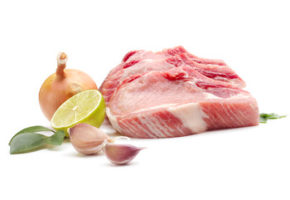 Boston butt, n.--A pork roast taken from the top of the shoulder of a hog. It's often used as a less-expensive substitute for ham, for which it serves reasonably well. However, Boston butt comes into its own as a meat for making sausages--notably firm, chunky ones like andouille. It's also the preferred cut for smoking slowly for many hours, resulting in pulled pork barbecue. It has enough fat and gelatinous tissue that it pulls easily away from the bones in moist shreds. The name comes from Revolutonary times, when butchers in Boston cut shoulders in a distinctive way, cured them, and packed them in ballers called "butts." Nobody in Boston recognizes the name, which has more currency in the South.
Boston butt, n.--A pork roast taken from the top of the shoulder of a hog. It's often used as a less-expensive substitute for ham, for which it serves reasonably well. However, Boston butt comes into its own as a meat for making sausages--notably firm, chunky ones like andouille. It's also the preferred cut for smoking slowly for many hours, resulting in pulled pork barbecue. It has enough fat and gelatinous tissue that it pulls easily away from the bones in moist shreds. The name comes from Revolutonary times, when butchers in Boston cut shoulders in a distinctive way, cured them, and packed them in ballers called "butts." Nobody in Boston recognizes the name, which has more currency in the South.
Eating Across America
This would be a good candidate for National Potato Day if that weren't already celebrated on October 27. Today in 1890, Idaho entered the Union. We like the potatoes from there, especially the russets, which make the best French fries.
Gourmet Gazetteer
Sweet Potato Knob is in extreme western West Virginia, ten miles from the Kentucky state line. It is a classic Appalachian knob of bare rock rising to 1143 feet. It's surrounded by woodlands. As is also the case in much of this part of the world, the nearest break in the woods is a strip mine for coal, about two miles away. This is wild countryside, ribboned with clearwater creeks. The nearest place to eat is nine miles up Highway 37 in Wayne: the well-named Pioneer Restaurant.
Deft Dining Rule #304
The only vegetable worth eating in the cheese-covered variety of the au gratin style is the potato.
Annals Of Fruit
Today in 1806, a large white strawberry from Chile was introduced in England. It was the forerunner of the strawberries we eat today, hybridized with the much smaller, much redder berries that had been cultivated from wild strawberries only a couple of centuries earlier. The process is still dynamic, as plant researchers continue their efforts to remove the last hints of flavor from strawberries so they look better and hold up longer on supermarket produce racks.
The Saints
Today is the feast day of St. Thomas the Apostle, the patron saint of doubters. Because of that (and perhaps because I am named for him), I think he should be the patron saint of restaurant critics. But the Vatican inexplicably has turned a deaf ear to my suggestion.
Food Namesakes
Soul singer Fontella Bass was born today in 1940. . . Michael Cole, who played a character on the Mod Squad, came in today in 1943. . . Henry Frederick Baker, a British geometer, postulated himself today in 1866.
Words To Eat By
The following are all from the pen of M.F.K. Fisher, born today in 1908: "It seems to me that our three basic needs, for food and security and love, are so mixed and mingled and entwined that we cannot straightly think of one without the others. So it happens that when I write of hunger, I am really writing about love and the hunger for it, and warmth and the love of it and the hunger for it--and then the warmth and richness and fine reality of hunger satisfied--and it is all one." "A complete lack of caution is perhaps one of the true signs of a real gourmet: he has no need for it, being filled as he is with a God-given and intelligently self-cultivated sense of gastronomical freedom." "Almost every person has something secret he likes to eat." "Between the ages of twenty and fifty, John Doe spends some twenty thousand hours chewing and swallowing food, more than eight hundred days and nights of steady eating. The mere contemplation of this fact is upsetting enough." "First we eat, then we do everything else."
Words To Drink By
"Licker talks mighty loud w'en it git loose fum de jug."--Uncle Remus, written by Joel Chandler Harris, who died today in 1908.
[divider type=""]

Cheese Is All-Natural.
But there are some funny things out there in nature.Click here for the cartoon.
[divider type=""] ####
Greg Picolo's Frog Legs Grillades
Many good recipes combine two elements that don't seem to belong together. This is one of them. The meaty part of the classic Creole breakfast dish grillades and grits is usually veal or beef chuck, a far cry from frog's legs. And yet, the idea works. Chef Greg Picolo developed this during his long tenure in the kitchen of the Bistro at the Maison de Ville. He brought it with him when he showed up at Redemption in 2011. The hard part of the dish is finding frog legs. Either the large ones (the size of chicken wings) or the small ones will work. So will, come to think of it, chicken wings. Or duck wings. Or whole quail. [caption id="attachment_55186" align="alignnone" width="480"]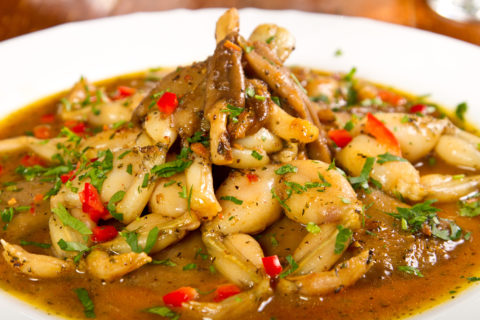 Creole grillades of frog legs, with grits on the side.[/caption]
There is a long-running controversy as to whether the grillades (whatever they're made of) should be served on top of the grits or on the side. Chef Greg says the former, I say the latter. You can compromise, as I do here. Greg usually serves this with poached eggs, but when I cooked it I used my mother's unique approach to grits: with beaten eggs stirred in already. (I still eat grits that way.)
Creole grillades of frog legs, with grits on the side.[/caption]
There is a long-running controversy as to whether the grillades (whatever they're made of) should be served on top of the grits or on the side. Chef Greg says the former, I say the latter. You can compromise, as I do here. Greg usually serves this with poached eggs, but when I cooked it I used my mother's unique approach to grits: with beaten eggs stirred in already. (I still eat grits that way.)
- Frog legs and sauce:
- 1 cup flour
- 1 Tbs. salt
- 1/2 tsp. black pepper
- 1/4 cup peanut oil
- 18 large or 24 small (preferred) frog legs per person
- 2 large yellow onions, chopped brunoise (small dice, by hand)
- 1 ripe green bell pepper, chopped brunoise
- 2 ribs celery, chopped brunoise
- 3 cloves minced garlic
- 3 cups rich chicken or veal stock or (better) 2 cups veal demi-glace
- 1 Tbs. tamarind concentrate, Pickapeppa, or Tabasco Caribbean-style steak sauce
- 3 Tbs. light soy sauce
- 2 large ripe tomatoes, peeled, pulp and seeds removed, chopped
- 2 tsp. parsley, stems and leaves, chopped
- Grits and eggs:
- 3 cups stone-ground grits (uncooked)
- 8 strips thick, smoked bacon
- 8 large eggs, beaten
- 1 cup shredded cheddar or jack cheese
Frog legs and sauce:
1. Combine the flour, salt and pepper in a small bowl, and dust (don't dredge) the frog legs in the mixture.
2. In a large skillet over medium heat, heat the oil until it shimmers, then lightly brown the frog legs. Add more oil, a tablespoon at a time, if necessary. Remove the frog legs from the pan as soon as they're browned on both sides.
3. Pour off all but about two Tbs. of oil from the pan. Add the onions, celery and bell pepper and cook until the onions just begin to brown. Add the garlic and cook another minute.
4. Add the stock or the demi-glace, the tamarind (or Pickapeppa or Tabasco Caribbean steak sauce), soy sauce, tomatoes, and the parsley. Bring to a light boil, then reduce to a simmer. Let it go for fifteen to twenty minutes, but move on before the mixture begins to turn dry. (It should be quite juicy, but not sloshy.)
5. Place the frog legs atop the pan contents and let them steam in the pan's sauce for about ten minutes--longer if you're using the big bullfrog legs. (For chicken or duck, it will take longer still.)
Grits and eggs:
1. Cook the grits according to the instructions on the bag. In the meantime, fry the bacon crisp, then crumble it.
2. Stir the beaten eggs into the hot grits until they disappear. Stir in the cheese and crumbled bacon.
3. Spoon the grits onto one side of the plate. Spoon the sauce and the frog leg's so that they overlap the grits. Serve with hot biscuits on the side.
Serves six to eight. [divider type=""] Lasagna @ Katie's
Lasagna @ Katie's
Through most of recorded history, lasagna was made in a large baking dish, the better for the sheets of pasta, layers and cheese and meat, and flowing tomato sauce to bake to lusciousness. The problem with this for restaurants is that a large number of orders must be made at one time, and held until an order for lasagna comes in. Katie's got around this by buying small casseroles (or large ramekins--they're about the size of soufflee dishes). The standards lasagna ingredients are stacked in it, and not baked until ordered. Because of the small size, these can be baked to order, coming out rich and bubbly and nicely encrusted at the top layer.
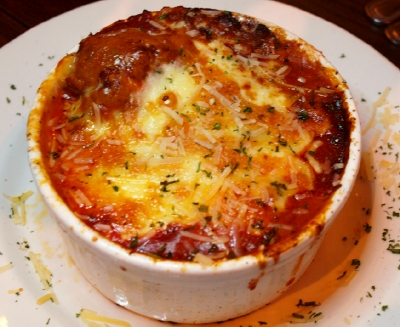
Katie's. Mid-City: 3701 Iberville. 504-488-6582.
This is among the 500 best dishes in New Orleans area restaurants. Click here for a list of the other 499. [divider type=""] July 5, 2017
July 5, 2017
Days Until. . .
Satchmo Summer Fest 30
Annals Of Manufactured Foods
Today is the birthday, in 1937, of Spam. It a new name for an existing product called "Spiced Ham." The change increased sales tremendously. Spiced ham more or less describes what it is, if you stretch the definition of ham to include pork shoulder. Spam is reviled by most serious eaters, but it's not all that terrible, if compared with real horrors like potted meat. Cookbooks have been written about Spam, and dishes made with it can actually taste pretty good. (It's not far different from that ham sausage you see on Vietnamese banh mi sandwiches.) Try a Spam and cheese omelette sometime. Spam paradise is Hawaii, where Spam experienced a cult popularity in the 1970s after Monty Python performed a funny song about the stuff. It later expanded into the hit Broadway musical Spamalot. How the word spam came to mean junk e-mail is not known.
Food Calendar
 I suppose the above ought to make today National Spam Day, but it doesn't. It's National Apple Turnover Day. The great advance in the popularization of apple turnovers came when somebody made them using a very light batter-like coating instead of pie crust, and fried them. The best-known such item is the apple pie at McDonald's, but such oblong pies were around before Mickey D's made them. Hot out of the fryer, they're hard to resist. The most famous apple turnover in New Orleans is the dreadful, heavy-crusted, overly sweet Hubig's Apple Delight. It is nevertheless honored as an icon, which goes to show our taste isn't perfect.
I suppose the above ought to make today National Spam Day, but it doesn't. It's National Apple Turnover Day. The great advance in the popularization of apple turnovers came when somebody made them using a very light batter-like coating instead of pie crust, and fried them. The best-known such item is the apple pie at McDonald's, but such oblong pies were around before Mickey D's made them. Hot out of the fryer, they're hard to resist. The most famous apple turnover in New Orleans is the dreadful, heavy-crusted, overly sweet Hubig's Apple Delight. It is nevertheless honored as an icon, which goes to show our taste isn't perfect.
Annals Of Eating Healthy
Sylvester Graham was born in Connecticut today in 1795. He was an early believer that unrefined food is the best food. He created a brown flour with more wheat hulls and than flour typically contained back then. It became known as Graham flour, but he's better known for the molasses-sweetened crackers made from his flour, still called Graham crackers.
Deft Dining Rule #706
When you're offered a choice, go for the toast with the biggest seeds in it. And get a slice of white toast too, and study the widely disparate pleasures.
Gourmet Gazetteer
Bacon, Missouri is a cluster of farmhouses in the fields just west of the state capital, Jefferson City, twenty-five miles away. It gets a bit of traffic because the highway crosses a small tributary of the Missouri River, which runs just a few miles from Bacon. The newarest restaurant is the Jamestown Cafe in the town of the same name, about five miles away. They serve breakfast, so bacon will certainly be found.
Annals Of Food Research
John Howard Northrop was born today in 1891. His main research subjects were enzymes, whose action in digesting food was not well known. One of his discoveries was that pepsin--an enzyme in your stomach that digests much of what you eat--could be crystallized. For a time (but not now), pepsin was an ingredient in Beemans Chewing Gum. ("Aids Digestion," said the package.)
Food On The Air
Today in 1948, Jell-O sponsored the first episode of "a gay new comedy series" called My Favorite Husband. Lucille Ball was the star, in a show about "two married people who live together, and like it." It was such a hit that it evolved into I Love Lucy on television. Lucy began each show by saying, "Jell-O, everyone!"
Food Namesakes
Actor Warren Oates had the Big Slate snap today in 1928. . . Goose Gossage, long-time big-league all-star pitcher, was born today in 1951. . . Thomas Cook, who invented the travel agency, organized his first tour today in 1841. . . Today in 1991, Lillian Cucuzza won the contest to name the new Florida Marlins baseball team. . . Robert Bacon, Secretary of State under Theodore Roosevelt, was born today in 1860.
Edible Dictionary
mirepoix, [meer-ih-PWAH], French, n.--A mixture of finely diced onions, carrots, celery, and the like. It's added to stocks and roasting meat juices in the making of certain sauces, especially brown sauces for meats. After cooking with the other ingredients for awhile, the vegetables almost melt into the liquid part of the sauce ingredients, lending flavor, texture and (from the carrots) color. In meat sauces, sometimes cured ham or bacon are added.
Words To Eat By
"The real fact is that I could no longer stand their eternal cold mutton."--Cecil Rhodes, for whom Rhodesia (now Zimbabwe) was named, explaining why he left England for Africa. He was born today in 1853.
Words To Drink By
Who'd care to be a bee and sip
Sweet honey from the flower's lip
When he might be a fly and steer
Head first into a can of beer?--
Anonymous.
[divider type=""]
 [title type="h2"]The Sunset Limited, New Orleans, Los Angeles and San Francisco, June 19-28, 2017.[/title]
During two recent weeks I was on vacation in Los Angeles and San Francisco. To and from home, I traveled by rail on the Sunset Limited train, whose route passed through the heart of the American Southwest, a place I love. I kept my Dining Diary rigorously while on the road. That will explain why you haven't received the New Orleans Menu Daily. I was writing like crazy, but couldn't put it out on the web.
Part Two of that reportage begins as I'm awakened from my sleep in Sleeping Car, Roomette #7. I am traveling feet forward and listening to some old recordings of music from the 1940s. I fell asleep around ten in the evening, then went back to sleep and into the next day easily.
Tuesday, June 20, 2017, 12:55 a.m.--I awaken to more racket, and voices that talk of moving to another train. I know very well that is not what will happen, but in my dreams I imagine that I will be left alone here in the middle of the night. I allow crazy ideas like this to form in my mind entirely too often. I manage to get right back to sleep when I hear two beeps of the locomotive's horn, signifying our departure from San Antonio after several hours there.
6:43 a.m.--The nightmares end when I get up for good at my usual time. We are in Del Rio, Texas, a town of substantial size right on the U.S.-Mexico border. I have never seen Del Rio from a train, even though all dozen or so times I've traveled the Sunset Limited I've passed through the town. The train stays in the small station only briefly.
7:15 a.m.--I make my way to the dining room for breakfast, in which I shared a table with a woman from the coach car. She is in the business of verifying real estate titles, many of which involve mineral rights. We soon move to other topics, one of which is the forbidding terrain. The hills are emphatic in their control of the land, which they share with the distinctive flora of the desert Southwest.
A plant that you see only here is the ocotillo. In dry weather, it looks like tall clusters of dead sticks shoved into the ground by some obsessive maniac. If rain falls, the plant pops out leaves and--if there's a good bit of rain--red flowers. Those and those large assortment of cactus, yucca, and agaves cover only a third or less of the ground. It is desolate, to put it mildly--but it's also something to see.
The most dramatic locale is the Pecos River, which cuts a deep gash into the parched limestone and fills it with water. What an obstacle this must have been for anyone looking for a place to set up shop hundreds of years ago!
7:26 a.m.-- I remain spellbound by all this desert, whose appeal to me is both intrinsic and happenstance. I know the lay of the land along US 90 very well. But a lot of the train route shows me the other side of the numerous--and in some cases amazing--mountain ranges. They aren't familiar, as many times as I've come this way. For almost all previous rides, I was on the south side of US 90, the main road through here. This time I'm on the north side. When we arrive in Alpine, Texas--the biggest town since we left Del Rio--I found the territory unrecognizable.
In Alpine--a hip, cool town by the measures of Big Bend country--the train stops for a crew change. And to and to let smokers relieve their needs for coffin nails. In the meantime the train gets serviced. They allow passengers to get off and walk around a bit. If there's really a lot of time (and there usually isn't), a bold passenger can walk around a little. Charming little place, and one of the main entrances to Big Bend National Park, where I have hiked many times since the 1970s.
1:30 p.m.--During lunch, groves of pecan trees alongside the tracks. This is something new. The trees grow in a very arid area. We will see many miles of these trees between here and El Paso.
I talk about the pecans with the lady who joins me for lunch in the diner. Lunch is being served in Mountain Time, so we it comes an hour later than we expected as the salads come rolling out. In addition to the lettuces we have the same green lima beans and corn as last time.
2:18 p.m.--The train takes a long time in El Paso, then swings into New Mexico to make stops in three minor towns. Then it crosses into Arizona, where the most important stops are Tucson and a suburb of Phoenix. The latter no longer has a mainline connection with the UP, so it's a new vista for me.
But before we get to either of those stops, we pause at Benson, Arizona. I see no visual or other reference to Tom Benson, although this might be a good place for a winter camp for the Saints. Not far from Benson, the train engineer got an off-standard reading from his wheels, something that trains constantly check on the road. We pull off the main to check this out. It's decided that the wheels and axles need to cool off. They do this by slowing down, then slowly picking up speed. Fortunately, the sun is heading downward, the the train can safely pick up speed as it rolls toward Tucson and beyond.
5:03 p.m.--Afternoon nap. Afterwards, I turn my attention to editing this department. I am reminded that the motion on a train makes for many typos. What's more, I am far behind in turning notes into prose.
7:30 p.m.--Dinner with an elderly couple. He says prayers as the first food appears. No further devotions are made. I learn that they do a good deal of Amtrak travel, which they enjoy. They turn out to be the most convivial dining companions I will have on the train. Which is saying something. I find most people I meet on trains to be interesting.
The waiter tells me that the roasted chicken with a thyme and pepper sauce is a better dish than the chicken with a ring of French cookery. But he also tells me that Amtrak is in a good phase in which the fullly-equipped kitchen is plied by actual cooks. Perhaps we can even call them chefs. The chicken is indeed good. It comes with another wave of the unavoidable green beans and corn, with rice.
10:05 p.m.--It's too early for bed, but there's not much else to do. The train makes a number of stops as it aims form Los Angeles. Palm Springs, for example. Yuma. Ontario. Pomona. This was Frank Sinatra's realm during the 1950s.
The towns seem deserted, suggesting that we are approaching the end of the Sunset Route faster than we really are. Neighborhoods glow with ghostly lights that come and go as we keep rolling, ever more slowly. At least twice, I see eerie, fuzzy lights in the distance or right next to the train. I got up a few times to find out what was going on, and found nobody and nothing. The mystery is dissolved when I return home and look out my bedroom window with my glasses off. It's the same fuzzy-light vista.
The attendant in the sleeper, who has proven to be a great help all along, reassures me that he will let me know when it's time to get out of bed. And that there's yet a long while to go. I move in and out of sleep with a puzzling anxiety. I have covered over 100,000 miles on trains, and know that I will not be left behind without luggage, cash, or sense of direction. But I still consider the possibility. I should have had a martini eight hours ago.
Wednesday, June 21, 2017, 4:55 a.m. I notice other passengers trying to dope out the strange lights that seem to drift by in the deep darkness every minute or so. It reaches a point where everybody seems to be standing around the stairs leading to the bottom level of the train. Sooner or later, we all make it out trackside, and the sleeper attendant points the way out, and tells me where to find a shuttle that will will take me and my luggage to the first-class lounge in the terminal. The outbound half of this trip aboard the Sunset Limited has ended, this time for real.
7:08 a.m.--Mary Ann has been in Los Angeles for a few days at the home of our son Jude, his wife Suzanne and their son (and our grandson) Jackson. She and I both know that quiet must reign in that house for a couple more hours yet. I just park myself in the First Class lounge, where I can have coffee and juices and bad pastries. I also get worked up by television reports of tropical storms that might be heading toward New Orleans, perhaps with flooding.
8:45 a.m.--MA picks me up in front of Los Angeles's Central Railroad Terminal. This is the train station you always see in movies made in the 1940s, when everybody traveled by train.
MA knows her way around Los Angeles--she visits here often--so she jumps right onto US 101, a freeway that takes us to Jude & Suzanne's family residence. There I see my grandson for the first time in eight months. Since then he has not only learned to walk, but also to run, which he does constantly. He's also learned a surprisingly good vocabulary.
I had been worried that, since our meetings have been so few, Jackson would not recognize me or trust me. This proved wonderfully false. He and I got along very well, playing with his toys endlessly and staying close behind him during his many and rapid forays. He reminds me a lot of his father. When Jude was Jackson's age he would blast off long distances in search of anything he found interesting. "Where's Jude" is still the most-used phrase in our family.
We have breakfast in the well-designed open kitchen. Jude makes his smooth omelettes for anyone who wants one. Nobody could be more eager than little Jackson, who during my visit never left a scrap of scrambled eggs uneaten. He likes just about every other food that comes his way, notably oatmeal, blueberries, raspberries, and any other red fruit.
Jude has a full day of work before him. Suzanne also works full time, and today she will leave for San Francisco, there to attend a seminar. She leaves the care of Jackson to Mary Ann and the longtime family nanny. There could hardly be better caretakers than those two, both of whom go far beyond changing diapers to entertaining constant play and reading with Jackson. Lucky boy.
1:36 p.m.--Jude picks me up for lunch in a downtown eatery called Otium. It's a wide open space near what he tells me will be a very expensive sub-surface extension of the BART transit operation. The current name--"The Hole" doesn't sound promising.
The clientele in Otium is young and well-groomed by the standards of the times on the West Coast. The women strike me as underdressed. Not in terms of fashion statements, but by square-inches of skin coverage. (I have been told that I have a poor sense of these matters.) The men, on the other hand, are over-bearded. (I have worn a beard since 1972.) All this is true both of the people who dine and those who serve in the restaurants.
Our waiter has a bearded neck, and certainly isn't the only one. He also knows the menu and makes intelligent suggestions. I start with a half-dozen Blue Point raw oysters. But those come from the Atlantic, specifically off Long Island. What are they doing here? They're tasty enough, though, with a shallot mignonette finishing their elegance. The menu at first seemed to be about Middle Eastern food, but the more I read the more Italian it seemed. We wound up with rigatone with an assortment of peppers and guanciale (hog jowls) and fettuccine with wild mushroms, spinach and egg yolks. And we had an order of falafel towards the end.
During our lunch Jude unveils some ideas about how he might get involved in the New Orleans Menu. He already helps me out with the technology of the newsletter, in which his skills greatly exceed mine. MA sometimes suggests that I might be ready for retirement, but I don't see that, let alone expect it anytime soon. That said, this sordid matter is something that probably needs to be addressed at some point.
6:14 p.m.--The first night we spend with JS&J (as they will henceforth be known in this journal), Jude tells me that I created great demand for pasta with pesto the last time I visited them. I am directed to repeat this success tonight, because the herb garden that JS&J grew in their back yard produced a nice crop of fresh basil. Jackson is especially tickled by this effort and the fun of watering the basil it every day. The minions are sent to the supermarket to pick up the other ingredients. We still are left with not quite enough butter, but I make do. I remember the batch that inspired all this months ago, and I'd say this one was not quite as good. But from the littlest to the biggest, everybody loves this batch of pesto with fettuccine. A good first impression for me to have made with my hosts.
[divider type=""]
[title type="h2"]The Sunset Limited, New Orleans, Los Angeles and San Francisco, June 19-28, 2017.[/title]
During two recent weeks I was on vacation in Los Angeles and San Francisco. To and from home, I traveled by rail on the Sunset Limited train, whose route passed through the heart of the American Southwest, a place I love. I kept my Dining Diary rigorously while on the road. That will explain why you haven't received the New Orleans Menu Daily. I was writing like crazy, but couldn't put it out on the web.
Part Two of that reportage begins as I'm awakened from my sleep in Sleeping Car, Roomette #7. I am traveling feet forward and listening to some old recordings of music from the 1940s. I fell asleep around ten in the evening, then went back to sleep and into the next day easily.
Tuesday, June 20, 2017, 12:55 a.m.--I awaken to more racket, and voices that talk of moving to another train. I know very well that is not what will happen, but in my dreams I imagine that I will be left alone here in the middle of the night. I allow crazy ideas like this to form in my mind entirely too often. I manage to get right back to sleep when I hear two beeps of the locomotive's horn, signifying our departure from San Antonio after several hours there.
6:43 a.m.--The nightmares end when I get up for good at my usual time. We are in Del Rio, Texas, a town of substantial size right on the U.S.-Mexico border. I have never seen Del Rio from a train, even though all dozen or so times I've traveled the Sunset Limited I've passed through the town. The train stays in the small station only briefly.
7:15 a.m.--I make my way to the dining room for breakfast, in which I shared a table with a woman from the coach car. She is in the business of verifying real estate titles, many of which involve mineral rights. We soon move to other topics, one of which is the forbidding terrain. The hills are emphatic in their control of the land, which they share with the distinctive flora of the desert Southwest.
A plant that you see only here is the ocotillo. In dry weather, it looks like tall clusters of dead sticks shoved into the ground by some obsessive maniac. If rain falls, the plant pops out leaves and--if there's a good bit of rain--red flowers. Those and those large assortment of cactus, yucca, and agaves cover only a third or less of the ground. It is desolate, to put it mildly--but it's also something to see.
The most dramatic locale is the Pecos River, which cuts a deep gash into the parched limestone and fills it with water. What an obstacle this must have been for anyone looking for a place to set up shop hundreds of years ago!
7:26 a.m.-- I remain spellbound by all this desert, whose appeal to me is both intrinsic and happenstance. I know the lay of the land along US 90 very well. But a lot of the train route shows me the other side of the numerous--and in some cases amazing--mountain ranges. They aren't familiar, as many times as I've come this way. For almost all previous rides, I was on the south side of US 90, the main road through here. This time I'm on the north side. When we arrive in Alpine, Texas--the biggest town since we left Del Rio--I found the territory unrecognizable.
In Alpine--a hip, cool town by the measures of Big Bend country--the train stops for a crew change. And to and to let smokers relieve their needs for coffin nails. In the meantime the train gets serviced. They allow passengers to get off and walk around a bit. If there's really a lot of time (and there usually isn't), a bold passenger can walk around a little. Charming little place, and one of the main entrances to Big Bend National Park, where I have hiked many times since the 1970s.
1:30 p.m.--During lunch, groves of pecan trees alongside the tracks. This is something new. The trees grow in a very arid area. We will see many miles of these trees between here and El Paso.
I talk about the pecans with the lady who joins me for lunch in the diner. Lunch is being served in Mountain Time, so we it comes an hour later than we expected as the salads come rolling out. In addition to the lettuces we have the same green lima beans and corn as last time.
2:18 p.m.--The train takes a long time in El Paso, then swings into New Mexico to make stops in three minor towns. Then it crosses into Arizona, where the most important stops are Tucson and a suburb of Phoenix. The latter no longer has a mainline connection with the UP, so it's a new vista for me.
But before we get to either of those stops, we pause at Benson, Arizona. I see no visual or other reference to Tom Benson, although this might be a good place for a winter camp for the Saints. Not far from Benson, the train engineer got an off-standard reading from his wheels, something that trains constantly check on the road. We pull off the main to check this out. It's decided that the wheels and axles need to cool off. They do this by slowing down, then slowly picking up speed. Fortunately, the sun is heading downward, the the train can safely pick up speed as it rolls toward Tucson and beyond.
5:03 p.m.--Afternoon nap. Afterwards, I turn my attention to editing this department. I am reminded that the motion on a train makes for many typos. What's more, I am far behind in turning notes into prose.
7:30 p.m.--Dinner with an elderly couple. He says prayers as the first food appears. No further devotions are made. I learn that they do a good deal of Amtrak travel, which they enjoy. They turn out to be the most convivial dining companions I will have on the train. Which is saying something. I find most people I meet on trains to be interesting.
The waiter tells me that the roasted chicken with a thyme and pepper sauce is a better dish than the chicken with a ring of French cookery. But he also tells me that Amtrak is in a good phase in which the fullly-equipped kitchen is plied by actual cooks. Perhaps we can even call them chefs. The chicken is indeed good. It comes with another wave of the unavoidable green beans and corn, with rice.
10:05 p.m.--It's too early for bed, but there's not much else to do. The train makes a number of stops as it aims form Los Angeles. Palm Springs, for example. Yuma. Ontario. Pomona. This was Frank Sinatra's realm during the 1950s.
The towns seem deserted, suggesting that we are approaching the end of the Sunset Route faster than we really are. Neighborhoods glow with ghostly lights that come and go as we keep rolling, ever more slowly. At least twice, I see eerie, fuzzy lights in the distance or right next to the train. I got up a few times to find out what was going on, and found nobody and nothing. The mystery is dissolved when I return home and look out my bedroom window with my glasses off. It's the same fuzzy-light vista.
The attendant in the sleeper, who has proven to be a great help all along, reassures me that he will let me know when it's time to get out of bed. And that there's yet a long while to go. I move in and out of sleep with a puzzling anxiety. I have covered over 100,000 miles on trains, and know that I will not be left behind without luggage, cash, or sense of direction. But I still consider the possibility. I should have had a martini eight hours ago.
Wednesday, June 21, 2017, 4:55 a.m. I notice other passengers trying to dope out the strange lights that seem to drift by in the deep darkness every minute or so. It reaches a point where everybody seems to be standing around the stairs leading to the bottom level of the train. Sooner or later, we all make it out trackside, and the sleeper attendant points the way out, and tells me where to find a shuttle that will will take me and my luggage to the first-class lounge in the terminal. The outbound half of this trip aboard the Sunset Limited has ended, this time for real.
7:08 a.m.--Mary Ann has been in Los Angeles for a few days at the home of our son Jude, his wife Suzanne and their son (and our grandson) Jackson. She and I both know that quiet must reign in that house for a couple more hours yet. I just park myself in the First Class lounge, where I can have coffee and juices and bad pastries. I also get worked up by television reports of tropical storms that might be heading toward New Orleans, perhaps with flooding.
8:45 a.m.--MA picks me up in front of Los Angeles's Central Railroad Terminal. This is the train station you always see in movies made in the 1940s, when everybody traveled by train.
MA knows her way around Los Angeles--she visits here often--so she jumps right onto US 101, a freeway that takes us to Jude & Suzanne's family residence. There I see my grandson for the first time in eight months. Since then he has not only learned to walk, but also to run, which he does constantly. He's also learned a surprisingly good vocabulary.
I had been worried that, since our meetings have been so few, Jackson would not recognize me or trust me. This proved wonderfully false. He and I got along very well, playing with his toys endlessly and staying close behind him during his many and rapid forays. He reminds me a lot of his father. When Jude was Jackson's age he would blast off long distances in search of anything he found interesting. "Where's Jude" is still the most-used phrase in our family.
We have breakfast in the well-designed open kitchen. Jude makes his smooth omelettes for anyone who wants one. Nobody could be more eager than little Jackson, who during my visit never left a scrap of scrambled eggs uneaten. He likes just about every other food that comes his way, notably oatmeal, blueberries, raspberries, and any other red fruit.
Jude has a full day of work before him. Suzanne also works full time, and today she will leave for San Francisco, there to attend a seminar. She leaves the care of Jackson to Mary Ann and the longtime family nanny. There could hardly be better caretakers than those two, both of whom go far beyond changing diapers to entertaining constant play and reading with Jackson. Lucky boy.
1:36 p.m.--Jude picks me up for lunch in a downtown eatery called Otium. It's a wide open space near what he tells me will be a very expensive sub-surface extension of the BART transit operation. The current name--"The Hole" doesn't sound promising.
The clientele in Otium is young and well-groomed by the standards of the times on the West Coast. The women strike me as underdressed. Not in terms of fashion statements, but by square-inches of skin coverage. (I have been told that I have a poor sense of these matters.) The men, on the other hand, are over-bearded. (I have worn a beard since 1972.) All this is true both of the people who dine and those who serve in the restaurants.
Our waiter has a bearded neck, and certainly isn't the only one. He also knows the menu and makes intelligent suggestions. I start with a half-dozen Blue Point raw oysters. But those come from the Atlantic, specifically off Long Island. What are they doing here? They're tasty enough, though, with a shallot mignonette finishing their elegance. The menu at first seemed to be about Middle Eastern food, but the more I read the more Italian it seemed. We wound up with rigatone with an assortment of peppers and guanciale (hog jowls) and fettuccine with wild mushroms, spinach and egg yolks. And we had an order of falafel towards the end.
During our lunch Jude unveils some ideas about how he might get involved in the New Orleans Menu. He already helps me out with the technology of the newsletter, in which his skills greatly exceed mine. MA sometimes suggests that I might be ready for retirement, but I don't see that, let alone expect it anytime soon. That said, this sordid matter is something that probably needs to be addressed at some point.
6:14 p.m.--The first night we spend with JS&J (as they will henceforth be known in this journal), Jude tells me that I created great demand for pasta with pesto the last time I visited them. I am directed to repeat this success tonight, because the herb garden that JS&J grew in their back yard produced a nice crop of fresh basil. Jackson is especially tickled by this effort and the fun of watering the basil it every day. The minions are sent to the supermarket to pick up the other ingredients. We still are left with not quite enough butter, but I make do. I remember the batch that inspired all this months ago, and I'd say this one was not quite as good. But from the littlest to the biggest, everybody loves this batch of pesto with fettuccine. A good first impression for me to have made with my hosts.
[divider type=""]

A Study Of Arugula.
But before we get started, let's note that one of the other names for arugula is "rouquette," or as it's spelled in English, "rocket."Click here for the cartoon.
[divider type=""] ### Sunday, July 16, 2017. Trimming.
I grab my big pipe wrench and bend the metal back from the clipping shield blades in my tractor/mower. The blades seem to be out of the way of the shield, but I don't have time to check it out--it's radio showtime. Just two hours on the air today, and the audience seems to be aloof.
Even though the sun is beaming down hard upon me, there is enough chance of rain for me not to risk waiting until the heat dwindles a bit. The last few days have brought heatstroke weather.
The mower works fine. A wheel occasionally falls into the many big holes in the lawn, but only two of these incidents bring me to the brink of getting stuck in the hole. I wind up trimming all the acreage between the gravel road and the Cool Water Ranch House. But those holes really throw me around. The grass was so high that I failed to see the holes until it was too late to avoid them. Despite all that, I wind up with the second full lawnmowing this season accomplished.
Mary Ann declares her appetite for dinner. We go to Zea for the first time in many weeks. Zea somehow lives without our former regularity as patrons. Meanwhile, the Taste Buds have closed down their most recent concept Mizado. The restaurant at the corner of Metairie and the I-10 will become a Zea in the next couple of months. The effort to reinvent Mexican cookery in our area continues to be less than successful. Johnny Sanchez seems to be making progress in one sense, and lowering its creative aims at the same time. Where, for example, is the molé poblano? I mean, other than as a daily special?
Back at Zea, I return to my favorites: the tomato-basil bisque, the crab cakes, and ice cream for dessert.
Yes, it was a rather dull weekend.
Monday, July 17, 2017. Chinese Cooking, Old Style.
I can't remember how long it's been since the Egg Roll House opened a block or two from Lakeside Mall. So I asked the owners, who was the guest in our three-o'clock hour of the radio show. He says that the restaurant has been there since 1983. That is quite a long time for a place that started out as a doughnut shop, then a basic drive-through Chinese place, and later (but at least twenty years ago) a place where you can eat sushi. Indeed, for many years people often called to tell me that the best sushi in town was to be had at the Egg Roll House. I tried that a few times and found it better than I would have guessed, but not exceptional. This was also true of the Chinese cooking, but the main goal of the place is clear: to serve inexpensive basic Chinese-American dishes at a low price in large portions. You know what you have when the most popular dish in the house is combination fried rice.
But what a location!
I hosted this show from the Cool Water Ranch as I usually do on Monday, even though. NPAS has not begun its schedule of rehearsals yet, and I could go into town if necessary. The truth is, I'd rather be singing.
Sunday, July 16, 2017. Trimming.
I grab my big pipe wrench and bend the metal back from the clipping shield blades in my tractor/mower. The blades seem to be out of the way of the shield, but I don't have time to check it out--it's radio showtime. Just two hours on the air today, and the audience seems to be aloof.
Even though the sun is beaming down hard upon me, there is enough chance of rain for me not to risk waiting until the heat dwindles a bit. The last few days have brought heatstroke weather.
The mower works fine. A wheel occasionally falls into the many big holes in the lawn, but only two of these incidents bring me to the brink of getting stuck in the hole. I wind up trimming all the acreage between the gravel road and the Cool Water Ranch House. But those holes really throw me around. The grass was so high that I failed to see the holes until it was too late to avoid them. Despite all that, I wind up with the second full lawnmowing this season accomplished.
Mary Ann declares her appetite for dinner. We go to Zea for the first time in many weeks. Zea somehow lives without our former regularity as patrons. Meanwhile, the Taste Buds have closed down their most recent concept Mizado. The restaurant at the corner of Metairie and the I-10 will become a Zea in the next couple of months. The effort to reinvent Mexican cookery in our area continues to be less than successful. Johnny Sanchez seems to be making progress in one sense, and lowering its creative aims at the same time. Where, for example, is the molé poblano? I mean, other than as a daily special?
Back at Zea, I return to my favorites: the tomato-basil bisque, the crab cakes, and ice cream for dessert.
Yes, it was a rather dull weekend.
Monday, July 17, 2017. Chinese Cooking, Old Style.
I can't remember how long it's been since the Egg Roll House opened a block or two from Lakeside Mall. So I asked the owners, who was the guest in our three-o'clock hour of the radio show. He says that the restaurant has been there since 1983. That is quite a long time for a place that started out as a doughnut shop, then a basic drive-through Chinese place, and later (but at least twenty years ago) a place where you can eat sushi. Indeed, for many years people often called to tell me that the best sushi in town was to be had at the Egg Roll House. I tried that a few times and found it better than I would have guessed, but not exceptional. This was also true of the Chinese cooking, but the main goal of the place is clear: to serve inexpensive basic Chinese-American dishes at a low price in large portions. You know what you have when the most popular dish in the house is combination fried rice.
But what a location!
I hosted this show from the Cool Water Ranch as I usually do on Monday, even though. NPAS has not begun its schedule of rehearsals yet, and I could go into town if necessary. The truth is, I'd rather be singing.